Paul van Yperen's Blog, page 27
January 10, 2025
Polonia
Polonia was a postcard editor in Krakow, Poland in the late 1920s and early 1930s. Polonia published sepia postcards of Polish film stars, but also of American, German and other foreign actors and actresses. Here is a selection of 20 Polonia postcards.
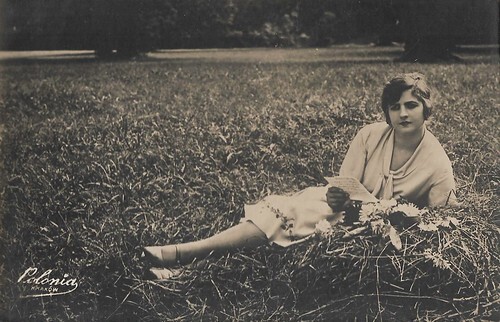
Polish postcard by Polonia, Krakow. Jadwiga Smosarska in Tredowata/The Leper (Boleslaw Mierzejewski, Edward Puchalski, 1927).
Jadwiga Smosarska (1898 -1971) was the biggest star of the Polish cinema of the pre-WWII era. From 1919 on, the Polish actress made more than 25 silent and sound films. She also was very successful on stage. When the Nazis invaded Poland in 1939, she fled to the US. In 1970, she returned to Poland.
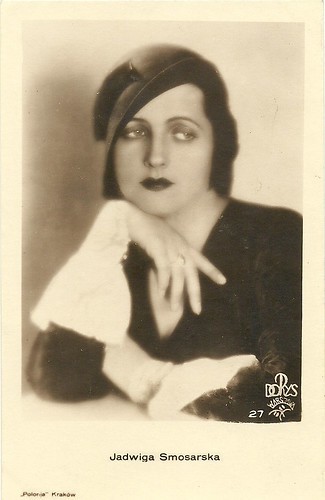
Polish postcard by Polonia, Krakòw, no. 27. Photo: Dorys, Warszawa (Warsaw). Collection: Didier Hanson.
Jadwiga Smosarska (1898-1971) was the biggest star of the Polish cinema of the pre-WWII era. From 1919 on, the Polish actress made more than 25 silent and sound films. She also was very successful on stage. When the Nazis invaded Poland in 1939, she fled to the US. In 1970, she returned to Poland.
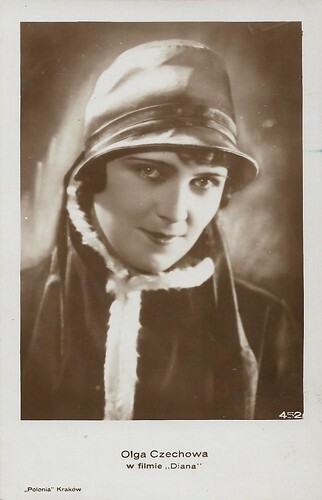
Polish postcard by Polonia, Krakow, no. 452. Photo: Bavaria Film. Olga Tschechowa in the German silent film Diane (Erich Waschneck, 1929).
Dignified German-Russian actress Olga Tschechowa (1897-1980) was one of the most popular stars of the silent film era. She remained a mysterious person throughout her life.

Polish postcard by Polonia, Krakow, no. 455. Marie Prevost in The Rush Hour (E. Mason Hopper, 1927).
Marie Prevost (1898-1937) was a Canadian-born, American silent screen actress. She was excellent in such comedies as Ernst Lubitsch's The Marriage Circle (1924). The end of her life was filled with tragedies.
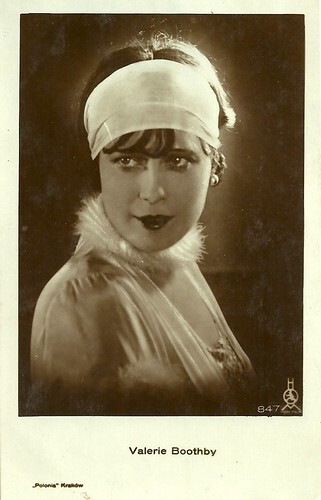
Polish postcard by Polonia, Krakow, no. 847. Photo: Hom Film. Valerie Boothby in Vererbte Triebe/Inherited Passions (Gustav Ucicky, 1929).
German actress Valerie Boothby (1906-1982) was a popular star of the Weimar cinema in the late 1920s and early 1930s.
One of the most modern rotogravure printing houses in Poland
There is little information on the web about Polonia. Happily, we could contact Polish postcard specialist Marcin Jaroszewicz who mailed us the following info: 'The Polonia Kraków Printing House was one of the most modern rotogravure printing houses in Poland. In addition to postcards, they printed leaflets and other materials, including film programs (a poorly researched topic, I saw 2 items).
Polonia was known for producing postcards. Film postcards were only part of the assortment (including art, monuments, Christmas, New Year, etc.). There is a problem with the numbers, probably all postcards were numbered continuously no matter what the subject was. For example, a Christmas postcard from 1935 had the number 985.
I could not find information about the beginnings of the company. The Polonia shareholders changed frequently. They were already operating in the early 1920s practically until 1939. After the outbreak of the war, the Germans took over the company and subordinated it to Ross Verlag, then already a Nazi-owned firm. After that, nothing was published as Polonia Kraków. After the war, the company did not resume operations; its assets were taken over by the state (like Ross Verlag in East Germany). After 1945, the company 'Film Polski' published postcards for a short time.
Several of Polonia Kraków's film postcards had poor sharpness and should not have been sold. Defective copies are common on the market. There are two hypotheses: either the company could not afford to recall them or the employees sold them unofficially. The first film postcards, although they were created in the 1920s, referred to postcards with theatre actors from the end of the 19th century and seemed outdated.
A postcard of a popular actor in the early 1930s cost 8 groszy, which was the cheapest cinema ticket. Sets of several postcards cost 20 groszy. The company focused on Polish stars. Famous actors like Jadwiga Smosarska , Eugeniusz Bodo and Adam Brodzisz cost more. The collections of the Cinematography Museum in Łódź are large with postcards by Polonia Kraków, Ross Verlag and others.' Ross Verlag Postcards offers an incomplete index of Polonia Kraków film postcards, focused on foreign actors.
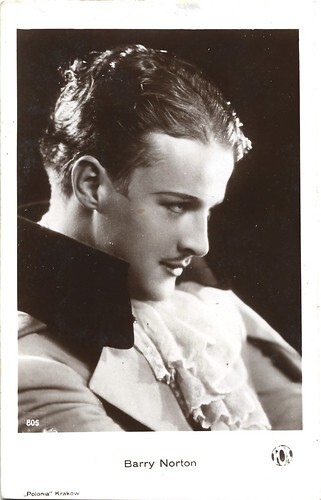
Polish postcard by Polonia, Krakow, no. 805. Photo: Fox Film.
Alfredo Carlos Birabén (1905-1956) was an Argentine actor, who had a Hollywood career under the stage name Barry Norton .
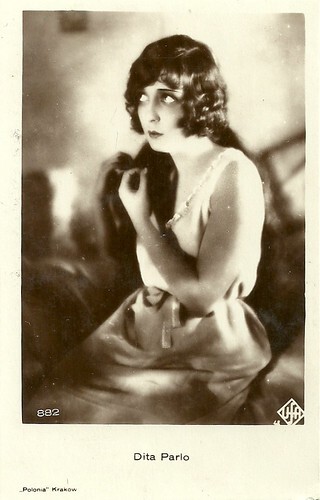
Polish postcard by Polonia, Krakow, no. 882. Photo: Ufa. Dita Parlo in Heimkehr/Homecoming (Joe May, 1928).
Dita Parlo (1908-1971) was a popular European film star in the late 1920s and early 1930s. She inspired both Dita Von Teese and Madonna, who used Parlo's name and character from L'Atalante (1934) for her controversial 'Sex' book and 'Erotica' album.
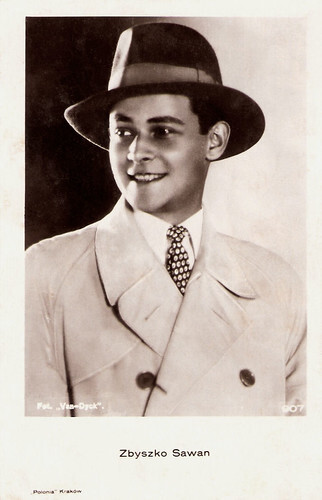
Polish postcard by Polonia, Kraków, no. 907. Photo: Van Dyck.
Polish actor Zbigniew Sawan (1904–1984) starred both in silent and sound films and was also a respected stage actor in his country. He also worked as a theatre director and manager.
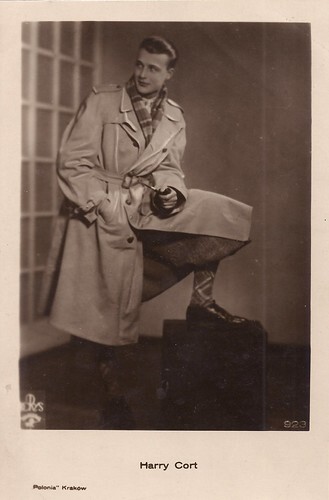
Polish postcard by Polonia, Krakow, no. 923. Collection: Joanna.
Polish actor Harry Cort (1905-?) came from a royal dynasty and had a short film career with starring roles in three silent films, 9:25. Przygoda jednej nocy/9:25. Adventure One Night (1929), Halka (1930) and Karuzela zycia/Carousel of Life (1930).
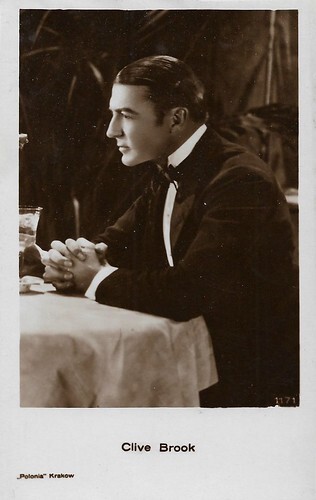
Polish postcard by Polonia, Krakow, no. 1171.
English film and stage actor Clive Brook (1887-1974) worked first in British films and then in Hollywood. The suave, handsome, distinguished leading man is best remembered as Marlene Dietrich’s love interest in Shanghai Express (1932).
Cinema in Poland before World War II
The history of cinema in Poland is almost as long as the history of cinematography. The first cinema was founded in Łódź in 1899 and by the end of the next decade, there were cinemas in almost every major town in Poland. Arguably the first Polish filmmaker was Kazimierz Prószyński, who filmed various short documentaries in Warsaw. He is credited as the author of the earliest surviving Polish documentary titled Ślizgawka w Łazienkach/Skating-rink in the Royal Baths, made between 1894 and 1896, as well as the first short narrative films Powrót birbanta/Rake's Return Home and Przygoda dorożkarza/Cabman's Adventure, both created in 1902.
The earliest surviving feature film is Pruska Kultura/Prussian Culture, produced in 1907 by Mordechaj Towbin. It was only rediscovered in 2000 in the French archive Bois D'Arcy. For censorship reasons - Poland was still occupied by Germany at the time - this film, which denounced the forced Germanisation and persecution of Polish children, could not be distributed in Poland and was sold abroad. Till 2000, the common assumption was that the comedy Antoś pierwszy raz w Warszawie/Antoś for the First Time in Warsaw (1908) started the Polish film industry. The film was directed by George Meyer (real name Joseph-Louis Mundwiller) and starred Antoni Fertner. Unfortunately, this film, which was immediately shown in Paris, is now considered lost forever. After 1908, Polish artists started experimenting with other genres of cinema. Władysław Starewicz made one of the first animated cartoons in the world - and the first to use the stop motion technique, Lucanus Cervus/Piękna Lukanida/Beautiful Lukanida. The film celebrated its premiere in Moscow in 1912.
Another key figure was Aleksander Hertz, a hugely influential producer. In 1906 he co-founded the Sfinks Motion Picture Theatre, which gave in 1909 its name to Poland's first real film production studio. Hertz was a successful director and ‘discoverer’ of many stars, including Pola Negri. In 1914, the then 18-year-old Pola Negri made her film debut for Sfinks in the Polish silent film Niewolnica Zmysłów/Slave of the Senses (Ryszard Ordynski, Jan Pawlowski, 1914). Edward Puchalski, the other popular director of the time, revealed the talent of Lya Mara . By the start of World War I the cinema in Poland was already in full swing, with numerous film adaptations of major works of Polish literature. During World War I the Polish cinema crossed borders. Films made in Warsaw or Vilnius were often rebranded with German-language intertitles and shown in Berlin. Pola Negri gained fame in Germany. Unfortunately, of the eight films Negri made for Sfinks, only extracts from Bestia/The Beast (Aleksander Hertz, 1917) have survived.
After the First World War, the Republic of Poland emerged after more than 100 years of oppression by the German Empire, the Russian Tsar and the Austro-Hungarian Danube Monarchy. Sfinks had to face up to the loss of its two biggest stars: Pola Negri and Lya Mara , who had left to pursue their careers in Berlin. Jadwiga Smosarska became the studio's new star and the biggest Polish film star of the inter-war period. The first woman to direct a film in Poland and the only female film director of the Polish silent film era was Nina Niovilla. She debuted in 1918 in Berlin and then directed her first Polish film, Tamara/Obrońcy Lwowa (1919). In addition to light comedies and other melodramas, the first patriotic films and literary adaptations were also made. In 1928, Ryszard Ordyński directed the first film adaptation of the Polish national epic 'Pan Tadeusz' by Adam Mickiewicz.
The first sound film in the history of Polish cinema was made in 1930 and was also a literary adaptation: Moralność pani Dulskiej/The Morals of Mrs Dulska (Borys Newolin, Boleslaw Land, 1930), based on Gabriela Zapolska's drama. The 1930s were also characterised by commercial successes. Some actors and singers, such as Adolf Dymsza and Eugeniusz Bodo, became national idols, while others, such as the later world-famous Jan Kiepura , launched their careers. There were also attempts to popularise avant-garde film, including by the artists' group START (Stowarzyszenie Propagandy Filmu Artystycznego), founded by filmmakers Aleksander Ford and Jerzy Toeplitz. Between 1918 and 1939, a total of almost 300 Polish films were made. Shortly before the start of the Second World War, there were 68 cinemas in Warsaw alone and over 800 throughout the country.
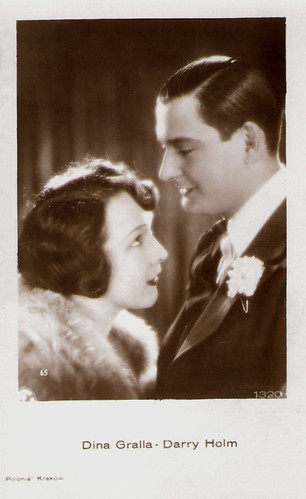
Polish postcard by Polonia, Krakow, no. 1320. Dina Gralla and Harry Halm in Wer wird denn weinen, wenn man auseinandergeht?/No Use Crying If Your Sweetheart Goes Away (Richard Eichberg, 1929).
Polish-born, German actress Dina Gralla (1905-1994) often appeared as a naïve, sexy dancer in German revues, and in more than 35 silent and early sound films.
Charming actor Harry Halm (1901-1980) was a popular ladies’ man of the silent German cinema. Sound film and the rise of the Nazis broke his career.
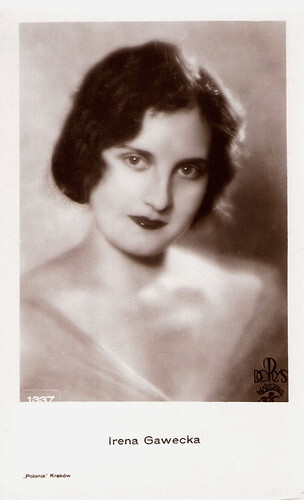
Polish postcard by Polonia, Kraków, no. 1337. Photo: Dorys, Warszawa.
Polish actress Irena Gawęcka (1901-1982) was a star of the silent cinema, who made 5 Polish films between 1928 and 1930. Her film debut as Countess Zofia opposite Boleslaw Szczurkiewicz as her father in Szaleńcy/Madmen (1928), which was also the directorial debut of Leonard Buczkowski. In 1929, the successful film was awarded the Grand Prix and the Gold Medal at the Universal Exhibition in Paris.
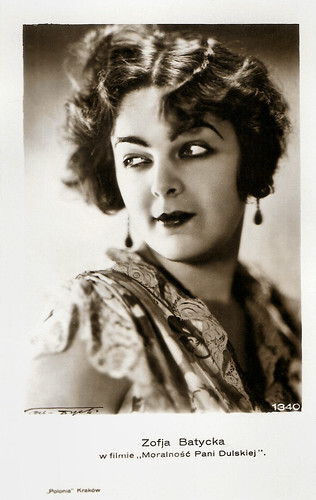
Polish postcard by Polonia, Krakow, no. 1340. Photo: Van Dyck. Zofia Batycka in Moralność pani Dulskiej (Borys Newolin, Boleslaw Land, 1930).
Zofia Batycka aka Zofja Batycka (1907-1989) was a Polish model and actress. She supposedly had an affair with tenor Jan Kiepura in 1928 but they never married. As a student Zofia made her debut in the silent Sfinks production Grzeszna milosc (Zbigniew Gniazdowski, Mieczyslaw Krawicz 1929), partly filmed at the Tatra Mountains. It was followed by more Polish silent and sound films. Zofia Batycka won the title of Miss Polonia in 1930 and became extremely popular, winning the title of Miss Paramount in 1931. She went to Hollywood but never made another film.
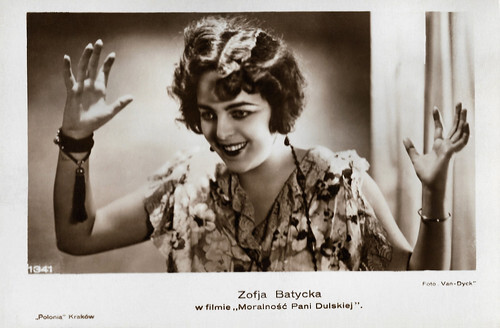
Polish postcard by Polonia, Krakow, no. 1341. Photo: Van Dyck. Zofia Batycka in Moralność pani Dulskiej/The Morals of Mrs Dulska (Borys Newolin, Boleslaw Land, 1930), based on Gabriela Zapolska's eponymous drama. It was the first Polish sound film, shown with a sound-on-disc system. Today, the records are lacking, so only a silent version exists.
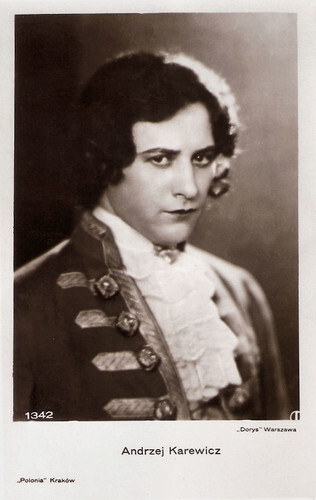
Polish postcard by Polonia, Krakow, no. 1342. Photo: Dorys, Warszawa.
Andrzej Karewicz (1894-1969) was a handsome Polish film actor who appeared in six films in his country between 1928 and 1935. In 1930, he appeared in Aleksander Ford's feature debut Mascotte (1930) with Irma Green.
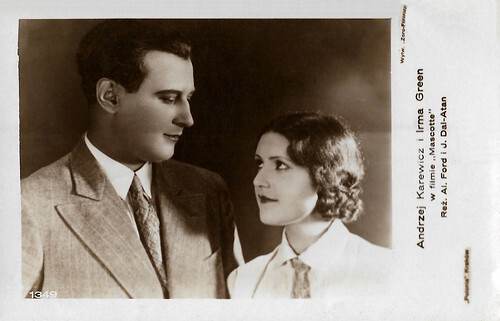
Polish postcard by Polonia, Krakow, no. 1349. Photo: Zoro-Film. Andrzej Karewicz and Irma Green in Mascotte (Aleksander Ford, 1930), scripted by Jerzy Dal-Atan.
Mascotte (1930) was Aleksander Ford's first feature as director. Ford is better known for his post-war documentary Majdanek - cmentarzysko Europy/Majdanek – the Cemetery of Europe (1945) and the fiction films Ulica Graniczna/Border Street (1949), Piątka z ulicy Barskiej/Five Boys from Barska Street (1954) and Krzyżacy/Knights of the Teutonic Order (1960). Yet, he had already made five feature fiction films and several documentaries and shorts in the 1930s before fleeing to the USSR in the late 1930s when WWII broke out. He returned a convinced and stern communist, became head of the government-controlled Film Polski, and was for 20 years a professor at the famous Lodz National Film School. During the 1968 Polish crisis, and the rising anti-Jewish sentiments, the Jewish Ford fled the country. Blacklisted and publicly silenced by the communist government and unable to produce successful films abroad, he committed suicide in a Florida hotel in 1980.
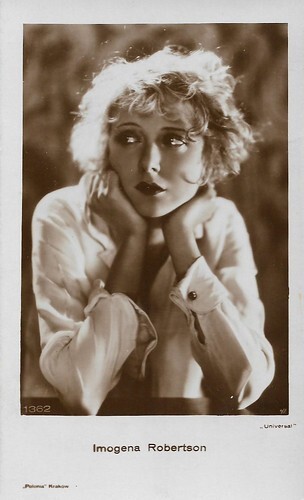
Polish postcard by Polonia, Krakow, no. 1362. Photo: Universal.
Blonde and utterly beautiful American actress Mary Nolan (1902–1948) appeared on stage, on screen, and most of all in the tabloids. After a 'sex scandal', she fled to Germany where she starred in 17 silent films under her real name, Imogene Robertson.
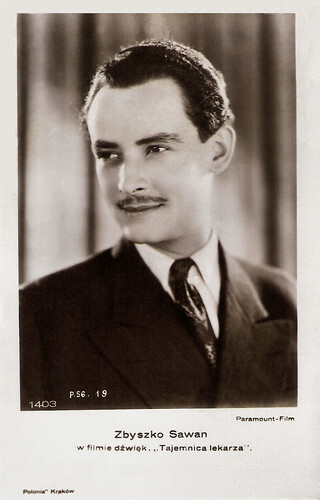
Polish postcard by Polonia, Kraków, no. 1403. Photo: Paramount-Film. Publicity still for Tajemnica Lekarza/The Doctor's Secret (Ryszard Ordynski, 1930).
Polish actor Zbigniew Sawan (1904–1984) starred both in silent and sound films and was also a respected stage actor in his country. He also worked as a theatre director and manager.
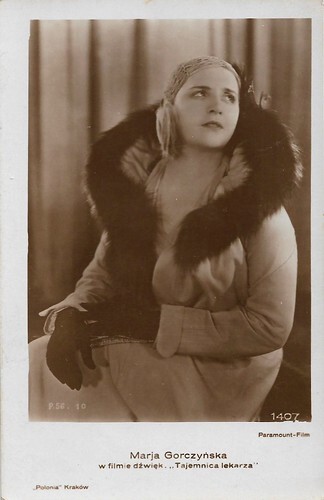
Polish postcard by Polonia, Krakow, no. 1407. Photo: Paramount-Film. Marja Gorczynska was the female star of Tajemnica lekarza (Ryszard Ordynski, 1930). The film was shot at the Paramount Studios near Paris. It was one of the eleven alternative language versions of The Doctor's Secret(William C. de Mille, 1929), based on J.M. Barrie's play 'Half an Hour', and all shot at Paramount in Paris. In the original American version, Ruth Chatterton was the female lead.
Maria aka Marja Gorczynska (1899-1959) was a Polish film actress, known for Tajemnica lekarza (1930), Co mój maz robi w nocy/What Is My Husband Doing at Night? (Michal Waszynski 1934), and Druga mlodosc/Second Youth (Michal Waszynski, 1938).
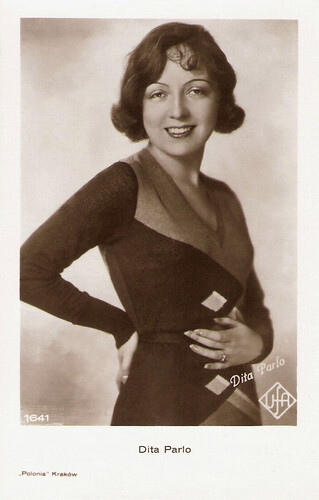
Polish postcard by Polonia, Krakow, no. 1641. Photo: Ufa.
Dita Parlo (1908-1971) was a popular European film star in the late 1920s and early 1930s. She inspired both Dita Von Teese and Madonna, who used Parlo's name and character from L'Atalante for her controversial 'Sex' book and 'Erotica' album.
Sources: Alain Pavelin (Senses of Cinema), Wikipedia (English, German and French), and IMDb.
With special thanks to Marcin Jaroszewicz, Łukasz Biskupski and Michał Pabiś-Orzeszyna.

Polish postcard by Polonia, Krakow. Jadwiga Smosarska in Tredowata/The Leper (Boleslaw Mierzejewski, Edward Puchalski, 1927).
Jadwiga Smosarska (1898 -1971) was the biggest star of the Polish cinema of the pre-WWII era. From 1919 on, the Polish actress made more than 25 silent and sound films. She also was very successful on stage. When the Nazis invaded Poland in 1939, she fled to the US. In 1970, she returned to Poland.

Polish postcard by Polonia, Krakòw, no. 27. Photo: Dorys, Warszawa (Warsaw). Collection: Didier Hanson.
Jadwiga Smosarska (1898-1971) was the biggest star of the Polish cinema of the pre-WWII era. From 1919 on, the Polish actress made more than 25 silent and sound films. She also was very successful on stage. When the Nazis invaded Poland in 1939, she fled to the US. In 1970, she returned to Poland.

Polish postcard by Polonia, Krakow, no. 452. Photo: Bavaria Film. Olga Tschechowa in the German silent film Diane (Erich Waschneck, 1929).
Dignified German-Russian actress Olga Tschechowa (1897-1980) was one of the most popular stars of the silent film era. She remained a mysterious person throughout her life.

Polish postcard by Polonia, Krakow, no. 455. Marie Prevost in The Rush Hour (E. Mason Hopper, 1927).
Marie Prevost (1898-1937) was a Canadian-born, American silent screen actress. She was excellent in such comedies as Ernst Lubitsch's The Marriage Circle (1924). The end of her life was filled with tragedies.

Polish postcard by Polonia, Krakow, no. 847. Photo: Hom Film. Valerie Boothby in Vererbte Triebe/Inherited Passions (Gustav Ucicky, 1929).
German actress Valerie Boothby (1906-1982) was a popular star of the Weimar cinema in the late 1920s and early 1930s.
One of the most modern rotogravure printing houses in Poland
There is little information on the web about Polonia. Happily, we could contact Polish postcard specialist Marcin Jaroszewicz who mailed us the following info: 'The Polonia Kraków Printing House was one of the most modern rotogravure printing houses in Poland. In addition to postcards, they printed leaflets and other materials, including film programs (a poorly researched topic, I saw 2 items).
Polonia was known for producing postcards. Film postcards were only part of the assortment (including art, monuments, Christmas, New Year, etc.). There is a problem with the numbers, probably all postcards were numbered continuously no matter what the subject was. For example, a Christmas postcard from 1935 had the number 985.
I could not find information about the beginnings of the company. The Polonia shareholders changed frequently. They were already operating in the early 1920s practically until 1939. After the outbreak of the war, the Germans took over the company and subordinated it to Ross Verlag, then already a Nazi-owned firm. After that, nothing was published as Polonia Kraków. After the war, the company did not resume operations; its assets were taken over by the state (like Ross Verlag in East Germany). After 1945, the company 'Film Polski' published postcards for a short time.
Several of Polonia Kraków's film postcards had poor sharpness and should not have been sold. Defective copies are common on the market. There are two hypotheses: either the company could not afford to recall them or the employees sold them unofficially. The first film postcards, although they were created in the 1920s, referred to postcards with theatre actors from the end of the 19th century and seemed outdated.
A postcard of a popular actor in the early 1930s cost 8 groszy, which was the cheapest cinema ticket. Sets of several postcards cost 20 groszy. The company focused on Polish stars. Famous actors like Jadwiga Smosarska , Eugeniusz Bodo and Adam Brodzisz cost more. The collections of the Cinematography Museum in Łódź are large with postcards by Polonia Kraków, Ross Verlag and others.' Ross Verlag Postcards offers an incomplete index of Polonia Kraków film postcards, focused on foreign actors.

Polish postcard by Polonia, Krakow, no. 805. Photo: Fox Film.
Alfredo Carlos Birabén (1905-1956) was an Argentine actor, who had a Hollywood career under the stage name Barry Norton .

Polish postcard by Polonia, Krakow, no. 882. Photo: Ufa. Dita Parlo in Heimkehr/Homecoming (Joe May, 1928).
Dita Parlo (1908-1971) was a popular European film star in the late 1920s and early 1930s. She inspired both Dita Von Teese and Madonna, who used Parlo's name and character from L'Atalante (1934) for her controversial 'Sex' book and 'Erotica' album.

Polish postcard by Polonia, Kraków, no. 907. Photo: Van Dyck.
Polish actor Zbigniew Sawan (1904–1984) starred both in silent and sound films and was also a respected stage actor in his country. He also worked as a theatre director and manager.

Polish postcard by Polonia, Krakow, no. 923. Collection: Joanna.
Polish actor Harry Cort (1905-?) came from a royal dynasty and had a short film career with starring roles in three silent films, 9:25. Przygoda jednej nocy/9:25. Adventure One Night (1929), Halka (1930) and Karuzela zycia/Carousel of Life (1930).

Polish postcard by Polonia, Krakow, no. 1171.
English film and stage actor Clive Brook (1887-1974) worked first in British films and then in Hollywood. The suave, handsome, distinguished leading man is best remembered as Marlene Dietrich’s love interest in Shanghai Express (1932).
Cinema in Poland before World War II
The history of cinema in Poland is almost as long as the history of cinematography. The first cinema was founded in Łódź in 1899 and by the end of the next decade, there were cinemas in almost every major town in Poland. Arguably the first Polish filmmaker was Kazimierz Prószyński, who filmed various short documentaries in Warsaw. He is credited as the author of the earliest surviving Polish documentary titled Ślizgawka w Łazienkach/Skating-rink in the Royal Baths, made between 1894 and 1896, as well as the first short narrative films Powrót birbanta/Rake's Return Home and Przygoda dorożkarza/Cabman's Adventure, both created in 1902.
The earliest surviving feature film is Pruska Kultura/Prussian Culture, produced in 1907 by Mordechaj Towbin. It was only rediscovered in 2000 in the French archive Bois D'Arcy. For censorship reasons - Poland was still occupied by Germany at the time - this film, which denounced the forced Germanisation and persecution of Polish children, could not be distributed in Poland and was sold abroad. Till 2000, the common assumption was that the comedy Antoś pierwszy raz w Warszawie/Antoś for the First Time in Warsaw (1908) started the Polish film industry. The film was directed by George Meyer (real name Joseph-Louis Mundwiller) and starred Antoni Fertner. Unfortunately, this film, which was immediately shown in Paris, is now considered lost forever. After 1908, Polish artists started experimenting with other genres of cinema. Władysław Starewicz made one of the first animated cartoons in the world - and the first to use the stop motion technique, Lucanus Cervus/Piękna Lukanida/Beautiful Lukanida. The film celebrated its premiere in Moscow in 1912.
Another key figure was Aleksander Hertz, a hugely influential producer. In 1906 he co-founded the Sfinks Motion Picture Theatre, which gave in 1909 its name to Poland's first real film production studio. Hertz was a successful director and ‘discoverer’ of many stars, including Pola Negri. In 1914, the then 18-year-old Pola Negri made her film debut for Sfinks in the Polish silent film Niewolnica Zmysłów/Slave of the Senses (Ryszard Ordynski, Jan Pawlowski, 1914). Edward Puchalski, the other popular director of the time, revealed the talent of Lya Mara . By the start of World War I the cinema in Poland was already in full swing, with numerous film adaptations of major works of Polish literature. During World War I the Polish cinema crossed borders. Films made in Warsaw or Vilnius were often rebranded with German-language intertitles and shown in Berlin. Pola Negri gained fame in Germany. Unfortunately, of the eight films Negri made for Sfinks, only extracts from Bestia/The Beast (Aleksander Hertz, 1917) have survived.
After the First World War, the Republic of Poland emerged after more than 100 years of oppression by the German Empire, the Russian Tsar and the Austro-Hungarian Danube Monarchy. Sfinks had to face up to the loss of its two biggest stars: Pola Negri and Lya Mara , who had left to pursue their careers in Berlin. Jadwiga Smosarska became the studio's new star and the biggest Polish film star of the inter-war period. The first woman to direct a film in Poland and the only female film director of the Polish silent film era was Nina Niovilla. She debuted in 1918 in Berlin and then directed her first Polish film, Tamara/Obrońcy Lwowa (1919). In addition to light comedies and other melodramas, the first patriotic films and literary adaptations were also made. In 1928, Ryszard Ordyński directed the first film adaptation of the Polish national epic 'Pan Tadeusz' by Adam Mickiewicz.
The first sound film in the history of Polish cinema was made in 1930 and was also a literary adaptation: Moralność pani Dulskiej/The Morals of Mrs Dulska (Borys Newolin, Boleslaw Land, 1930), based on Gabriela Zapolska's drama. The 1930s were also characterised by commercial successes. Some actors and singers, such as Adolf Dymsza and Eugeniusz Bodo, became national idols, while others, such as the later world-famous Jan Kiepura , launched their careers. There were also attempts to popularise avant-garde film, including by the artists' group START (Stowarzyszenie Propagandy Filmu Artystycznego), founded by filmmakers Aleksander Ford and Jerzy Toeplitz. Between 1918 and 1939, a total of almost 300 Polish films were made. Shortly before the start of the Second World War, there were 68 cinemas in Warsaw alone and over 800 throughout the country.

Polish postcard by Polonia, Krakow, no. 1320. Dina Gralla and Harry Halm in Wer wird denn weinen, wenn man auseinandergeht?/No Use Crying If Your Sweetheart Goes Away (Richard Eichberg, 1929).
Polish-born, German actress Dina Gralla (1905-1994) often appeared as a naïve, sexy dancer in German revues, and in more than 35 silent and early sound films.
Charming actor Harry Halm (1901-1980) was a popular ladies’ man of the silent German cinema. Sound film and the rise of the Nazis broke his career.

Polish postcard by Polonia, Kraków, no. 1337. Photo: Dorys, Warszawa.
Polish actress Irena Gawęcka (1901-1982) was a star of the silent cinema, who made 5 Polish films between 1928 and 1930. Her film debut as Countess Zofia opposite Boleslaw Szczurkiewicz as her father in Szaleńcy/Madmen (1928), which was also the directorial debut of Leonard Buczkowski. In 1929, the successful film was awarded the Grand Prix and the Gold Medal at the Universal Exhibition in Paris.

Polish postcard by Polonia, Krakow, no. 1340. Photo: Van Dyck. Zofia Batycka in Moralność pani Dulskiej (Borys Newolin, Boleslaw Land, 1930).
Zofia Batycka aka Zofja Batycka (1907-1989) was a Polish model and actress. She supposedly had an affair with tenor Jan Kiepura in 1928 but they never married. As a student Zofia made her debut in the silent Sfinks production Grzeszna milosc (Zbigniew Gniazdowski, Mieczyslaw Krawicz 1929), partly filmed at the Tatra Mountains. It was followed by more Polish silent and sound films. Zofia Batycka won the title of Miss Polonia in 1930 and became extremely popular, winning the title of Miss Paramount in 1931. She went to Hollywood but never made another film.

Polish postcard by Polonia, Krakow, no. 1341. Photo: Van Dyck. Zofia Batycka in Moralność pani Dulskiej/The Morals of Mrs Dulska (Borys Newolin, Boleslaw Land, 1930), based on Gabriela Zapolska's eponymous drama. It was the first Polish sound film, shown with a sound-on-disc system. Today, the records are lacking, so only a silent version exists.

Polish postcard by Polonia, Krakow, no. 1342. Photo: Dorys, Warszawa.
Andrzej Karewicz (1894-1969) was a handsome Polish film actor who appeared in six films in his country between 1928 and 1935. In 1930, he appeared in Aleksander Ford's feature debut Mascotte (1930) with Irma Green.

Polish postcard by Polonia, Krakow, no. 1349. Photo: Zoro-Film. Andrzej Karewicz and Irma Green in Mascotte (Aleksander Ford, 1930), scripted by Jerzy Dal-Atan.
Mascotte (1930) was Aleksander Ford's first feature as director. Ford is better known for his post-war documentary Majdanek - cmentarzysko Europy/Majdanek – the Cemetery of Europe (1945) and the fiction films Ulica Graniczna/Border Street (1949), Piątka z ulicy Barskiej/Five Boys from Barska Street (1954) and Krzyżacy/Knights of the Teutonic Order (1960). Yet, he had already made five feature fiction films and several documentaries and shorts in the 1930s before fleeing to the USSR in the late 1930s when WWII broke out. He returned a convinced and stern communist, became head of the government-controlled Film Polski, and was for 20 years a professor at the famous Lodz National Film School. During the 1968 Polish crisis, and the rising anti-Jewish sentiments, the Jewish Ford fled the country. Blacklisted and publicly silenced by the communist government and unable to produce successful films abroad, he committed suicide in a Florida hotel in 1980.

Polish postcard by Polonia, Krakow, no. 1362. Photo: Universal.
Blonde and utterly beautiful American actress Mary Nolan (1902–1948) appeared on stage, on screen, and most of all in the tabloids. After a 'sex scandal', she fled to Germany where she starred in 17 silent films under her real name, Imogene Robertson.

Polish postcard by Polonia, Kraków, no. 1403. Photo: Paramount-Film. Publicity still for Tajemnica Lekarza/The Doctor's Secret (Ryszard Ordynski, 1930).
Polish actor Zbigniew Sawan (1904–1984) starred both in silent and sound films and was also a respected stage actor in his country. He also worked as a theatre director and manager.

Polish postcard by Polonia, Krakow, no. 1407. Photo: Paramount-Film. Marja Gorczynska was the female star of Tajemnica lekarza (Ryszard Ordynski, 1930). The film was shot at the Paramount Studios near Paris. It was one of the eleven alternative language versions of The Doctor's Secret(William C. de Mille, 1929), based on J.M. Barrie's play 'Half an Hour', and all shot at Paramount in Paris. In the original American version, Ruth Chatterton was the female lead.
Maria aka Marja Gorczynska (1899-1959) was a Polish film actress, known for Tajemnica lekarza (1930), Co mój maz robi w nocy/What Is My Husband Doing at Night? (Michal Waszynski 1934), and Druga mlodosc/Second Youth (Michal Waszynski, 1938).

Polish postcard by Polonia, Krakow, no. 1641. Photo: Ufa.
Dita Parlo (1908-1971) was a popular European film star in the late 1920s and early 1930s. She inspired both Dita Von Teese and Madonna, who used Parlo's name and character from L'Atalante for her controversial 'Sex' book and 'Erotica' album.
Sources: Alain Pavelin (Senses of Cinema), Wikipedia (English, German and French), and IMDb.
With special thanks to Marcin Jaroszewicz, Łukasz Biskupski and Michał Pabiś-Orzeszyna.
Published on January 10, 2025 22:00
January 9, 2025
The Brass Bullet (1918)
Jack Mulhall and Juanita Hansen were the stars of the silent American serial The Brass Bullet (Ben F. Wilson, 1918) produced by Universal. The serial deals with a convoluted and complicated plot, but the basis is the hunt by Spring Gilbert (Joseph W. Girard) and Victor King (Ashton Dearholt) for the heritage of Rosalind Joy (Juanita Hansen) after her uncle Homer Joy (Charles Hill Mailes) has been killed. Gilbert and King will use all means to make sure they get the heritage. Yet, Jack James (Jack Mulhall) and a Mystery Man (Hallam Cooley) come to the rescue. In this post, we tell the tragic story of the serial's leading lady Juanita Hansen, who was a popular serial queen in the late 1910s and early 1920s.
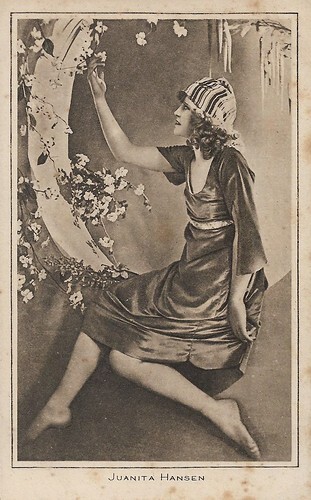
British postcard in the "Pictures" Portrait Gallery, London, no. 169. Juanita Hansen.
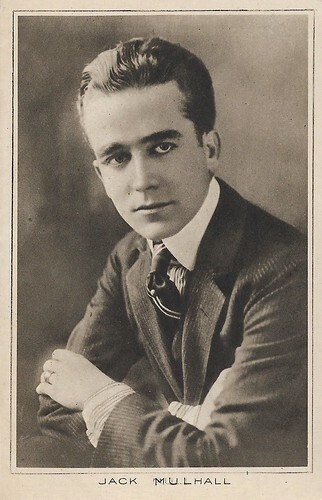
British postcard in the "Pictures" Portrait Gallery, London, no. 25. Photo: The Trans-Atlantic Film Co. (Universal's European distribution brand). Jack Mulhall .
Serial Queen at Universal
Juanita Hansen was born in 1895 in Des Moines, Iowa, or Wisconsin.
In 1914 at age 16, Hansen made her film debut with Frank Baum's Oz Film Productions, but soon stepped over to Triangle. Under D.W. Griffith 's supervision, she acted in The Martyrs of the Alamo (Christy Cabanne, 1915).
In the same year, she also starred in the 15-part serial The Secret of the Submarine (George L. Sargent, 1915), produced by American Film and, like the Triangle films, distributed by Mutual.
Hansen also worked for Famous Players and Morosco Productions, both distributed by Paramount. In 1916, she joined Mack Sennett's Bathing Beauties troupe, and acted in several short comedies at Keystone/ Triangle Studios, including comedies with Douglas Fairbanks .
In 1918, Hansen left for Universal Studios where she became a serial queen in The Brass Bullet (Ben Wilson, 1918). After several Universal films in 1919, she starred again in a serial, The Lost City (1920), now at Selig and distributed by Warner. Eventually, the serial was re-released as a feature as well, entitled The Jungle Princess. The success also led to two Pathé serials, The Phantom Foe (1920) and The Yellow Arm (1921).
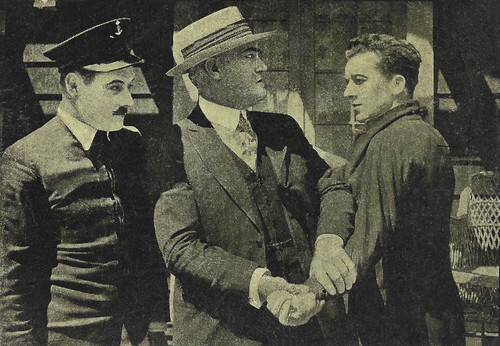
Spanish cromo card by Chocolate Pi, Barcelona, no. 7 of 54. Photo: Distr. J. Verdaguer / Universal / The Trans-Atlantico Co. Scene from The Brass Bullet (Ben F. Wilson, 1918). Spanish release title: La Bala de Bronce. Here, left of Jack Mulhall , Joseph W. Girard as Spring Gilbert. The man far left may be Ashton Dearholt as Victor King.
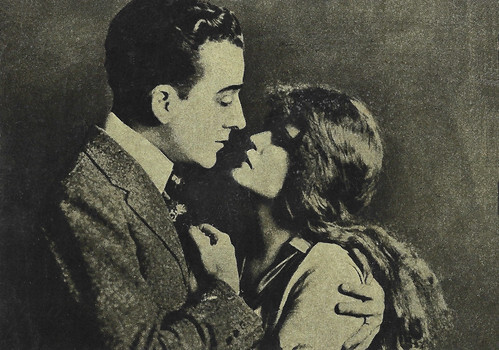
Spanish cromo card by Chocolate Pi, Barcelona, no. 23 of 54. Photo: Distr. J. Verdaguer / Universal / The Trans-Atlantico Co. Scene from The Brass Bullet (Ben F. Wilson, 1918), starring Jack Mulhall and Juanita Hansen. Spanish release title: La Bala de Bronce.
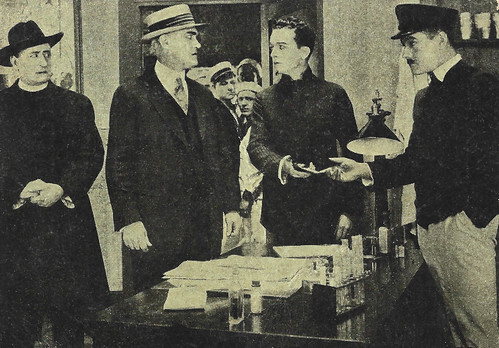
Spanish cromo card by Chocolate Pi, Barcelona, no. 32 of 54. Photo: Distr. J. Verdaguer / Universal / The Trans-Atlantico Co. Scene from The Brass Bullet (Ben F. Wilson, 1918). Spanish release title: La Bala de Bronce. Here, left of Jack Mulhall , possibly Joseph W. Girard as Spring Gilbert. The minister left of him was played by Charles Force. The man on the right may be Ashton Dearholt, who plays Victor King.
A life of mischief
Very well paid, Juanita Hansen began a life of mischief. She had a penchant for fast cars and was being constantly arrested for speeding) and loved all-night partying. She turned to drugs, cocaine in particular. Pathé stopped working with her and her career came to a standstill in 1923.
That year, Hansen went into rehab and did a touring lecture afterwards to warn against the danger of drugs. Yet, her addiction and misery weren't over.
In 1928, following an accident in which she almost died from an outburst of scalding steam in her hotel room, she was treated with morphine and remained addicted. Her descent into hell continued.
Despite being granted over 100,000 dollars in damage repair after a years-long trial, she became penniless because of her addiction. In 1938 she wrote the book 'The Conspiracy of Silence', arguing that drug addicts should be sent to specialized medical institutions for treatment instead of being sent to prison.
Her life took another turn for the worse in 1941 when she attempted suicide by an overdose of sleeping pills. Juanita Hansen ended her life as a clerk for a railroad company and she died of a heart attack in 1961 in Los Angeles, California.
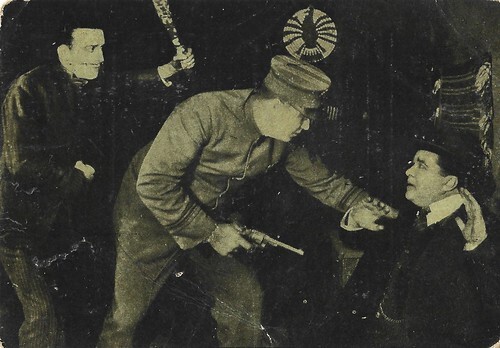
Spanish cromo card by Chocolate Pi, Barcelona, no. 37 of 54. Photo: Distr. J. Verdaguer / Universal / The Trans-Atlantico Co. Scene from the American serial The Brass Bullet (Ben F. Wilson, 1918), starring Jack Mulhall and Juanita Hansen. The man on the left may be Ashton Dearholt, who plays Victor King.
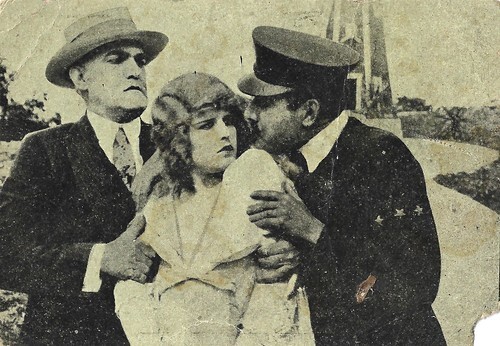
Spanish cromo card by Chocolate Pi, Barcelona, no. 48 of 54. Photo: Distr. J. Verdaguer / Universal / The Trans-Atlantico Co. Scene from the American serial The Brass Bullet (Ben F. Wilson, 1918), starring Jack Mulhall and Juanita Hansen. Spanish release title: La Bala de Bronce. Here, left of Hansen, possibly Joseph W. Girard as Spring Gilbert. The man on the right may be Ashton Dearholt, who plays Victor King.
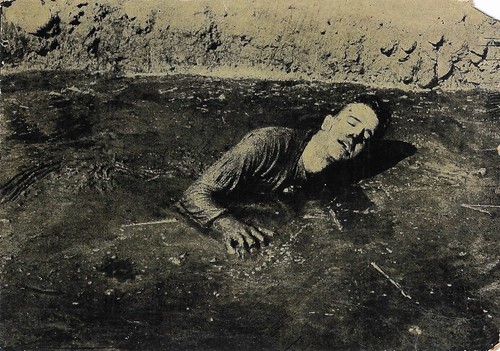
Spanish cromo card by Chocolate Pi, Barcelona, no. 50 of 54. Photo: Distr. J. Verdaguer / Universal / The Trans-Atlantico Co. Scene from the American serial The Brass Bullet (Ben F. Wilson, 1918). Spanish release title: La Bala de Bronce. Ep. 4, reel 2. The man dying in the quicksand.
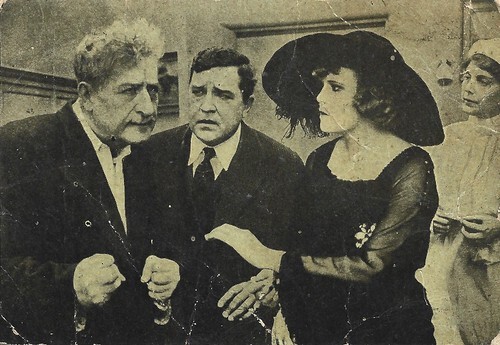
Spanish cromo card by Chocolate Pi, Barcelona, no. 54 of 54. Photo: Distr. J. Verdaguer / Universal / The Trans-Atlantico Co. Scene from the American serial The Brass Bullet (Ben F. Wilson, 1918), starring Jack Mulhall and Juanita Hansen. Spanish release title: La Bala de Bronce. Here, the man in the middle is Harry Dunkinson, who plays Dr. Canfield.
Sources: Wikipedia (English and French) and .

British postcard in the "Pictures" Portrait Gallery, London, no. 169. Juanita Hansen.

British postcard in the "Pictures" Portrait Gallery, London, no. 25. Photo: The Trans-Atlantic Film Co. (Universal's European distribution brand). Jack Mulhall .
Serial Queen at Universal
Juanita Hansen was born in 1895 in Des Moines, Iowa, or Wisconsin.
In 1914 at age 16, Hansen made her film debut with Frank Baum's Oz Film Productions, but soon stepped over to Triangle. Under D.W. Griffith 's supervision, she acted in The Martyrs of the Alamo (Christy Cabanne, 1915).
In the same year, she also starred in the 15-part serial The Secret of the Submarine (George L. Sargent, 1915), produced by American Film and, like the Triangle films, distributed by Mutual.
Hansen also worked for Famous Players and Morosco Productions, both distributed by Paramount. In 1916, she joined Mack Sennett's Bathing Beauties troupe, and acted in several short comedies at Keystone/ Triangle Studios, including comedies with Douglas Fairbanks .
In 1918, Hansen left for Universal Studios where she became a serial queen in The Brass Bullet (Ben Wilson, 1918). After several Universal films in 1919, she starred again in a serial, The Lost City (1920), now at Selig and distributed by Warner. Eventually, the serial was re-released as a feature as well, entitled The Jungle Princess. The success also led to two Pathé serials, The Phantom Foe (1920) and The Yellow Arm (1921).

Spanish cromo card by Chocolate Pi, Barcelona, no. 7 of 54. Photo: Distr. J. Verdaguer / Universal / The Trans-Atlantico Co. Scene from The Brass Bullet (Ben F. Wilson, 1918). Spanish release title: La Bala de Bronce. Here, left of Jack Mulhall , Joseph W. Girard as Spring Gilbert. The man far left may be Ashton Dearholt as Victor King.

Spanish cromo card by Chocolate Pi, Barcelona, no. 23 of 54. Photo: Distr. J. Verdaguer / Universal / The Trans-Atlantico Co. Scene from The Brass Bullet (Ben F. Wilson, 1918), starring Jack Mulhall and Juanita Hansen. Spanish release title: La Bala de Bronce.

Spanish cromo card by Chocolate Pi, Barcelona, no. 32 of 54. Photo: Distr. J. Verdaguer / Universal / The Trans-Atlantico Co. Scene from The Brass Bullet (Ben F. Wilson, 1918). Spanish release title: La Bala de Bronce. Here, left of Jack Mulhall , possibly Joseph W. Girard as Spring Gilbert. The minister left of him was played by Charles Force. The man on the right may be Ashton Dearholt, who plays Victor King.
A life of mischief
Very well paid, Juanita Hansen began a life of mischief. She had a penchant for fast cars and was being constantly arrested for speeding) and loved all-night partying. She turned to drugs, cocaine in particular. Pathé stopped working with her and her career came to a standstill in 1923.
That year, Hansen went into rehab and did a touring lecture afterwards to warn against the danger of drugs. Yet, her addiction and misery weren't over.
In 1928, following an accident in which she almost died from an outburst of scalding steam in her hotel room, she was treated with morphine and remained addicted. Her descent into hell continued.
Despite being granted over 100,000 dollars in damage repair after a years-long trial, she became penniless because of her addiction. In 1938 she wrote the book 'The Conspiracy of Silence', arguing that drug addicts should be sent to specialized medical institutions for treatment instead of being sent to prison.
Her life took another turn for the worse in 1941 when she attempted suicide by an overdose of sleeping pills. Juanita Hansen ended her life as a clerk for a railroad company and she died of a heart attack in 1961 in Los Angeles, California.

Spanish cromo card by Chocolate Pi, Barcelona, no. 37 of 54. Photo: Distr. J. Verdaguer / Universal / The Trans-Atlantico Co. Scene from the American serial The Brass Bullet (Ben F. Wilson, 1918), starring Jack Mulhall and Juanita Hansen. The man on the left may be Ashton Dearholt, who plays Victor King.

Spanish cromo card by Chocolate Pi, Barcelona, no. 48 of 54. Photo: Distr. J. Verdaguer / Universal / The Trans-Atlantico Co. Scene from the American serial The Brass Bullet (Ben F. Wilson, 1918), starring Jack Mulhall and Juanita Hansen. Spanish release title: La Bala de Bronce. Here, left of Hansen, possibly Joseph W. Girard as Spring Gilbert. The man on the right may be Ashton Dearholt, who plays Victor King.

Spanish cromo card by Chocolate Pi, Barcelona, no. 50 of 54. Photo: Distr. J. Verdaguer / Universal / The Trans-Atlantico Co. Scene from the American serial The Brass Bullet (Ben F. Wilson, 1918). Spanish release title: La Bala de Bronce. Ep. 4, reel 2. The man dying in the quicksand.

Spanish cromo card by Chocolate Pi, Barcelona, no. 54 of 54. Photo: Distr. J. Verdaguer / Universal / The Trans-Atlantico Co. Scene from the American serial The Brass Bullet (Ben F. Wilson, 1918), starring Jack Mulhall and Juanita Hansen. Spanish release title: La Bala de Bronce. Here, the man in the middle is Harry Dunkinson, who plays Dr. Canfield.
Sources: Wikipedia (English and French) and .
Published on January 09, 2025 22:00
January 8, 2025
Hildegard Knef
Rebellious, gravel-voiced actress, chanteuse and author Hildegard Knef (1925-2002) was one of the most important film stars of post-war Germany. She also appeared in foreign films and on Broadway, billed as Hildegard(e) Neff. Her outspokenness often caused unease in a country eager to please. Germany’s sole diva led a roller coaster life full of successes and suffering.
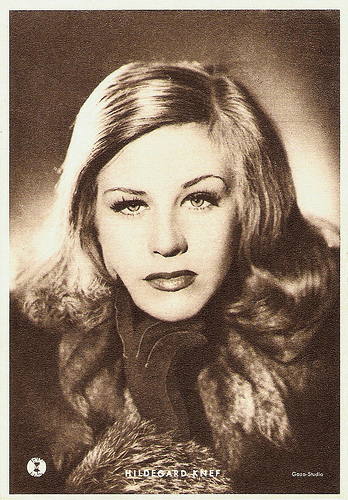
German postcard by Kunst und Bild, Frankfurt-Main. Photo: Gaza-studio.
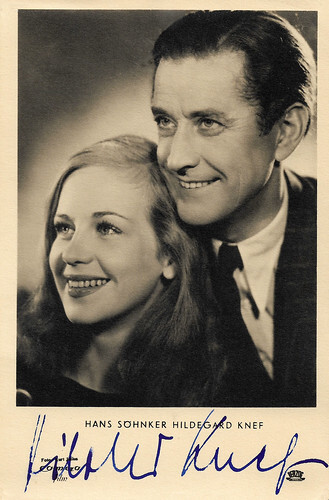
German postcard by Photo-Kitt, München, no. 522. Photo: Camera Film / Kurt Julies / Herzog. Hildegard Knef and Hans Söhnker in Film ohne Titel/Film Without a Name (Rudolf Jugert, 1948).
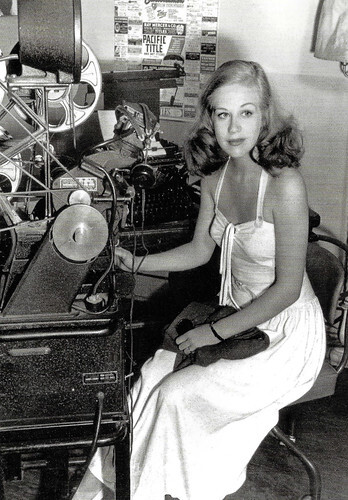
German postcard by Wasmuth Verlag, no. WF 106. Photo: Stiftung Deutsche Kinemathek. Caption: Hildegard Knef, Hollywood 1948.
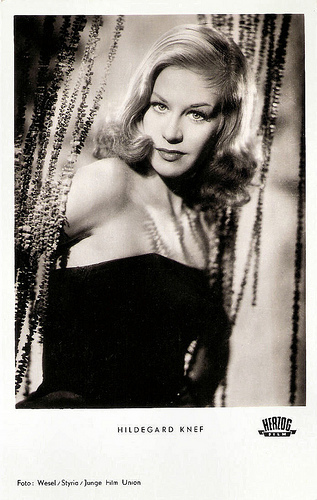
German postcard by Kunst und Bild, Berlin, no. A 482. Photo: Wesel / Styria / Junge Film Union / Herzog Film. Publicity still for Die Sünderin/The Sinner (Willi Forst, 1950).
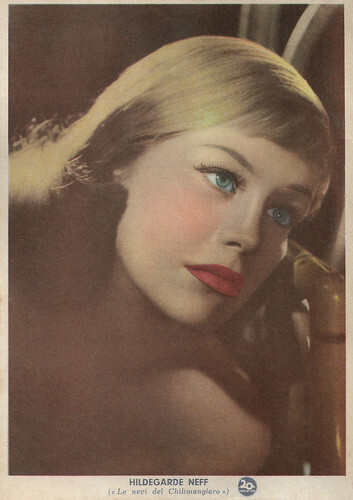
Italian postcard by Edizioni S.I.P.Ci., Milano. Photo: 20th Century Fox. Hildegard Knef in The Snows of Kilimanjaro (Henry King, 1952).
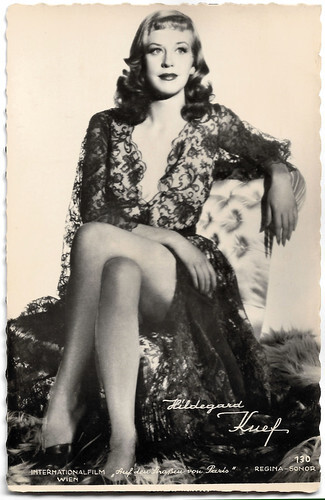
Austrian postcard by Verlag Hubmann (HDH), Wien, no. 130. Photo: International Film, Wien / Regina Sonor. Hildegard Knef in La fête à Henriette/Holiday for Henrietta (Julien Duvivier, 1952).
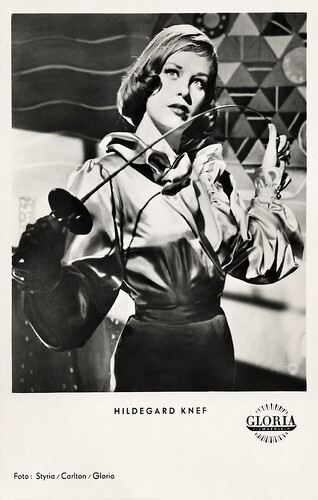
West German postcard by Kunst und Bild, Berlin, no. A 625. Photo: Styria / Carlton / Gloria. Hildegard Knef in Alraune/Mandrake (Arthur Maria Rabenalt, 1952).
Berlin's voice
Hildegard Frieda Albertine Knef was born in Ulm, Germany, in 1925. Her parents were the Flemish tobacco merchant Hans Theodor Knef and his German wife Frieda Auguste Knef-Gröhn. Hildegard went to school to the Rückert-Lyzeum in Berlin-Schöneberg.
In 1942, she began to work as an artist at the painting department of the Ufa Film Studio. A year later, she made a screentest and became an acting student at the Babelsberg Film Institute, Ufa's training program. Even before the fall of the Third Reich, she appeared in several films, including Die Brüder Noltenius/The Noltenius Brothers (Gerhard Lamprecht, 1945), Unter den Brücken/Under the Bridges (Helmut Käutner, 1945), and Frühlingsmelodie/Spring Melody (Hans Robert Bortfeld, 1945), but most were released after the war.
To avoid being raped by the Soviet soldiers she dressed like a young man and was subsequently sent to a camp for prisoners of war. She escaped and returned to war-shattered Berlin where she played her first part on stage in the cabaret show 'Heute Abend um sechs' (Tonight at Six) with Viktor de Kowa .
She had her breakthrough in the first film released after World War II in East Germany, Die Mörder sind unter uns/The Murderers Are Among Us (Wolfgang Staudte, 1946), produced by the communist DEFA-Studio, backed by the Russians. Her powerful performance as a Holocaust survivor amid the ruins of postwar Berlin made her immediately a star. Over 4 million East Germans went to the cinema to see it.
She appeared also in the first West-German films Zwischen gestern und morgen/Between Yesterday and Tomorrow (Harald Braun, 1947) and Film ohne Titel/Film Without a Name (Rudolf Jugert, 1947) with Hans Söhnker , both backed by the Americans. In these films she symbolized war-shattered Germany and became ‘Berlin’s voice’ — learning to survive, stubbornly bouncing back and starting anew, without ever losing sight of the past. Film ohne Titel/Film Without a Name became commercially the most successful film of 1948 in West Germany.
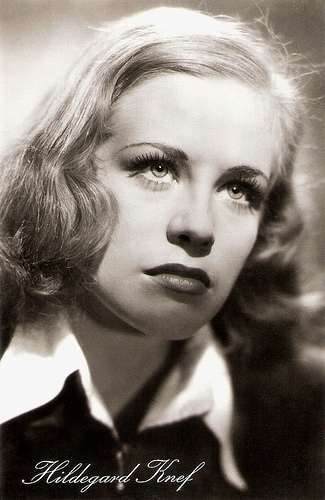
German postcard for Die Mürder sind unter uns/Murderers Among Us (Wolfgang Staudte, 1946) by VEB Progress Film-Vertrieb, Berlin. Photo: DEFA, no. 14 M/300.
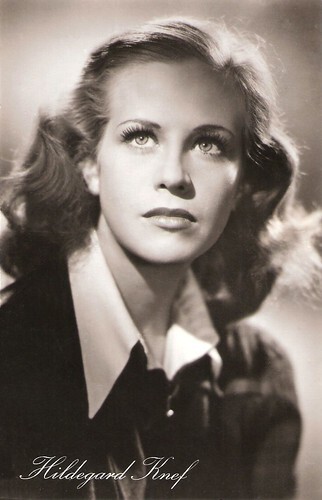
East-German postcard by VEB Progress Film-Vertrieb, Berlin, no. 7/319. 1957. Photo: DEFA.
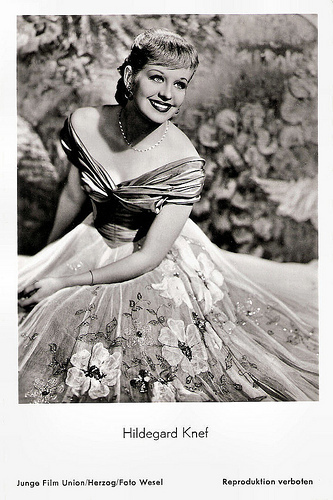
German postcard by F.J. Rüdel Filmpostkartenverlag, Hamburg-Bergedorf, no. 81/2. Photo: Junge Film Union / Herzog / Foto Wesel.
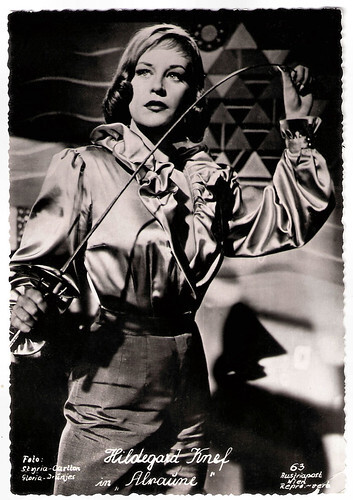
Austrian postcard by Austriapost, Wien, no. 63. Photo: Styria / Carlton / Gloria / Drünjes. Hildegard Knef in Alraune/Mandragore (Arthur Maria Rabenalt, 1952).
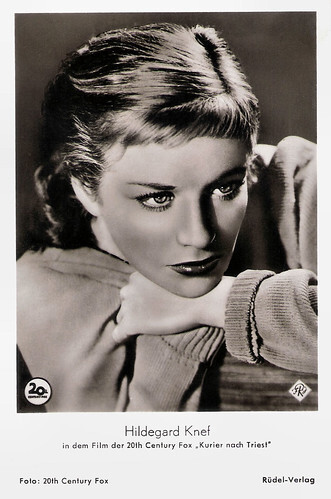
West German postcard by Rüdel Verlag, Hambrug-Bergedorf, no. 339. Photo: 20th Century Fox. Hildegard Knef in Diplomatic Courier (Henry Hathaway, 1952).
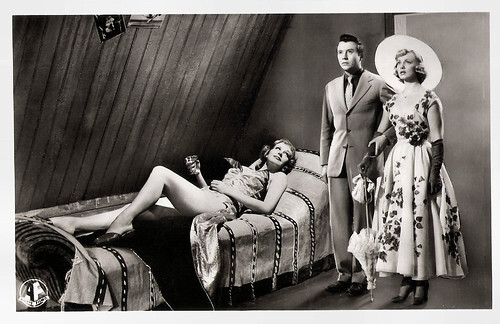
German promotion card for Cinema Paris, Berlin. Photo: Allianz Films. Hildegard Knef, Michel Auclair and Dany Robin in La fête à Henriette/Holiday for Henrietta (Julien Duvivier, 1952).
Nude scene
In 1948 Hildegard Knef appeared on a cover of Life magazine and studio mogul David O. Selznick of 20th Century-Fox invited her to come to Hollywood. He offered her a contract - with two conditions: she should change her name to Gilda Christian and should pretend to be Austrian instead of German. She refused both and returned temporarily to Germany.
There she appeared in another influential role, Marina in Die Sünderin/The Sinner (Willi Forst, 1950), in which she performed the first (brief) nude scene in German cinema. The incident sparked one of the largest scandals in German film history and drew the criticism of the Roman Catholic Church, but also 7 million spectators. Her comment: "I can't understand all that tumult - five years after Auschwitz!"
During the 1950s she became an internationally active star, who travelled between the USA and Europe. She appeared in minor roles in Hollywood productions like Decision Before Dawn (Anatole Litvak, 1951), Diplomatic Courier (Henry Hathaway, 1952) starring Tyrone Power , Ernest Hemingway's The Snows of Kilimanjaro (Henry King, 1952) starring Gregory Peck , and the Film Noir Night Without Sleep (Roy Ward Baker, 1952). In these films, she was billed as Hildegarde Neff, reportedly because Americans couldn't pronounce Knef.
She also starred in such European films as Nachts auf den Straßen/Nights on the Road (Rudolf Jugert, 1951) with Hans Albers , Alraune/Mandrake (Arthur Maria Rabenalt, 1952) opposite Erich von Stroheim , the French production La fête à Henriette/Holiday for Henrietta (Julien Duvivier, 1952), Illusion in Moll/Illusion in a Minor Key (Rudolf Jugert, 1952) with Sybille Schmitz , the thriller The Man Between (Carol Reed, 1953) starring James Mason , and the flop Madeleine und der Legionär/Escape from Sahara (Wolfgang Staudte, 1958) with Bernhard Wicki .
In total, she appeared in 49 feature films, 19 of which were non-German productions. She was also successful on stage, appearing in 15 plays. Her Broadway debut as Ninotchka in Cole Porter's 'Silk Stockings' (1955-1956) is considered her greatest triumph – as she became the first German to succeed on Broadway. The New York Times wrote about her: "She gives an immensely skilful performance".
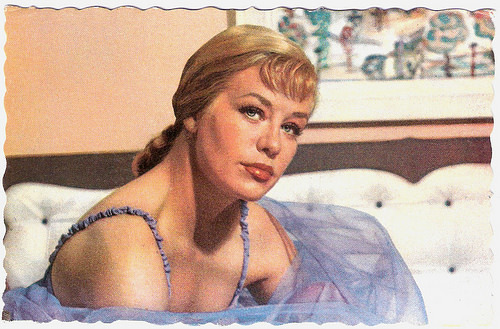
French postcard by De Marchi Frères, Marseille.
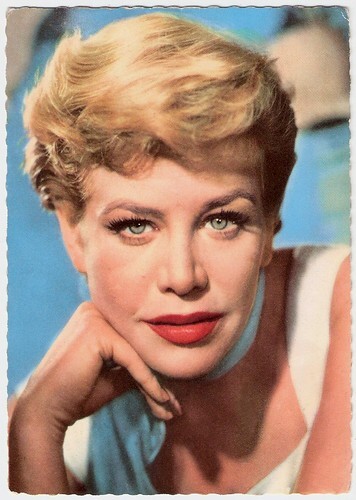
German postcard by Universum-Film Aktiengesellschaft (Ufa), Berlin-Tempelhof, no. CK-96. Retail price: 30 Pfg. Photo: Arthur Grimm / Ufa.
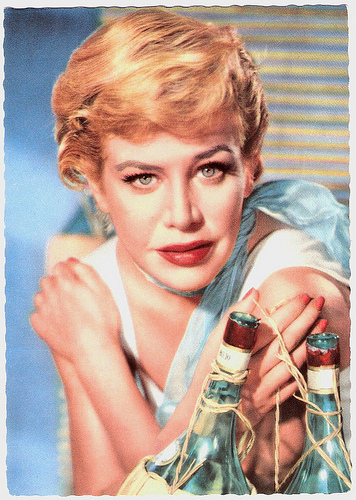
German postcard by Ufa, Berlin-Tempelhof, no. CK-94. Photo: Arthur Grimm / Ufa.
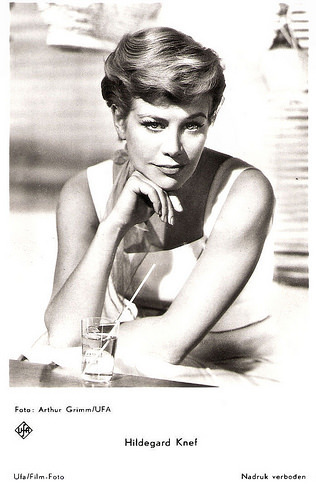
Dutch postcard by D.R.C. Holland, no. 3630. Photo: Arthur Grimm / Ufa.
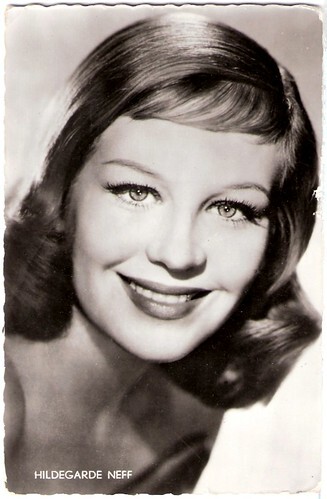
Dutch postcard by N.V. Int. Filmpers, Amsterdam, no. 1056.
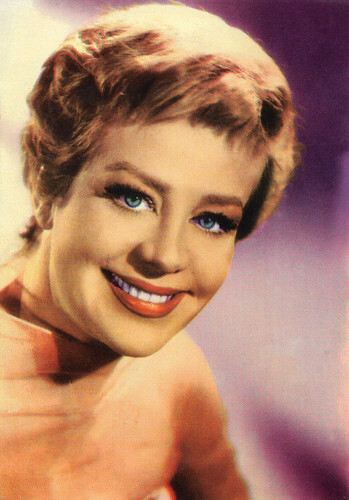
West German postcard by Schumann-Verlag, Berlin. Photo: Rank. Hildegard Knef in Subway in the Sky (Muriel Box, 1959). The German title was U-boot in dem Himmel.
Breast cancer
In the 1960s and 1970s, Hildegard Knef enjoyed success as a singer of German chansons, which she often co-wrote. The song she is best remembered for is 'Für mich soll's rote Rosen regnen' (It Shall Rain Red Roses for Me). She is also known for her version of the song 'Ich hab noch einen Koffer in Berlin' (I`ve Got a Suitcase Left in Berlin...), the title of which is still often cited in articles and in common speech throughout Germany.
Among her other film credits were as Pirate Jenny in a new version of Die Dreigroschenoper/The Threepenny Opera (Wolfgang Staudte, 1962), as a victim of a serial killer in the black comedy Landru (Claude Chabrol, 1963), and as Catherine the Great in Caterina di Russia/Catherine of Russia (Umberto Lenzi, 1963). She was sometimes compared to Marlene Dietrich , in that they both were, or were portrayed as, the liberated, self-confident woman. In Fedora (Billy Wilder, 1979) she played a character based on Dietrich and other legendary film stars.
Besides acting, Hildegard Knef published seven books. Her autobiography 'Der geschenkte Gaul - Bericht aus einem Leben' (The Gift Horse - Report of a Life) from 1970 is a candid, but not sensationalist, recount of her life in Germany during and after World War II. It became the best-selling German book after World War II. Her second book '>Das Urteil' (The Verdict) from 1975 was a moderate success. It was a no-nonsense account of her struggle with breast cancer.
In 1999 her last film hit the screens, Eine fast perfekte Hochzeit/An Almost Perfect Wedding (Reinhard Schwabenitzky, 1999). That same year her last album was released, '17 Millimeter', and she made her last TV appearance, singing 'Zum Schluss...' (At the end…) on the German TV show Herman & Tietjen.
Hildegard Knef endured more than 50 operations but her cancer-ridden and alcohol-wrecked body always bounced back. In 2002 she finally gave in. Aged 76, she died in Berlin, the city where she had moved back to after the German reunification. Her marriages to the American Kurt Hirsch and British actor David Cameron both ended in divorce. She was survived by her third husband, Paul von Schell, and her daughter with David Cameron, Christina (Tinta) Knef (1968).
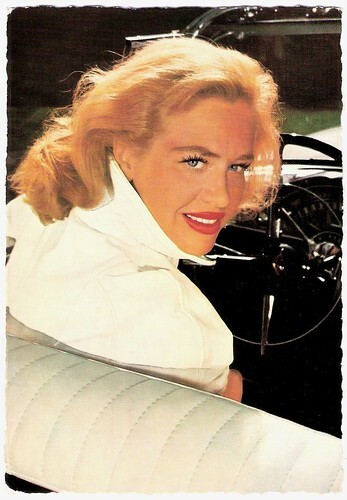
German postcard by WS-Druck, Wanne-Eickel, no. F 37. Photo: Klaus Collignon.
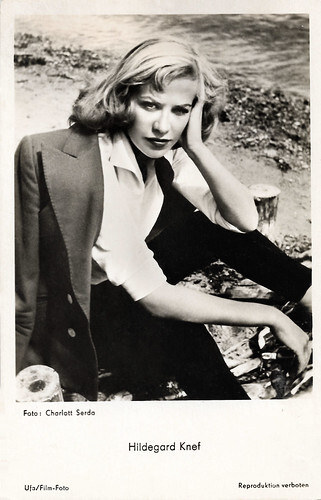
West German postcard by Ufa/Film-Foto, no. 989. Photo: Charlott Serda.
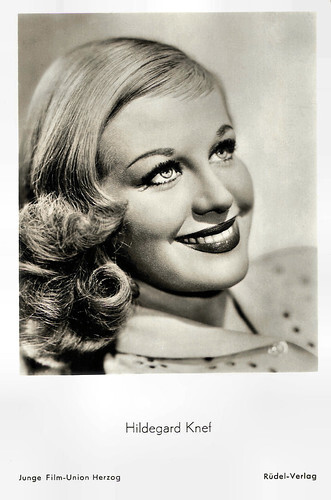
West German postcard by Rüdel Verlag, Hamburg-Bergedorf, no. 615. Photo: Junge Film / Union / Herzog.
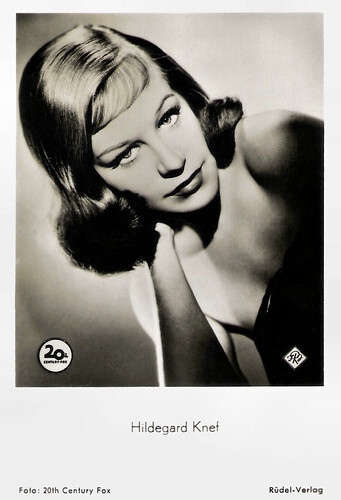
West German postcard by Rüdel Verlag, Hamburg-Bergedorf, no. 469. Photo: 20th Century Fox.
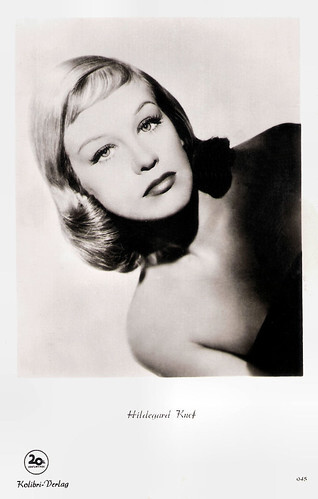
West-German postcard by Kolibri-Verlag, no. 945. Photo: 20th Century Fox.
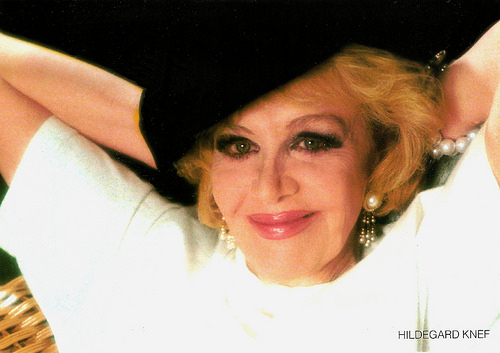
German postcard by Rüdel Verlag, Hamburg. Photo: Lothar Winkler, Berlin.
Hildegard Knef sings 'Für mich soll's rote Rosen regnen'. Source: Master2Dam (YouTube).
Trailer Hilde (2009) with Heike Makatsch as Hildegard Knef. Source: HILDE der Film - offizieller Youtube Channel (YouTube).
Sources: Hal Erickson (AllMovie - Page now defunct), (IMDb), World Press Review, BBC News, Hildegardknef.de (German), Wikipedia, and .

German postcard by Kunst und Bild, Frankfurt-Main. Photo: Gaza-studio.

German postcard by Photo-Kitt, München, no. 522. Photo: Camera Film / Kurt Julies / Herzog. Hildegard Knef and Hans Söhnker in Film ohne Titel/Film Without a Name (Rudolf Jugert, 1948).

German postcard by Wasmuth Verlag, no. WF 106. Photo: Stiftung Deutsche Kinemathek. Caption: Hildegard Knef, Hollywood 1948.

German postcard by Kunst und Bild, Berlin, no. A 482. Photo: Wesel / Styria / Junge Film Union / Herzog Film. Publicity still for Die Sünderin/The Sinner (Willi Forst, 1950).

Italian postcard by Edizioni S.I.P.Ci., Milano. Photo: 20th Century Fox. Hildegard Knef in The Snows of Kilimanjaro (Henry King, 1952).

Austrian postcard by Verlag Hubmann (HDH), Wien, no. 130. Photo: International Film, Wien / Regina Sonor. Hildegard Knef in La fête à Henriette/Holiday for Henrietta (Julien Duvivier, 1952).

West German postcard by Kunst und Bild, Berlin, no. A 625. Photo: Styria / Carlton / Gloria. Hildegard Knef in Alraune/Mandrake (Arthur Maria Rabenalt, 1952).
Berlin's voice
Hildegard Frieda Albertine Knef was born in Ulm, Germany, in 1925. Her parents were the Flemish tobacco merchant Hans Theodor Knef and his German wife Frieda Auguste Knef-Gröhn. Hildegard went to school to the Rückert-Lyzeum in Berlin-Schöneberg.
In 1942, she began to work as an artist at the painting department of the Ufa Film Studio. A year later, she made a screentest and became an acting student at the Babelsberg Film Institute, Ufa's training program. Even before the fall of the Third Reich, she appeared in several films, including Die Brüder Noltenius/The Noltenius Brothers (Gerhard Lamprecht, 1945), Unter den Brücken/Under the Bridges (Helmut Käutner, 1945), and Frühlingsmelodie/Spring Melody (Hans Robert Bortfeld, 1945), but most were released after the war.
To avoid being raped by the Soviet soldiers she dressed like a young man and was subsequently sent to a camp for prisoners of war. She escaped and returned to war-shattered Berlin where she played her first part on stage in the cabaret show 'Heute Abend um sechs' (Tonight at Six) with Viktor de Kowa .
She had her breakthrough in the first film released after World War II in East Germany, Die Mörder sind unter uns/The Murderers Are Among Us (Wolfgang Staudte, 1946), produced by the communist DEFA-Studio, backed by the Russians. Her powerful performance as a Holocaust survivor amid the ruins of postwar Berlin made her immediately a star. Over 4 million East Germans went to the cinema to see it.
She appeared also in the first West-German films Zwischen gestern und morgen/Between Yesterday and Tomorrow (Harald Braun, 1947) and Film ohne Titel/Film Without a Name (Rudolf Jugert, 1947) with Hans Söhnker , both backed by the Americans. In these films she symbolized war-shattered Germany and became ‘Berlin’s voice’ — learning to survive, stubbornly bouncing back and starting anew, without ever losing sight of the past. Film ohne Titel/Film Without a Name became commercially the most successful film of 1948 in West Germany.

German postcard for Die Mürder sind unter uns/Murderers Among Us (Wolfgang Staudte, 1946) by VEB Progress Film-Vertrieb, Berlin. Photo: DEFA, no. 14 M/300.

East-German postcard by VEB Progress Film-Vertrieb, Berlin, no. 7/319. 1957. Photo: DEFA.

German postcard by F.J. Rüdel Filmpostkartenverlag, Hamburg-Bergedorf, no. 81/2. Photo: Junge Film Union / Herzog / Foto Wesel.

Austrian postcard by Austriapost, Wien, no. 63. Photo: Styria / Carlton / Gloria / Drünjes. Hildegard Knef in Alraune/Mandragore (Arthur Maria Rabenalt, 1952).

West German postcard by Rüdel Verlag, Hambrug-Bergedorf, no. 339. Photo: 20th Century Fox. Hildegard Knef in Diplomatic Courier (Henry Hathaway, 1952).

German promotion card for Cinema Paris, Berlin. Photo: Allianz Films. Hildegard Knef, Michel Auclair and Dany Robin in La fête à Henriette/Holiday for Henrietta (Julien Duvivier, 1952).
Nude scene
In 1948 Hildegard Knef appeared on a cover of Life magazine and studio mogul David O. Selznick of 20th Century-Fox invited her to come to Hollywood. He offered her a contract - with two conditions: she should change her name to Gilda Christian and should pretend to be Austrian instead of German. She refused both and returned temporarily to Germany.
There she appeared in another influential role, Marina in Die Sünderin/The Sinner (Willi Forst, 1950), in which she performed the first (brief) nude scene in German cinema. The incident sparked one of the largest scandals in German film history and drew the criticism of the Roman Catholic Church, but also 7 million spectators. Her comment: "I can't understand all that tumult - five years after Auschwitz!"
During the 1950s she became an internationally active star, who travelled between the USA and Europe. She appeared in minor roles in Hollywood productions like Decision Before Dawn (Anatole Litvak, 1951), Diplomatic Courier (Henry Hathaway, 1952) starring Tyrone Power , Ernest Hemingway's The Snows of Kilimanjaro (Henry King, 1952) starring Gregory Peck , and the Film Noir Night Without Sleep (Roy Ward Baker, 1952). In these films, she was billed as Hildegarde Neff, reportedly because Americans couldn't pronounce Knef.
She also starred in such European films as Nachts auf den Straßen/Nights on the Road (Rudolf Jugert, 1951) with Hans Albers , Alraune/Mandrake (Arthur Maria Rabenalt, 1952) opposite Erich von Stroheim , the French production La fête à Henriette/Holiday for Henrietta (Julien Duvivier, 1952), Illusion in Moll/Illusion in a Minor Key (Rudolf Jugert, 1952) with Sybille Schmitz , the thriller The Man Between (Carol Reed, 1953) starring James Mason , and the flop Madeleine und der Legionär/Escape from Sahara (Wolfgang Staudte, 1958) with Bernhard Wicki .
In total, she appeared in 49 feature films, 19 of which were non-German productions. She was also successful on stage, appearing in 15 plays. Her Broadway debut as Ninotchka in Cole Porter's 'Silk Stockings' (1955-1956) is considered her greatest triumph – as she became the first German to succeed on Broadway. The New York Times wrote about her: "She gives an immensely skilful performance".

French postcard by De Marchi Frères, Marseille.

German postcard by Universum-Film Aktiengesellschaft (Ufa), Berlin-Tempelhof, no. CK-96. Retail price: 30 Pfg. Photo: Arthur Grimm / Ufa.

German postcard by Ufa, Berlin-Tempelhof, no. CK-94. Photo: Arthur Grimm / Ufa.

Dutch postcard by D.R.C. Holland, no. 3630. Photo: Arthur Grimm / Ufa.

Dutch postcard by N.V. Int. Filmpers, Amsterdam, no. 1056.

West German postcard by Schumann-Verlag, Berlin. Photo: Rank. Hildegard Knef in Subway in the Sky (Muriel Box, 1959). The German title was U-boot in dem Himmel.
Breast cancer
In the 1960s and 1970s, Hildegard Knef enjoyed success as a singer of German chansons, which she often co-wrote. The song she is best remembered for is 'Für mich soll's rote Rosen regnen' (It Shall Rain Red Roses for Me). She is also known for her version of the song 'Ich hab noch einen Koffer in Berlin' (I`ve Got a Suitcase Left in Berlin...), the title of which is still often cited in articles and in common speech throughout Germany.
Among her other film credits were as Pirate Jenny in a new version of Die Dreigroschenoper/The Threepenny Opera (Wolfgang Staudte, 1962), as a victim of a serial killer in the black comedy Landru (Claude Chabrol, 1963), and as Catherine the Great in Caterina di Russia/Catherine of Russia (Umberto Lenzi, 1963). She was sometimes compared to Marlene Dietrich , in that they both were, or were portrayed as, the liberated, self-confident woman. In Fedora (Billy Wilder, 1979) she played a character based on Dietrich and other legendary film stars.
Besides acting, Hildegard Knef published seven books. Her autobiography 'Der geschenkte Gaul - Bericht aus einem Leben' (The Gift Horse - Report of a Life) from 1970 is a candid, but not sensationalist, recount of her life in Germany during and after World War II. It became the best-selling German book after World War II. Her second book '>Das Urteil' (The Verdict) from 1975 was a moderate success. It was a no-nonsense account of her struggle with breast cancer.
In 1999 her last film hit the screens, Eine fast perfekte Hochzeit/An Almost Perfect Wedding (Reinhard Schwabenitzky, 1999). That same year her last album was released, '17 Millimeter', and she made her last TV appearance, singing 'Zum Schluss...' (At the end…) on the German TV show Herman & Tietjen.
Hildegard Knef endured more than 50 operations but her cancer-ridden and alcohol-wrecked body always bounced back. In 2002 she finally gave in. Aged 76, she died in Berlin, the city where she had moved back to after the German reunification. Her marriages to the American Kurt Hirsch and British actor David Cameron both ended in divorce. She was survived by her third husband, Paul von Schell, and her daughter with David Cameron, Christina (Tinta) Knef (1968).

German postcard by WS-Druck, Wanne-Eickel, no. F 37. Photo: Klaus Collignon.

West German postcard by Ufa/Film-Foto, no. 989. Photo: Charlott Serda.

West German postcard by Rüdel Verlag, Hamburg-Bergedorf, no. 615. Photo: Junge Film / Union / Herzog.

West German postcard by Rüdel Verlag, Hamburg-Bergedorf, no. 469. Photo: 20th Century Fox.

West-German postcard by Kolibri-Verlag, no. 945. Photo: 20th Century Fox.

German postcard by Rüdel Verlag, Hamburg. Photo: Lothar Winkler, Berlin.
Hildegard Knef sings 'Für mich soll's rote Rosen regnen'. Source: Master2Dam (YouTube).
Trailer Hilde (2009) with Heike Makatsch as Hildegard Knef. Source: HILDE der Film - offizieller Youtube Channel (YouTube).
Sources: Hal Erickson (AllMovie - Page now defunct), (IMDb), World Press Review, BBC News, Hildegardknef.de (German), Wikipedia, and .
Published on January 08, 2025 22:00
January 7, 2025
Ross Verlag, Part 17: Vom Werden deutscher Filmkunst - Der Stumme Film (1)
In 2017, we acquired a huge package with collector cards by Ross Verlag in a series called called 'Vom Werden deutscher Filmkunst'. The title translates as 'From the Genesis of German Cinema'. Some of the cards are smaller than postcards, others bigger. The series includes star portraits and film scenes, but also pictures of film sets and curiosities like for instance a bust of Asta Nielsen in her famous and controversial role as Hamlet. Film fans could glue the cards into two albums, 'Vom Werden deutscher Filmkunst - Der Stumme Film' (The Silent Film) and 'Vom Werden deutscher Filmkunst - Der Tonfilm' (The Sound Film), both written by Dr. Oskar Kalbus and published by the 'Cigaretten-Bilderdienst' in 1935. In the coming months, we will present these cards as part of our Ross Verlag tribute. We start with 'Vom Werden deutscher Filmkunst - Der Stumme Film, Sammelwerk nr. 10' (compilation no. 20) which contained in the 1935 version the picture groups 39 to 43. Earlier versions had no groups. The subjects of the pictures are German films and stars of the 1910s.
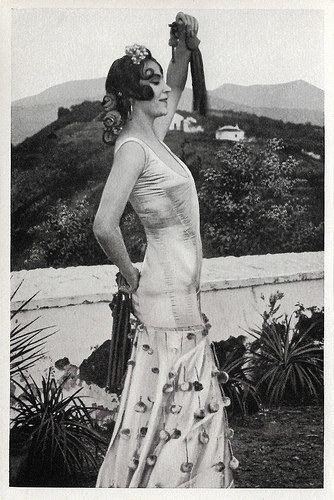
German collector card by Ross Verlag in the series 'Vom Werden deutscher Filmkunst - Der Stumme Film', picture no. 6, group 43. Photo: Asta Nielsen in Der Tod von Sevilla/The Death of Seville (Urban Gad, 1913).
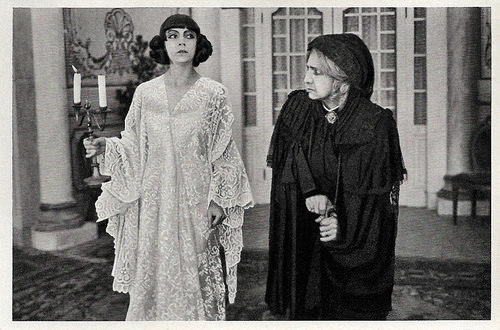
German collector card by Ross Verlag in the series 'Vom Werden deutscher Filmkunst - Der Stumme Film', no. 7, group 43. Photo: Asta Nielsen and Mary Scheller in Das Feuer/The Fire (Urban Gad, 1914).
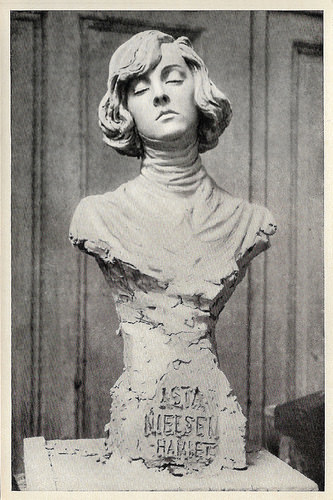
German collector card by Ross Verlag in the series 'Vom Werden deutscher Filmkunst - Der Stumme Film', no. 8, group 43. Photo: Bust of Asta Nielsen as Hamlet.
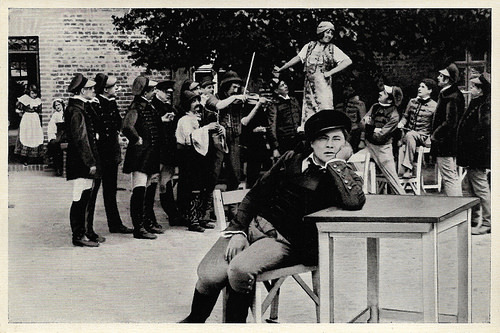
German collector card by Ross Verlag in the series 'Vom Werden deutscher Filmkunst - Der Stumme Film', no. 9, group 40. Photo: Sokal-Film. Paul Wegener and Lyda Salmonova in Der Student von Prag/The Student of Prague (Paul Wegener, Stellan Rye, 1913).
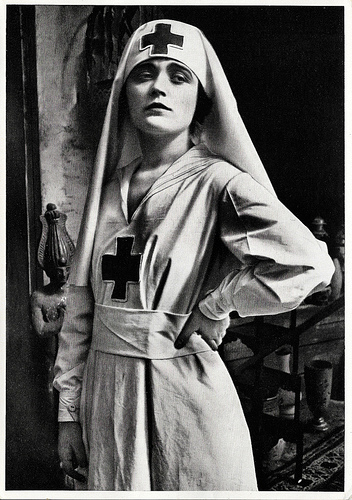
German collector card by Ross Verlag in the series 'Vom Werden deutscher Filmkunst - Der Stumme Film', no. 10, group 40. Photo: Ufa. Publicity still with Pola Negri as a nurse in Vendetta (Georg Jacoby, 1919).
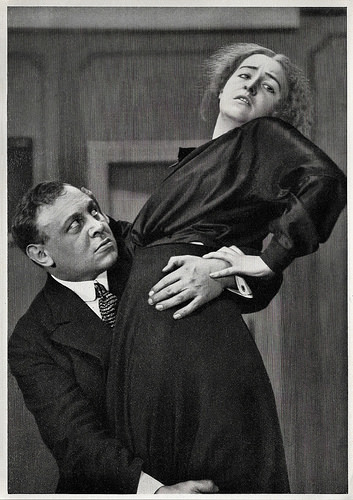
German collector card by Ross Verlag in the series 'Vom Werden deutscher Filmkunst - Der Stumme Film', no. 12, group 40. Photo: Ufa. Emil Jannings and Henny Porten in Die Ehe der Luise Rohrbach/The Marriage of Luise Rohrbach (Rudolf Biebrach, 1917).
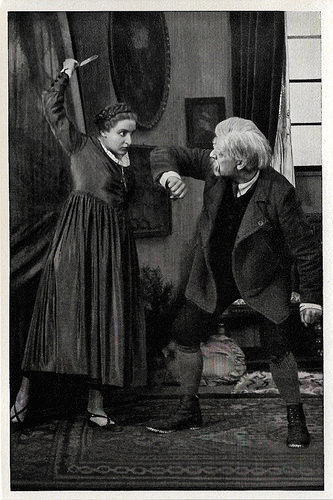
German collector card by Ross Verlag in the series 'Vom Werden deutscher Filmkunst - Der Stumme Film', no. 13, group 43. Photo: Messter-Film. Henny Porten and Rudolf Biebrach in Das Geschlecht derer von Ringwall/The Ringwall Family (Rudolf Biebrach, 1918).
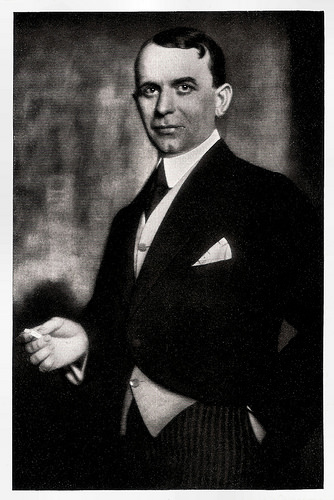
German collector card by Ross Verlag in the series 'Vom Werden deutscher Filmkunst - Der Stumme Film', no. 16, group 43. Photo: Karl Schenker. Viggo Larsen .
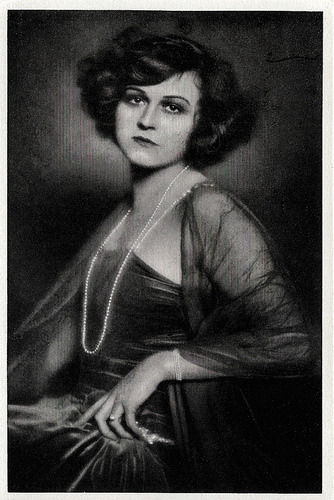
German collector card by Ross Verlag in the series 'Vom Werden deutscher Filmkunst - Der Stumme Film', no. 18, group 43. Photo: Balázs. Hanni Weisse .
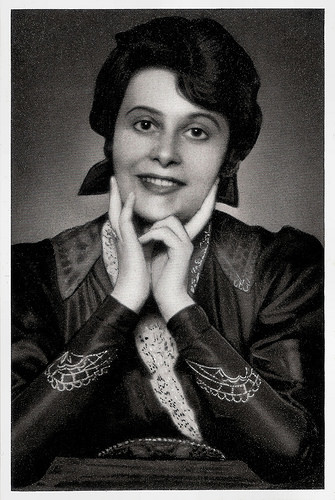
German collector card by Ross Verlag in the series 'Vom Werden deutscher Filmkunst - Der Stumme Film', no. 20, group 43. Photo: Karl Schenker. Caption: " Wanda Treumann , for years the partner of Viggo Larsen ".

German collector card by Ross Verlag in the series 'Vom Werden deutscher Filmkunst - Der Stumme Film', no. 23, group 43. Photo: Ufa. Maria Carmi and Carl de Vogt in Der Weg des Todes/The Road of Death (Robert Reinert, 1916).
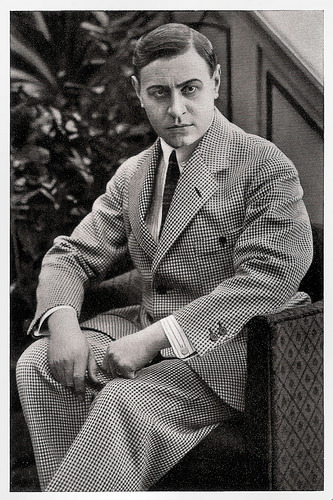
German collector card by Ross Verlag in the series 'Vom Werden deutscher Filmkunst - Der Stumme Film', no, 29, group 43. Caption: Emil Jannings , young and handsome, in his first film Fromont junior, Risler senior. According to other sources Arme Eva (Robert Wiene, 1914) featuring Erna Morena , was his first film. IMDb mentions two Eva films, both by Wiene and both starring Morena and Jannings: Arme Eva (1914) and Frau Eva (1916) - a sequel, a remake or just the same film? However, IMDb mentions that the second was based on a play by Alphonse Daudet! And yes, Revolvy confirms: "It was based on the 1874 novel 'Fromont and Risler' by Alphonse Daudet." And at the German Early Film Database and Filmportal.de, there is no mention of Arme Eva, just of Frau Eva (1915-1916). At Filmportal.de this picture illustrates the film page...
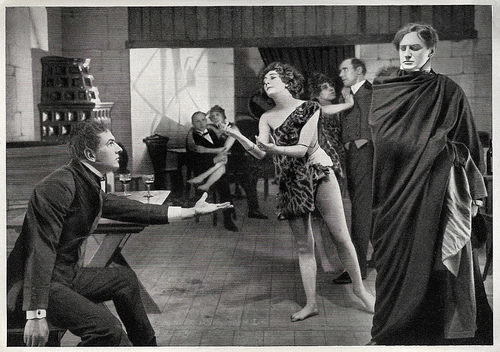
German collector card by Ross Verlag in the series 'Vom Werden deutscher Filmkunst - Der Stumme Film', no. 30, group 40. Photo: Frankfurter Film-Co. Bruno Decarli , Carmen Mara and Harry Liedtke in Rebellenliebe/Rebel Love (Karl Heiland, 1919).
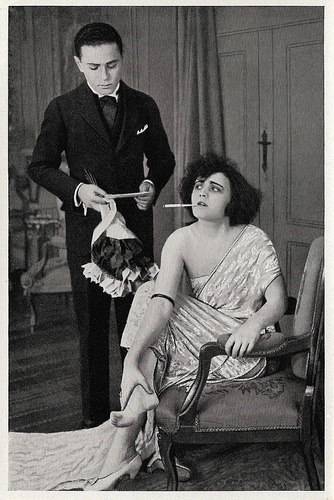
German collector card by Ross Verlag in the series 'Vom Werden deutscher Filmkunst - Der Stumme Film', no. 34, group 43. Photo: Union-Film. Pola Negri and Fritz Schulz in Die Marchesa d'Armiani/The Marquise of Armiani (Alfred Halm, 1920).
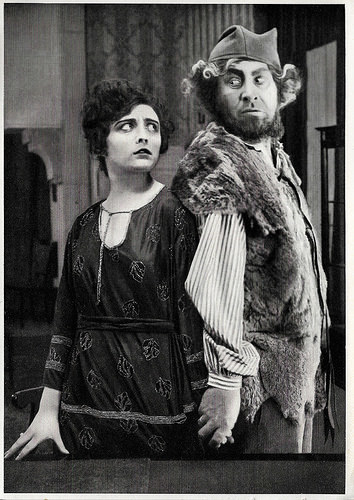
German collector card by Ross Verlag in the series 'Vom Werden deutscher Filmkunst - Der Stumme Film', no. 35, group 40. Photo: Ufa. Pola Negri and Emil Jannings in Vendetta (Georg Jacoby, 1919).
This Ross Verlag Tribute will be continued next week.

German collector card by Ross Verlag in the series 'Vom Werden deutscher Filmkunst - Der Stumme Film', picture no. 6, group 43. Photo: Asta Nielsen in Der Tod von Sevilla/The Death of Seville (Urban Gad, 1913).

German collector card by Ross Verlag in the series 'Vom Werden deutscher Filmkunst - Der Stumme Film', no. 7, group 43. Photo: Asta Nielsen and Mary Scheller in Das Feuer/The Fire (Urban Gad, 1914).

German collector card by Ross Verlag in the series 'Vom Werden deutscher Filmkunst - Der Stumme Film', no. 8, group 43. Photo: Bust of Asta Nielsen as Hamlet.

German collector card by Ross Verlag in the series 'Vom Werden deutscher Filmkunst - Der Stumme Film', no. 9, group 40. Photo: Sokal-Film. Paul Wegener and Lyda Salmonova in Der Student von Prag/The Student of Prague (Paul Wegener, Stellan Rye, 1913).

German collector card by Ross Verlag in the series 'Vom Werden deutscher Filmkunst - Der Stumme Film', no. 10, group 40. Photo: Ufa. Publicity still with Pola Negri as a nurse in Vendetta (Georg Jacoby, 1919).

German collector card by Ross Verlag in the series 'Vom Werden deutscher Filmkunst - Der Stumme Film', no. 12, group 40. Photo: Ufa. Emil Jannings and Henny Porten in Die Ehe der Luise Rohrbach/The Marriage of Luise Rohrbach (Rudolf Biebrach, 1917).

German collector card by Ross Verlag in the series 'Vom Werden deutscher Filmkunst - Der Stumme Film', no. 13, group 43. Photo: Messter-Film. Henny Porten and Rudolf Biebrach in Das Geschlecht derer von Ringwall/The Ringwall Family (Rudolf Biebrach, 1918).

German collector card by Ross Verlag in the series 'Vom Werden deutscher Filmkunst - Der Stumme Film', no. 16, group 43. Photo: Karl Schenker. Viggo Larsen .

German collector card by Ross Verlag in the series 'Vom Werden deutscher Filmkunst - Der Stumme Film', no. 18, group 43. Photo: Balázs. Hanni Weisse .

German collector card by Ross Verlag in the series 'Vom Werden deutscher Filmkunst - Der Stumme Film', no. 20, group 43. Photo: Karl Schenker. Caption: " Wanda Treumann , for years the partner of Viggo Larsen ".

German collector card by Ross Verlag in the series 'Vom Werden deutscher Filmkunst - Der Stumme Film', no. 23, group 43. Photo: Ufa. Maria Carmi and Carl de Vogt in Der Weg des Todes/The Road of Death (Robert Reinert, 1916).

German collector card by Ross Verlag in the series 'Vom Werden deutscher Filmkunst - Der Stumme Film', no, 29, group 43. Caption: Emil Jannings , young and handsome, in his first film Fromont junior, Risler senior. According to other sources Arme Eva (Robert Wiene, 1914) featuring Erna Morena , was his first film. IMDb mentions two Eva films, both by Wiene and both starring Morena and Jannings: Arme Eva (1914) and Frau Eva (1916) - a sequel, a remake or just the same film? However, IMDb mentions that the second was based on a play by Alphonse Daudet! And yes, Revolvy confirms: "It was based on the 1874 novel 'Fromont and Risler' by Alphonse Daudet." And at the German Early Film Database and Filmportal.de, there is no mention of Arme Eva, just of Frau Eva (1915-1916). At Filmportal.de this picture illustrates the film page...

German collector card by Ross Verlag in the series 'Vom Werden deutscher Filmkunst - Der Stumme Film', no. 30, group 40. Photo: Frankfurter Film-Co. Bruno Decarli , Carmen Mara and Harry Liedtke in Rebellenliebe/Rebel Love (Karl Heiland, 1919).

German collector card by Ross Verlag in the series 'Vom Werden deutscher Filmkunst - Der Stumme Film', no. 34, group 43. Photo: Union-Film. Pola Negri and Fritz Schulz in Die Marchesa d'Armiani/The Marquise of Armiani (Alfred Halm, 1920).

German collector card by Ross Verlag in the series 'Vom Werden deutscher Filmkunst - Der Stumme Film', no. 35, group 40. Photo: Ufa. Pola Negri and Emil Jannings in Vendetta (Georg Jacoby, 1919).
This Ross Verlag Tribute will be continued next week.
Published on January 07, 2025 22:00
January 6, 2025
Weiss Ferdl
Weiss Ferdl (1883-1949) was a German actor, humorous folksinger, and author. He was one of the most popular Bavarian film comedians and was mentioned in one breath with Karl Valentin. Between 1928 and 1941, he appeared in 19 films and performed regularly at the Platzl, a well-known Munich theatre. The beloved comic had a dark side and was an outspoken antisemite and Nazi sympathiser.
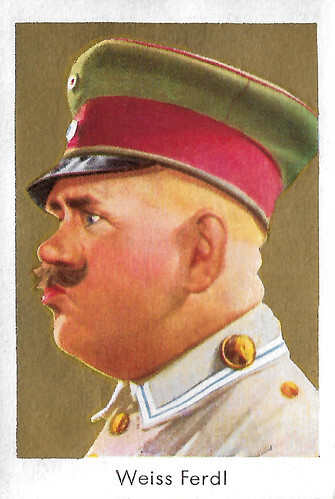
German cigarette card by Salem, Dresden, Series 1, no. 4 (of 180). Photo: Emelka. Weiss Ferdl in Die Mutter der Kompagnie/The Company's Mother (Franz Seitz, 1931).
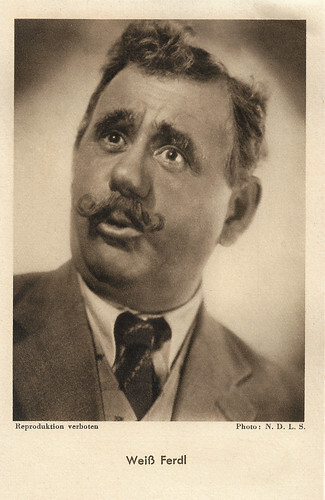
German postcard by "Das Programm von Heute" für Film und Theater G.m.b.H., Stuttgart. Photo: N.D.L.S.
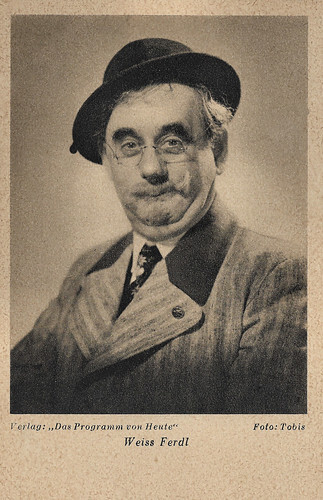
German postcard by "Das Programm von Heute" für Film und Theater G.m.b.H., Stuttgart. Photo: Tobis.
A very sharp tongue
Weiss Ferdl or Weiß-Ferdl was born Ferdinand Weisheitinger in 1883 in Altötting, 96 km (60 miles) east of München (Munich). He was the son of a single waitress and grew up in Altötting with his grandmother. After a short time at the Salzburg Cathedral Singing School and an apprenticeship as a typesetter in Altötting, he moved in with relatives in Munich. He discovered his passion for the stage when he joined the Ernst Karl Folk Singers' Society. From 1903 to 1905 he did his military service in Metz.
In 1907 he was engaged at the Platzl Theatre, a popular restaurant and entertainment venue, which became his home. Just seven years later, he became its director. Ferdl had a very sharp tongue and was well-versed in the thoughts and feelings of the so-called little people, whose wishes, desires and dreams he was able to translate into hearty, critical verses.
During the First World War, he was head of the singing troupe of the 1st Bavarian Reserve Infantry Regiment, known as 'Platzl im Felde'. As the head of the troupe, he directed other folk singers, musicians and comedians. In 1921, together with Sepp Eringer, he again took over the management of the Platzl. Due to his increasing success with audiences, Weiß Ferdl remained loyal to the Platzl until the end of his stage career.
From 1928 to 1940, he also appeared in 18 films and thus became known outside Bavaria. In 1928, he made his film debut with a small part as a Baptist brother in the silent drama Hinter Klostermauern/Behind Monastery Walls (Franz Seitz, 1928), which starred Karl Neubert, Georg Jacoby, and Carl de Vogt . A year later, he appeared in another silent film, Links der Isar – rechts der Spree/Left of the Isar, Right of the Spree (Franz Seitz, 1929), made at the Emelka Studios in Munich.
But the sound film presented a whole new platform for him. For the Ufa in Berlin, he had a supporting part in the Operetta film Der unsterbliche Lump/The Immortal Vagabond (Gustav Ucicky, Joe May, 1930) starring Liane Haid , Gustav Fröhlich and Hans Adalbert Schlettow . He also appeared in the musical Das Lied der Nationen/The Song of the Nations (Rudolf Meinert, 1931) starring Camilla Horn , Igo Sym and Betty Amann . Then he had the starring role in Der Schützenkönig/The Champion Shot (Franz Seitz, 1932) opposite Max Adalbert and Gretl Theimer . The comedy was shot at the Bavaria Studios in Munich. He played the owner of a store in a small Bavarian town, who is angered when a new shop is opened by an arrival from Berlin (Adalbert) who also claims to be a better marksman than the local. It was followed by another starring role for Bavaria in the crime comedy Der Meisterdetektiv/The Master Detective (Franz Seitz, 1933) with Ery Bos and Hans Stüwe .
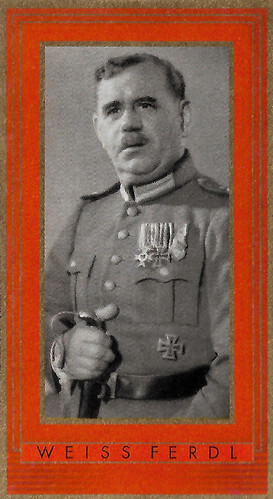
German cigarette card by Ross Verlag in the 'Bunte Filmbilder' series by Polo, series II, no. 447. Photo: Deka-Syndikat-Film.
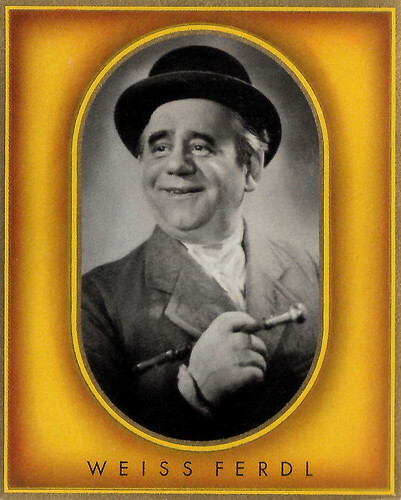
German cigarette card by Ross Verlag in the 'Bunte Filmbilder' series by Greiling AG, no. 152. Photo: Majestic-Syndikat-Film.
I am not an intellectual
In the Nazi era, Weiss Ferdl performed regularly at NSDAP events. He socialised with Munich party celebrities and came to terms with those in power. He visited Hitler on the Obersalzberg as early as 1933 and wrote enthusiastically about it in his book ‘Guat troffa’. He joined the NSDAP in 1937. In the meanwhile, he continued to star in such comedies as Die beiden Seehunde/The Two Seals (Fred Sauer, 1934) in which he played a double role as the unpopular ruler of a small principality and his doppelganger, and Alles weg'n dem Hund/All Because of the Dog (Fred Sauer, 1935) with Julia Serda and child star Peter Bosse .
However, Konjunkturritter/Financial Opportunists (Fritz Kampers, 1934) with Sabine Peters and Hans Adalbert Schlettow was not harmless entertainment. The film's title was a well-known phrase to attack Jews and Konjunkturritter was one of the first openly anti-Semitic films produced under the Nazi regime. Later Bavarian comedies included Befehl ist Befehl/Orders Are Orders (Alwin Elling, 1936) with Trude Hesterberg, and Gordian, der Tyrann/Gordian the Tyrant (Fred Sauer, 1937) with Paul Richter .
During the Nazi era, the popular music show 'Wunschkonzert für die Wehrmacht' (Request Concert for the Wehrmacht) was broadcast on the German radio network every Sunday afternoon. It claimed to broadcast music requested by men in the armed forces, thus uniting the armed forces and the homefront in 'Volksgemeinschaft'. Reich Minister Joseph Goebbels insisted that all German performers contribute to it, and concluded that a film based on it would be even more successful. Indeed, the Propaganda film Wunschkonzert/Request Concert (Eduard von Borsody, 1941) became, after Die große Liebe/The Great Love (Rolf Hansen, 1942) starring Zarah Leander , the most popular film of wartime Germany, reaching the second-highest gross. Weiss Ferdl sang a song in the film, 'Bin ich froh, ich bin kein Intellektueller' (I'm so glad I'm no intellectual). After World War II, the Allied Control Council, which, in 1945, subjected all German-language films then on release to an ideological examination, banned 'Goebbels pet child's' performance. It was released later in West Germany with clearance from the FSK motion picture rating system.
Weiss Ferdl wrote several plays and books. In 1941 he published the book 'Ich bin kein Intellektueller. Ein heiteres Buch' (I am not an intellectual. A cheerful book). Two years later, he published 'Der Freibrief'. That same year, the comedian had to give up his stage career due to a heart condition. After the end of the war, the American military government confiscated the Mercedes of the wealthy folk singer. It was only during this time that he ever travelled by tram, laying the foundations for his later successful song about Line 8.
In the course of denazification, Weiß Ferdl presented himself as a threat to the regime despite his membership in several Nazi sub-organisations. He referred to disputes with the party leadership due to his jokes. In the court proceedings on 27 October 1946, he was sentenced to 2,000 Reichsmark. Weiss Ferdl died of heart failure in Munich in 1949, only one year after the other great comic Karl Valentin. The 65-year-old Ferdl was buried in the Solln forest cemetery. He was 65. In Bavaria, he is still celebrated alongside Karl Valentin. His famous song 'Ein Wagen von der Linie Acht' (A Carriage from Line 8) is still played to this day. It is a mocking song about the Munich people and the trams in Munich. A fountain, centrally located at Munich's Viktualienmarkt, is dedicated to his memory. The Weiß-Ferdl-Mittelschule, a secondary school in Altötting, has a retired blue Munich Tram carriage in the southeast corner of the schoolyard.
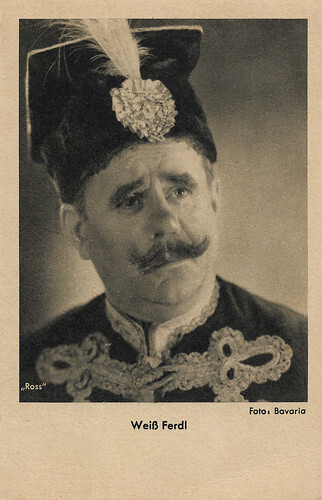
German postcard by Das Programm von Heute für Film und Theater / Ross Verlag, Berlin. Photo: Bavaria. Weiss Ferdl in Der arme Millionär/The Poor Millionaire (Joe Stöckel, 1939).
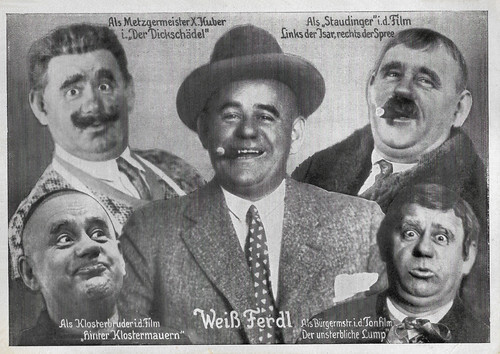
German postcard. Multi-picture postcard from left under Weiss Ferdl as a Baptist brother in the silent drama Hinter Klostermauern/Behind Monastery Walls (Franz Seitz, 1928), as the Burgomaster in Der unsterbliche Lump/The Immortal Vagabond (Gustav Ucicky, Joe May, 1930), as Staudinger in Links der Isar – rechts der Spree/Left of the Isar, Right of the Spree (Franz Seitz, 1929) and as master butcher X. Huber in 'Der Dickschädel'.
Sources: Thomas Staedeli (Cyranos), Volkssaengenrei (German), Wikipedia (English and German) and .

German cigarette card by Salem, Dresden, Series 1, no. 4 (of 180). Photo: Emelka. Weiss Ferdl in Die Mutter der Kompagnie/The Company's Mother (Franz Seitz, 1931).

German postcard by "Das Programm von Heute" für Film und Theater G.m.b.H., Stuttgart. Photo: N.D.L.S.

German postcard by "Das Programm von Heute" für Film und Theater G.m.b.H., Stuttgart. Photo: Tobis.
A very sharp tongue
Weiss Ferdl or Weiß-Ferdl was born Ferdinand Weisheitinger in 1883 in Altötting, 96 km (60 miles) east of München (Munich). He was the son of a single waitress and grew up in Altötting with his grandmother. After a short time at the Salzburg Cathedral Singing School and an apprenticeship as a typesetter in Altötting, he moved in with relatives in Munich. He discovered his passion for the stage when he joined the Ernst Karl Folk Singers' Society. From 1903 to 1905 he did his military service in Metz.
In 1907 he was engaged at the Platzl Theatre, a popular restaurant and entertainment venue, which became his home. Just seven years later, he became its director. Ferdl had a very sharp tongue and was well-versed in the thoughts and feelings of the so-called little people, whose wishes, desires and dreams he was able to translate into hearty, critical verses.
During the First World War, he was head of the singing troupe of the 1st Bavarian Reserve Infantry Regiment, known as 'Platzl im Felde'. As the head of the troupe, he directed other folk singers, musicians and comedians. In 1921, together with Sepp Eringer, he again took over the management of the Platzl. Due to his increasing success with audiences, Weiß Ferdl remained loyal to the Platzl until the end of his stage career.
From 1928 to 1940, he also appeared in 18 films and thus became known outside Bavaria. In 1928, he made his film debut with a small part as a Baptist brother in the silent drama Hinter Klostermauern/Behind Monastery Walls (Franz Seitz, 1928), which starred Karl Neubert, Georg Jacoby, and Carl de Vogt . A year later, he appeared in another silent film, Links der Isar – rechts der Spree/Left of the Isar, Right of the Spree (Franz Seitz, 1929), made at the Emelka Studios in Munich.
But the sound film presented a whole new platform for him. For the Ufa in Berlin, he had a supporting part in the Operetta film Der unsterbliche Lump/The Immortal Vagabond (Gustav Ucicky, Joe May, 1930) starring Liane Haid , Gustav Fröhlich and Hans Adalbert Schlettow . He also appeared in the musical Das Lied der Nationen/The Song of the Nations (Rudolf Meinert, 1931) starring Camilla Horn , Igo Sym and Betty Amann . Then he had the starring role in Der Schützenkönig/The Champion Shot (Franz Seitz, 1932) opposite Max Adalbert and Gretl Theimer . The comedy was shot at the Bavaria Studios in Munich. He played the owner of a store in a small Bavarian town, who is angered when a new shop is opened by an arrival from Berlin (Adalbert) who also claims to be a better marksman than the local. It was followed by another starring role for Bavaria in the crime comedy Der Meisterdetektiv/The Master Detective (Franz Seitz, 1933) with Ery Bos and Hans Stüwe .

German cigarette card by Ross Verlag in the 'Bunte Filmbilder' series by Polo, series II, no. 447. Photo: Deka-Syndikat-Film.

German cigarette card by Ross Verlag in the 'Bunte Filmbilder' series by Greiling AG, no. 152. Photo: Majestic-Syndikat-Film.
I am not an intellectual
In the Nazi era, Weiss Ferdl performed regularly at NSDAP events. He socialised with Munich party celebrities and came to terms with those in power. He visited Hitler on the Obersalzberg as early as 1933 and wrote enthusiastically about it in his book ‘Guat troffa’. He joined the NSDAP in 1937. In the meanwhile, he continued to star in such comedies as Die beiden Seehunde/The Two Seals (Fred Sauer, 1934) in which he played a double role as the unpopular ruler of a small principality and his doppelganger, and Alles weg'n dem Hund/All Because of the Dog (Fred Sauer, 1935) with Julia Serda and child star Peter Bosse .
However, Konjunkturritter/Financial Opportunists (Fritz Kampers, 1934) with Sabine Peters and Hans Adalbert Schlettow was not harmless entertainment. The film's title was a well-known phrase to attack Jews and Konjunkturritter was one of the first openly anti-Semitic films produced under the Nazi regime. Later Bavarian comedies included Befehl ist Befehl/Orders Are Orders (Alwin Elling, 1936) with Trude Hesterberg, and Gordian, der Tyrann/Gordian the Tyrant (Fred Sauer, 1937) with Paul Richter .
During the Nazi era, the popular music show 'Wunschkonzert für die Wehrmacht' (Request Concert for the Wehrmacht) was broadcast on the German radio network every Sunday afternoon. It claimed to broadcast music requested by men in the armed forces, thus uniting the armed forces and the homefront in 'Volksgemeinschaft'. Reich Minister Joseph Goebbels insisted that all German performers contribute to it, and concluded that a film based on it would be even more successful. Indeed, the Propaganda film Wunschkonzert/Request Concert (Eduard von Borsody, 1941) became, after Die große Liebe/The Great Love (Rolf Hansen, 1942) starring Zarah Leander , the most popular film of wartime Germany, reaching the second-highest gross. Weiss Ferdl sang a song in the film, 'Bin ich froh, ich bin kein Intellektueller' (I'm so glad I'm no intellectual). After World War II, the Allied Control Council, which, in 1945, subjected all German-language films then on release to an ideological examination, banned 'Goebbels pet child's' performance. It was released later in West Germany with clearance from the FSK motion picture rating system.
Weiss Ferdl wrote several plays and books. In 1941 he published the book 'Ich bin kein Intellektueller. Ein heiteres Buch' (I am not an intellectual. A cheerful book). Two years later, he published 'Der Freibrief'. That same year, the comedian had to give up his stage career due to a heart condition. After the end of the war, the American military government confiscated the Mercedes of the wealthy folk singer. It was only during this time that he ever travelled by tram, laying the foundations for his later successful song about Line 8.
In the course of denazification, Weiß Ferdl presented himself as a threat to the regime despite his membership in several Nazi sub-organisations. He referred to disputes with the party leadership due to his jokes. In the court proceedings on 27 October 1946, he was sentenced to 2,000 Reichsmark. Weiss Ferdl died of heart failure in Munich in 1949, only one year after the other great comic Karl Valentin. The 65-year-old Ferdl was buried in the Solln forest cemetery. He was 65. In Bavaria, he is still celebrated alongside Karl Valentin. His famous song 'Ein Wagen von der Linie Acht' (A Carriage from Line 8) is still played to this day. It is a mocking song about the Munich people and the trams in Munich. A fountain, centrally located at Munich's Viktualienmarkt, is dedicated to his memory. The Weiß-Ferdl-Mittelschule, a secondary school in Altötting, has a retired blue Munich Tram carriage in the southeast corner of the schoolyard.

German postcard by Das Programm von Heute für Film und Theater / Ross Verlag, Berlin. Photo: Bavaria. Weiss Ferdl in Der arme Millionär/The Poor Millionaire (Joe Stöckel, 1939).

German postcard. Multi-picture postcard from left under Weiss Ferdl as a Baptist brother in the silent drama Hinter Klostermauern/Behind Monastery Walls (Franz Seitz, 1928), as the Burgomaster in Der unsterbliche Lump/The Immortal Vagabond (Gustav Ucicky, Joe May, 1930), as Staudinger in Links der Isar – rechts der Spree/Left of the Isar, Right of the Spree (Franz Seitz, 1929) and as master butcher X. Huber in 'Der Dickschädel'.
Sources: Thomas Staedeli (Cyranos), Volkssaengenrei (German), Wikipedia (English and German) and .
Published on January 06, 2025 22:00
January 5, 2025
Diana Karenne
Ukrainian actress Diana Karenne (18??-1968) was one of the divas of Italian silent cinema. Between 1916 and 1920, Karenne fascinated European audiences with her eccentric dresses and make-up, and with her primadonna behaviour. For a long time, hardly any of her films were available, but in the past few years, several have shown up in the film archives, either as fragments or as full films, and have been shown at festivals like Il Cinema Ritrovato in Bologna, Italy. Russian film historian Tamara Shvediuk recently discovered that Karenne's film career already started before the Revolution in the Russian Empire.
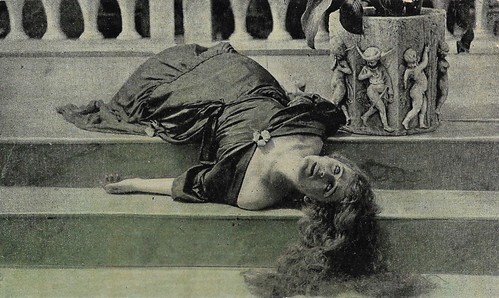
Spanish cromo (collector card) by Chocolate Imperiale, no. 6 of 6. Photo: Sabaudo Film / distr. J. Verdaguer. Diana Karenne in Lea (Diana Karenne, Salvatore Aversano, 1916).
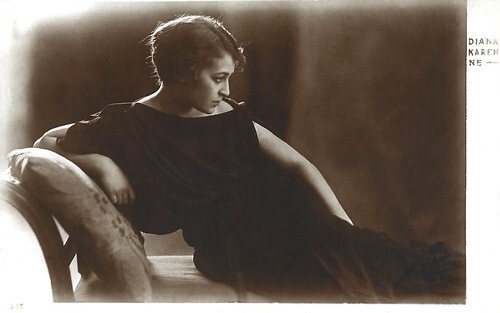
Italian postcard by Soc. A. Bettini, Roma, no. 235. Photo: Riccardo Bettini.
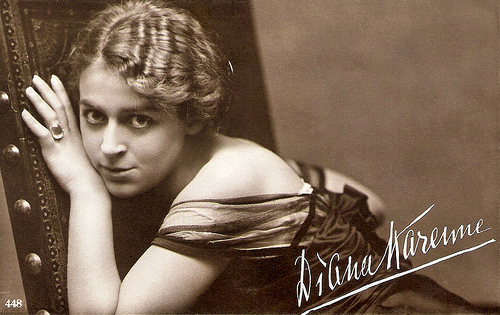
Italian postcard by Ed. A. Traldi, Milano, no. 448.
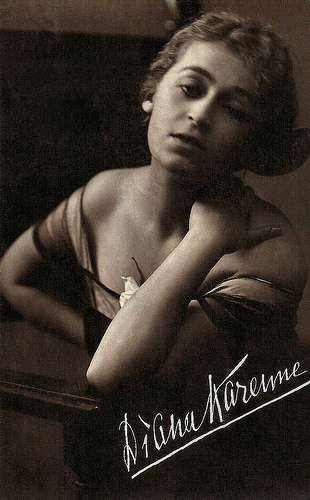
Italian postcard by Fotocelere, Torino.
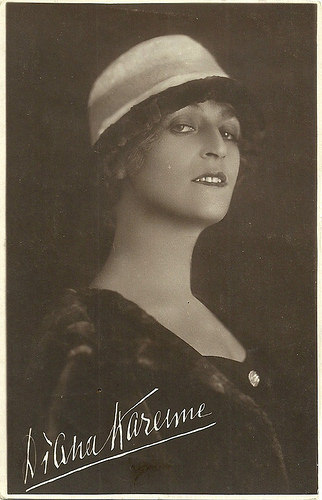
Italian postcard by Fotocelere, Torino.
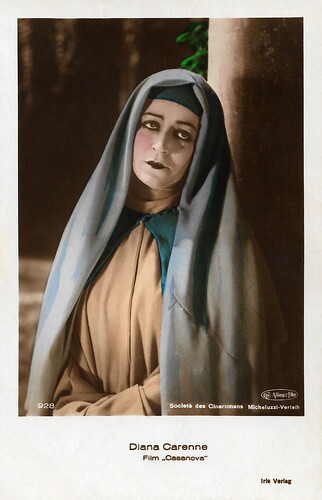
Austrian postcard by Iris Verlag, no. 928. Photo: Société des Cineromans / Micheluzzi-Verleih / Cine Alliance Film. Diana Karenne in Casanova (Alexandre Volkoff, 1927).
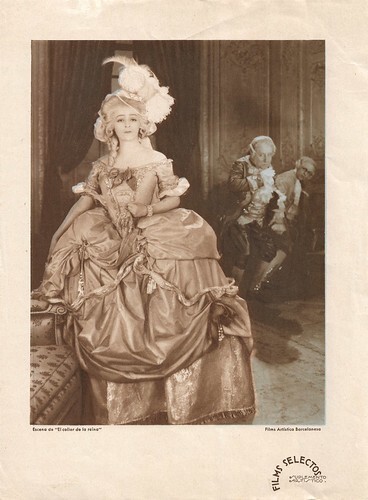
Spanish illustration by Films selectos, Supplemento Artistico. Photo: Films Artistica Barcelonesa. Diana Karenne in Le Collier de la reine/The Queen's Necklace (Tony Lekain, Gaston Ravel, 1929).
Gypsy Passion
In an article in FAScinA 11 (2024), Tamara Shvediuk writes that most of what has been published about Diana Karenne’s life is not true. Karenne’s birth name is unknown. She was most likely born in Kyiv in the Russian Empire (now Ukraine) between 1891 and 1897.
And in 1913, she already performed in Imperial Russia under the name of Dina Karen, in what was her screen debut, Tragedyia dvuch’ sester/The Two Sisters’ Tragedy (?, 1913). Before Shvediuk's rediscovery of this film, it was always thought that she had started her film career in Italy.
Interestingly, she also wrote the script of this film. Sheviduk: "This fact alone is extraordinary because female screenwriters in Russian pre-revolutionary cinema were a handful. The film itself would then be shown on the Russian screens for at least the entire first half of 1914.
The film was produced by one of the most important Russian film companies of the pre-revolutionary period, A. Drankov and A. Taldykin, while its director was never mentioned in the press. It is possible that Karenne also directed this film.'
Her brother was film producer Gregor Rabinovitch, who worked in the German film industry during the 1920s and early 1930s. In 1914 Karen landed in Turin, Italy where she got acquainted with producer Ernesto Maria Pasquali. He launched her as Diana Karenne in Passione tzigana/Gypsy Passion (Umberto Paradisi, 1916). Immediately she became a star, and between 1916 and 1922 Karenne played leads in many successful Italian films.
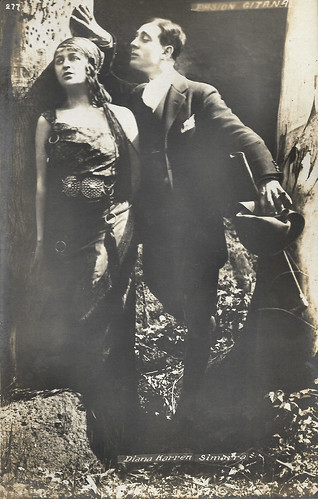
Spanish postcard, no. 277. Diana Karenne and Giovanni Cimara in Passione tsigana/Gypsy Passion (Ernesto Maria Pasquali, 1916). This film was Karenne's debut in Italian silent cinema.
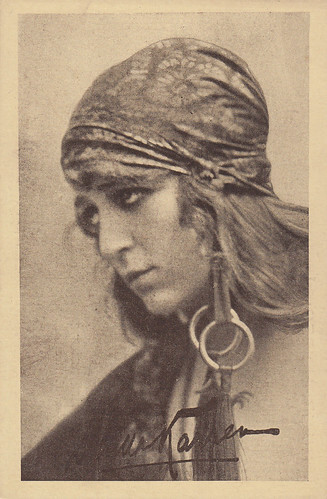
Italian postcard by O.P.E.S. Torino. Diana Karenne in Passione tsigana/Gypsy Passion (Ernesto Maria Pasquali, 1916). Collection: Marlene Pilaete.
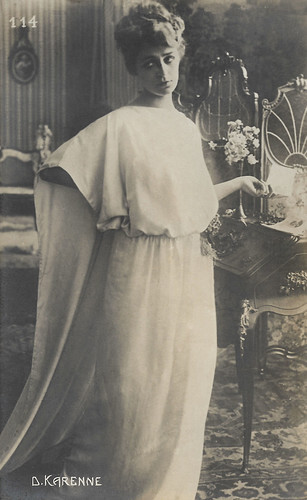
Italian postcard, no. 114.
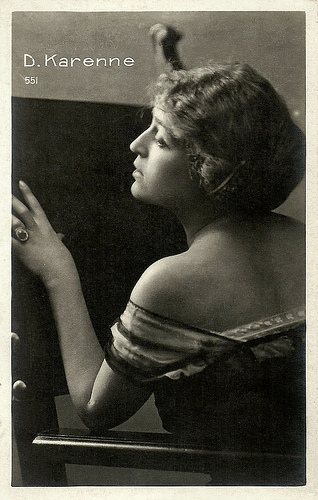
Italian postcard by Vettori, Bologna, no. 551.
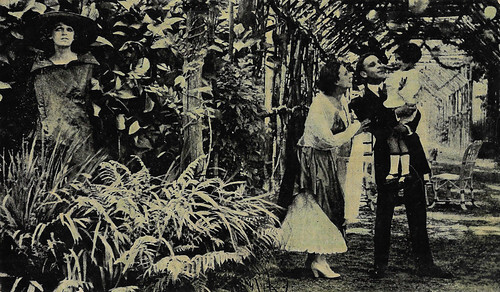
Spanish cromo (collector card) by Chocolate Imperiale, no. 4 of 6. Photo: J. Verdaguer / Sabaudo Film. Diana Karenne (left), Alfonsina Pieri and Umberto Casilini in Lea (Diana Karenne, Salvatore Aversano, 1916).
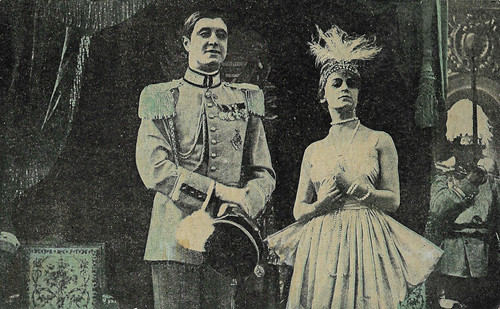
Spanish collector card by Chocolate Imperiale, no. 4 out of 6. Photo: Pasquali / Vay Film / J. Verdaguer / Prod. Armando Vay, Milano. Diana Karenne and Angelo Ferrari in Sofia di Kravonia (Ernesto Maria Pasquali, 1916), based on the book by Anthony Hope.
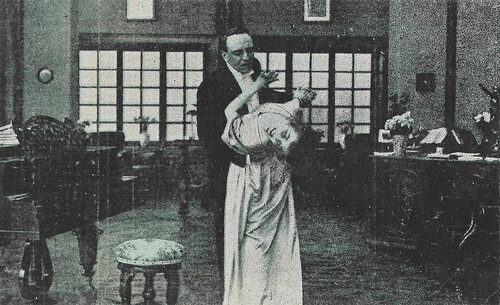
Spanish collector card (cromo, minicard) by Chocolat Imperiale, Barcelona, card 5 of 6. Photo: J. Verdaguer, Barcelona / David-Karenne Film. Diana Karenne and Alberto Capozzi in the Italian silent film Justice de femme! (Diana Karenne, 1917), based on the novel by Daniel Lesuer.
Maud, don't play with my passion
After films directed by Pasquali such as La contessa Arsenia (1916), Quand l'amour réfleurit (1916), Oltre la vita, oltre la morte (1916), and Sofia di Kravonia (1916), Diana Karenne managed to write and direct her films, and she even designed her film posters.
After Lea (Diana Karenne, Salvatore Aversano, 1916), Il romanzo di Maud/Maud's Romance (1917) was the second film Karenne directed herself. She also played the lead in both films.
Il romanzo di Maud, based on the French novel 'Les demi-vierges' (1895) by Marcel Prévost, tells the tale of the free-spirited Maud de Vouvres. Maud's lover is an opportunistic and dubious gentleman, Giuliano di Suberceaux. When their relationship has an impasse, Maud sees new perspectives in Massimo, a provincial enamoured with her.
Giuliano doesn't give up and forces her to see him in secret. When Maud and Massimo are married, Giuliano tells poor Massimo the truth, but Maud denies all and chases him away. When Giuliano menaces to kill himself, she coldly responds that she doesn't care.
When Massimo forces her to tell, Maud admits her former love but states Massimo is now her only love. Massimo, though, abandons her, unable to forgive her. The film was heavily censored in Italy. After its first release, it always circulated as Les demi-vierges, in particular abroad.
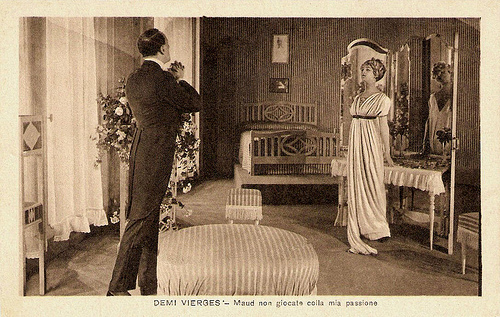
Italian postcard by Film Soc. An. Ambrosio, Torino. "Maud, don't play with my passion", her lover Giuliano implores her in Il romanzo di Maud (1917).
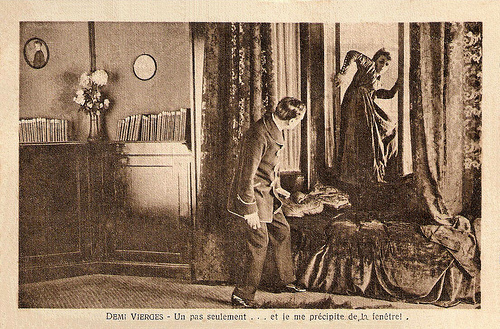
Italian postcard by Film Soc. An. Ambrosio, Torino. "One step further and I throw myself from the window", Maud (Diana Karenne) says in Il romanzo di Maud (1917).
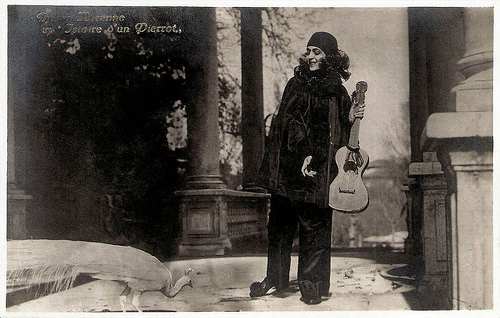
Italian postcard by G.B. Falci, Milano. Diana Karenne in Pierrot/Histoire d'un Pierrot (1917).
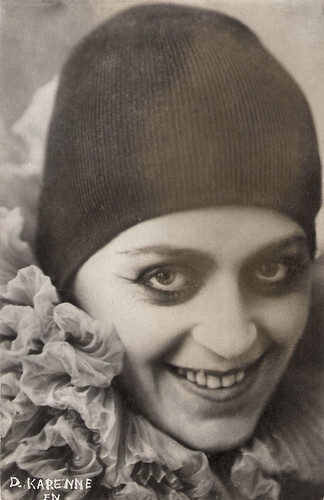
Spanish postcard. Diana Karenne in Pierrot/Histoire d'un Pierrot (1917).
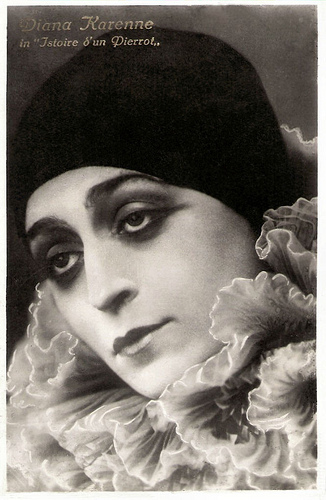
Italian postcard for Pierrot/Histoire d'un Pierrot (1917).
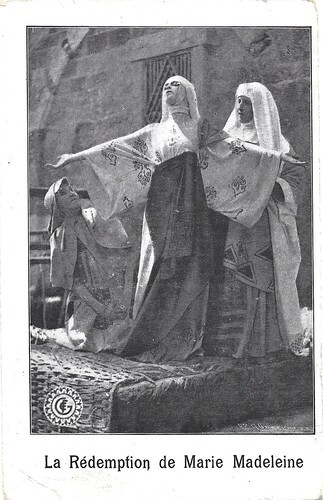
Belgian postcard. Diana Karenne in Redenzione/Maria di Magdala (Carmine Gallone, 1919), presented as Redemption de Marie Madeleine at the cinema Oud-Gend in Ghent, Belgium, between 17 and 23 September 1920. The distributor was the French company Gaumont.
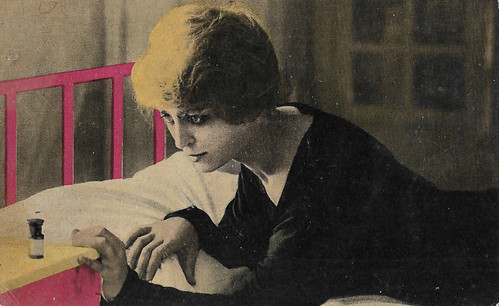
Spanish cromo by Chocolat Imperiale, Barcelona, no. 6 of 6. Photo: Verdaguer / Tiber Film. Diana Karenne in La peccatrice casta (Diana Karenne, Gennaro Righelli, 1919).
Pierrot
After her years at the Pasquali company, Diana Karenne worked at Tiber Film, where she had her own 'Diana Karenne film series' including La peccatrice casta (1918) which she directed herself. In addition, in 1917 the David-Karenne film company was founded. Karenne eventually took over it herself, renaming it Karenne Film.
The film company produced such films as Pierrrot/Histoire d'un Pierrot (1917) and Justice de femme (1917), both directed by herself.
In 1920 Karenne's most successful film was a Medusa production: Maria di Magdala (1919), later renamed Redenzione, and directed by Carmine Gallone. Giulio Antamoro directed Karenne in her last film for Tiber: Zoya (Giulio Antamoro, 1920) with André Habay .
In 1919 Karenne exchanged Tiber Film for Tespi Film, where she did films like Ave Maria (1920). Afterwards, he directed her at Nova Film in the popular Miss Dorothy (Giulio Antamoro, 1920) with Carmen Boni , and Smarrita (Giulio Antamoro, 1921). All were produced by Karenne Film.
Inspired by the first film superstar Asta Nielsen , Karenne played women who opposed society. Between 1916 and 1920 Karenne fascinated audiences with her eccentric dresses and make-up, and her primadonna behaviour. Critics didn't accept her transgressive characters but the public flocked to see her films.
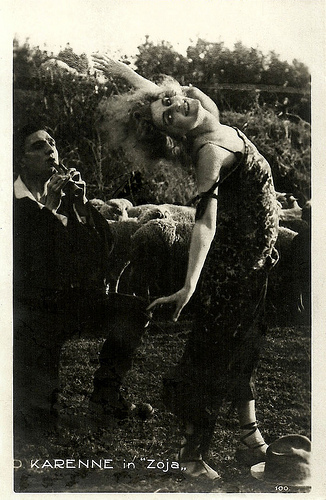
Italian postcard by Vettori, Bologna. Diana Karenne Zoya/Zoja (Giulio Antamoro, 1920), a Tiber Film production. The man left might be Mario Parpagnoli .
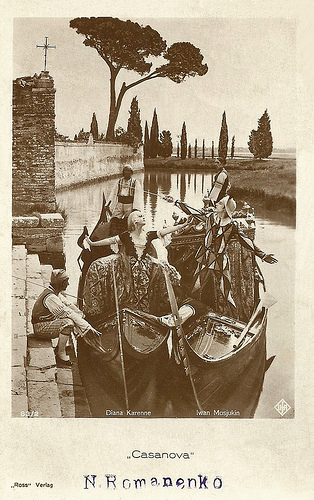
German postcard by Ross Verlag, no. 83/2. Photo: Ufa. Publicity still of Diana Karenne and Ivan Mozzhukhin in Casanova (Alexandre Volkoff, 1927). This scene was shot near the Venice cemetery Isola di San Michele.
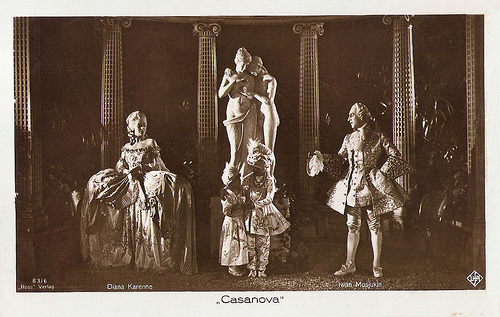
German postcard by Ross Verlag, no. 83/6. Photo: Ufa. Publicity still of Diana Karenne and Ivan Mozzhukhin in Casanova (Alexandre Volkoff, 1927).
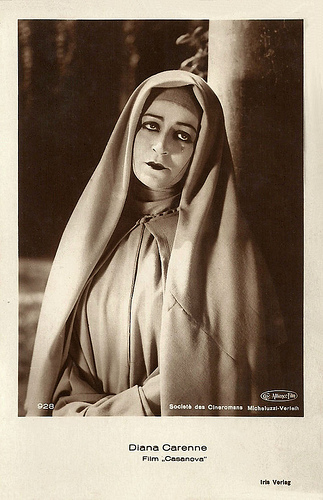
Austrian postcard by Iris Verlag, no. 928. Photo: Société des Cineromans / Micheluzzi-Verleih / Cine Alliance Film. Publicity still for Casanova (Alexandre Volkoff, 1927).
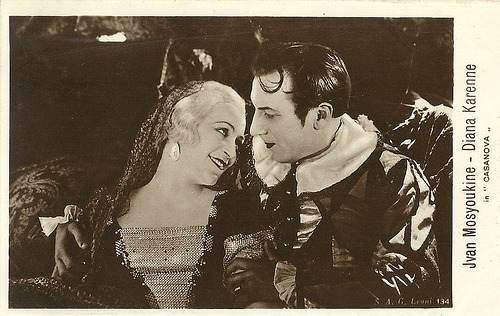
Italian postcard by S.A.G. Leoni, no. 134. Photo: publicity still of Diana Karenne and Ivan Mozzhukhin in Casanova (Alexandre Volkoff, 1927).
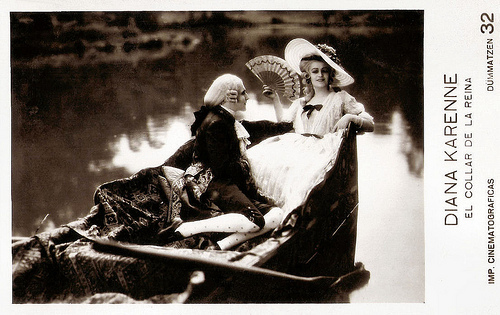
Spanish postcard by PD / Imp. Cinematorgaphicas Dümmatzen, no. 32. Photo: publicity still for Le collier de la Reine/The Queen's Necklace (Tony Lekain, Gaston Ravel, 1929).
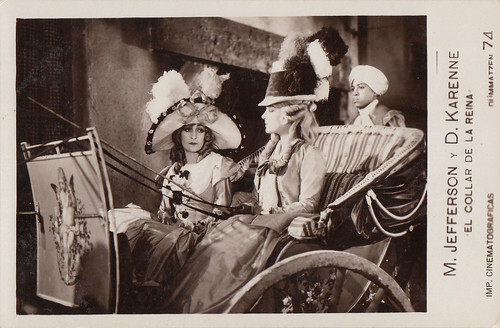
Spanish postcard by Dümmatzen, no. 74. Diana Karenne and Marcelle Jefferson-Cohn (a.k.a. Marcelle Chantal) in Le collier de la reine/The Queen's Necklace (Tony Lekain, Gaston Ravel, 1929). Collection: Marlene Pilaete.
Casanova's major lover
In 1921, when things went bad for the Italian film industry, Diana Karenne moved to Paris and later to Berlin. In Germany she had major roles such as the title role in Marie Antoinette (Rudolf Meinert, 1922), and as one of Casanova's lovers in the visually splendid Casanova (Alexandre Volkoff, 1926) starring Ivan Mozzhukhin .
Other directors of her films were Robert Wiene (Das Spiel mit dem Feuer/Playing With Fire (1921)), Richard Oswald (Die Frau von vierzig Jahren/A Forty Years Old Woman (1925)), Yakov Protazananov (L'ombre de péché/The Shadow of Sin (1923)), and Gaston Ravel (Le collier de la reine/The Queen's Necklace (1929)).
When the sound film arrived, Diana Karenne retired from the film business. She withdrew with her husband to the German city of Aachen, only reappearing once in a bit part in Manon Lescaut (Carmine Gallone, 1940), an Italian production derived from the work of Abbé Prévost, starring Alida Valli and Vittorio de Sica .
Karenne was also a painter, musician and poet. According to film historian Vittorio Martinelli and other sources, Karenne was heavily injured by the Allied bombing of Aachen and she remained in a coma for three months, never regaining consciousness. She died in October 1940. Tamara Shvediuk: "This is not totally false because, in a sense, the actress Diana Karenne disappeared exactly that year. But only some Russian sources shed some light on her private life starting from the 1920s. In that period, she met Russian acmeist poet Nikolay Otzoup and they married at the end of the decade. For a few years, she continued to work in cinema while, simultaneously, compiling a series of critical texts on films which were then published in several Russian-language Parisian newspapers.
However, by the 1930s, she was fully devoted to married life and the work of her husband, who in turn wrote two books where he described and idolized her. One of these, 'Dnevnik v stikhakh' (Diary in verse), was a memoir by Otzoup that is actually a very good resource also for Karenne’s biography." After her husband died in 1958, Diana Karenne edited his papers in two imposing volumes 'Zhizn’ i smert’ (Life and Death). She relapsed into a depression. Diana Karenne outlived her husband for ten years, and died in 1968 in Lausanne, Switzerland, from a heart attack.
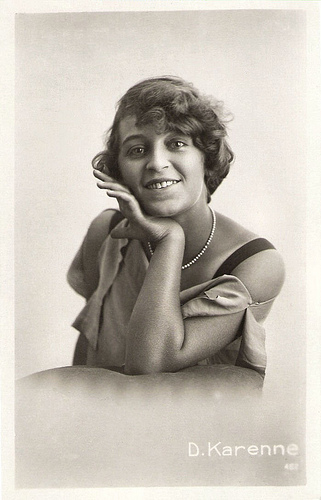
Italian postcard by Photo Vettori, Bologna.
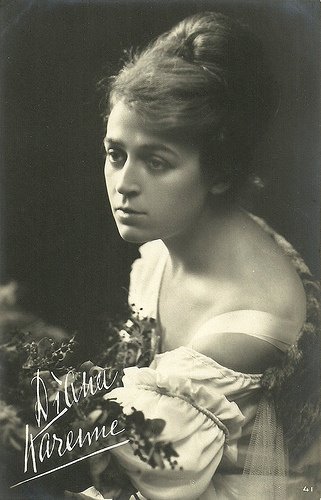
Italian postcard by Fotocelere, Torino, no. 41.
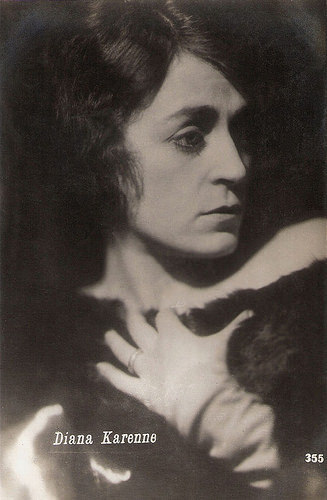
Italian postcard, no. 355.
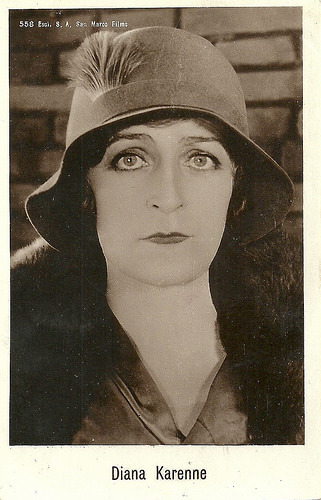
Italian postcard by Esci, S.A., no. 558 Photo: San Marco Films.
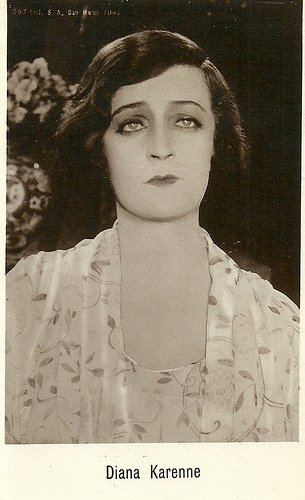
Italian postcard by G.B. Falci, Milano, no. 567. Photo: Distr. SA San Marco Films.
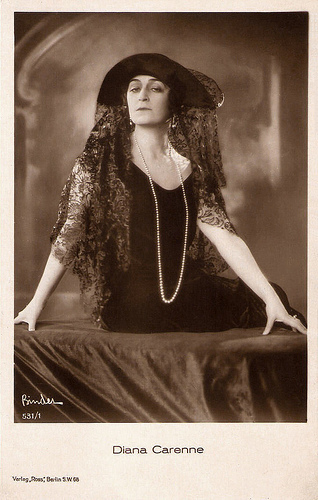
German Postcard by Ross Verlag, Berlin, no. 531/1, 1919-1924. Photo: Alex Binder.
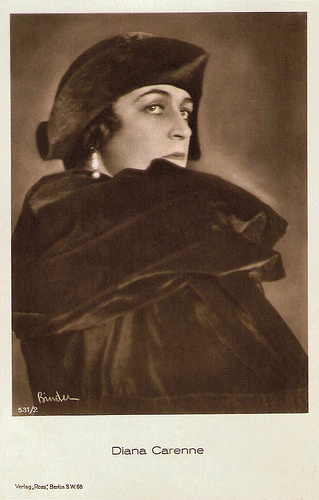
German Postcard by Ross Verlag, Berlin, no. 531/2, 1919-1924. Photo: Alex Binder.
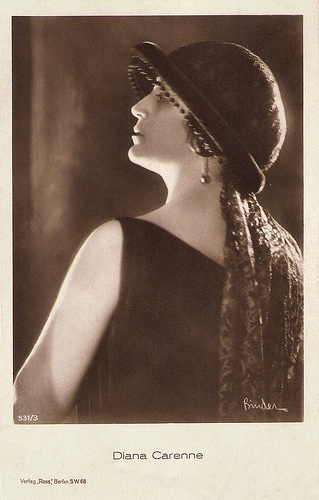
German Postcard by Ross Verlag, Berlin, no. 531/3, 1919-1924. Photo: Alex Binder.
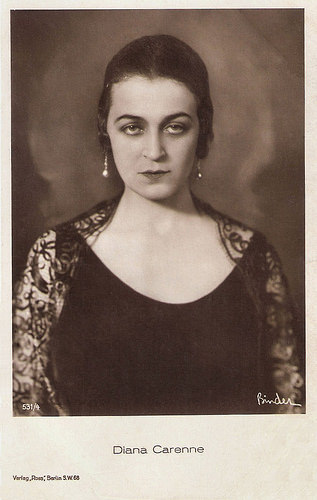
German postcard by Ross Verlag, Berlin, no. 531/4, 1919-1924. Photo: Alex Binder.
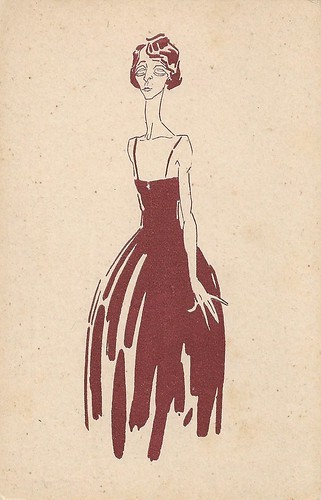
Italian postcard. Caricature by Sandro Properzi for Le Maschere, Rome.
We thank Tamara Shvediuk for sharing her article 'Diana Karenne - A Genuine Tenebrosa in Life and Onscreen' (FAScinA 11, 2024) with us.
Other sources: Marlène Pilaete (CinéArtistes - French), Vittorio Martinelli (Le dive del silenzio), Vittorio Martinelli (Il cinema muto italiano, 1917), Wikipedia (German), and .

Spanish cromo (collector card) by Chocolate Imperiale, no. 6 of 6. Photo: Sabaudo Film / distr. J. Verdaguer. Diana Karenne in Lea (Diana Karenne, Salvatore Aversano, 1916).

Italian postcard by Soc. A. Bettini, Roma, no. 235. Photo: Riccardo Bettini.

Italian postcard by Ed. A. Traldi, Milano, no. 448.

Italian postcard by Fotocelere, Torino.

Italian postcard by Fotocelere, Torino.

Austrian postcard by Iris Verlag, no. 928. Photo: Société des Cineromans / Micheluzzi-Verleih / Cine Alliance Film. Diana Karenne in Casanova (Alexandre Volkoff, 1927).

Spanish illustration by Films selectos, Supplemento Artistico. Photo: Films Artistica Barcelonesa. Diana Karenne in Le Collier de la reine/The Queen's Necklace (Tony Lekain, Gaston Ravel, 1929).
Gypsy Passion
In an article in FAScinA 11 (2024), Tamara Shvediuk writes that most of what has been published about Diana Karenne’s life is not true. Karenne’s birth name is unknown. She was most likely born in Kyiv in the Russian Empire (now Ukraine) between 1891 and 1897.
And in 1913, she already performed in Imperial Russia under the name of Dina Karen, in what was her screen debut, Tragedyia dvuch’ sester/The Two Sisters’ Tragedy (?, 1913). Before Shvediuk's rediscovery of this film, it was always thought that she had started her film career in Italy.
Interestingly, she also wrote the script of this film. Sheviduk: "This fact alone is extraordinary because female screenwriters in Russian pre-revolutionary cinema were a handful. The film itself would then be shown on the Russian screens for at least the entire first half of 1914.
The film was produced by one of the most important Russian film companies of the pre-revolutionary period, A. Drankov and A. Taldykin, while its director was never mentioned in the press. It is possible that Karenne also directed this film.'
Her brother was film producer Gregor Rabinovitch, who worked in the German film industry during the 1920s and early 1930s. In 1914 Karen landed in Turin, Italy where she got acquainted with producer Ernesto Maria Pasquali. He launched her as Diana Karenne in Passione tzigana/Gypsy Passion (Umberto Paradisi, 1916). Immediately she became a star, and between 1916 and 1922 Karenne played leads in many successful Italian films.

Spanish postcard, no. 277. Diana Karenne and Giovanni Cimara in Passione tsigana/Gypsy Passion (Ernesto Maria Pasquali, 1916). This film was Karenne's debut in Italian silent cinema.

Italian postcard by O.P.E.S. Torino. Diana Karenne in Passione tsigana/Gypsy Passion (Ernesto Maria Pasquali, 1916). Collection: Marlene Pilaete.

Italian postcard, no. 114.

Italian postcard by Vettori, Bologna, no. 551.

Spanish cromo (collector card) by Chocolate Imperiale, no. 4 of 6. Photo: J. Verdaguer / Sabaudo Film. Diana Karenne (left), Alfonsina Pieri and Umberto Casilini in Lea (Diana Karenne, Salvatore Aversano, 1916).

Spanish collector card by Chocolate Imperiale, no. 4 out of 6. Photo: Pasquali / Vay Film / J. Verdaguer / Prod. Armando Vay, Milano. Diana Karenne and Angelo Ferrari in Sofia di Kravonia (Ernesto Maria Pasquali, 1916), based on the book by Anthony Hope.

Spanish collector card (cromo, minicard) by Chocolat Imperiale, Barcelona, card 5 of 6. Photo: J. Verdaguer, Barcelona / David-Karenne Film. Diana Karenne and Alberto Capozzi in the Italian silent film Justice de femme! (Diana Karenne, 1917), based on the novel by Daniel Lesuer.
Maud, don't play with my passion
After films directed by Pasquali such as La contessa Arsenia (1916), Quand l'amour réfleurit (1916), Oltre la vita, oltre la morte (1916), and Sofia di Kravonia (1916), Diana Karenne managed to write and direct her films, and she even designed her film posters.
After Lea (Diana Karenne, Salvatore Aversano, 1916), Il romanzo di Maud/Maud's Romance (1917) was the second film Karenne directed herself. She also played the lead in both films.
Il romanzo di Maud, based on the French novel 'Les demi-vierges' (1895) by Marcel Prévost, tells the tale of the free-spirited Maud de Vouvres. Maud's lover is an opportunistic and dubious gentleman, Giuliano di Suberceaux. When their relationship has an impasse, Maud sees new perspectives in Massimo, a provincial enamoured with her.
Giuliano doesn't give up and forces her to see him in secret. When Maud and Massimo are married, Giuliano tells poor Massimo the truth, but Maud denies all and chases him away. When Giuliano menaces to kill himself, she coldly responds that she doesn't care.
When Massimo forces her to tell, Maud admits her former love but states Massimo is now her only love. Massimo, though, abandons her, unable to forgive her. The film was heavily censored in Italy. After its first release, it always circulated as Les demi-vierges, in particular abroad.

Italian postcard by Film Soc. An. Ambrosio, Torino. "Maud, don't play with my passion", her lover Giuliano implores her in Il romanzo di Maud (1917).

Italian postcard by Film Soc. An. Ambrosio, Torino. "One step further and I throw myself from the window", Maud (Diana Karenne) says in Il romanzo di Maud (1917).

Italian postcard by G.B. Falci, Milano. Diana Karenne in Pierrot/Histoire d'un Pierrot (1917).

Spanish postcard. Diana Karenne in Pierrot/Histoire d'un Pierrot (1917).

Italian postcard for Pierrot/Histoire d'un Pierrot (1917).

Belgian postcard. Diana Karenne in Redenzione/Maria di Magdala (Carmine Gallone, 1919), presented as Redemption de Marie Madeleine at the cinema Oud-Gend in Ghent, Belgium, between 17 and 23 September 1920. The distributor was the French company Gaumont.

Spanish cromo by Chocolat Imperiale, Barcelona, no. 6 of 6. Photo: Verdaguer / Tiber Film. Diana Karenne in La peccatrice casta (Diana Karenne, Gennaro Righelli, 1919).
Pierrot
After her years at the Pasquali company, Diana Karenne worked at Tiber Film, where she had her own 'Diana Karenne film series' including La peccatrice casta (1918) which she directed herself. In addition, in 1917 the David-Karenne film company was founded. Karenne eventually took over it herself, renaming it Karenne Film.
The film company produced such films as Pierrrot/Histoire d'un Pierrot (1917) and Justice de femme (1917), both directed by herself.
In 1920 Karenne's most successful film was a Medusa production: Maria di Magdala (1919), later renamed Redenzione, and directed by Carmine Gallone. Giulio Antamoro directed Karenne in her last film for Tiber: Zoya (Giulio Antamoro, 1920) with André Habay .
In 1919 Karenne exchanged Tiber Film for Tespi Film, where she did films like Ave Maria (1920). Afterwards, he directed her at Nova Film in the popular Miss Dorothy (Giulio Antamoro, 1920) with Carmen Boni , and Smarrita (Giulio Antamoro, 1921). All were produced by Karenne Film.
Inspired by the first film superstar Asta Nielsen , Karenne played women who opposed society. Between 1916 and 1920 Karenne fascinated audiences with her eccentric dresses and make-up, and her primadonna behaviour. Critics didn't accept her transgressive characters but the public flocked to see her films.

Italian postcard by Vettori, Bologna. Diana Karenne Zoya/Zoja (Giulio Antamoro, 1920), a Tiber Film production. The man left might be Mario Parpagnoli .

German postcard by Ross Verlag, no. 83/2. Photo: Ufa. Publicity still of Diana Karenne and Ivan Mozzhukhin in Casanova (Alexandre Volkoff, 1927). This scene was shot near the Venice cemetery Isola di San Michele.

German postcard by Ross Verlag, no. 83/6. Photo: Ufa. Publicity still of Diana Karenne and Ivan Mozzhukhin in Casanova (Alexandre Volkoff, 1927).

Austrian postcard by Iris Verlag, no. 928. Photo: Société des Cineromans / Micheluzzi-Verleih / Cine Alliance Film. Publicity still for Casanova (Alexandre Volkoff, 1927).

Italian postcard by S.A.G. Leoni, no. 134. Photo: publicity still of Diana Karenne and Ivan Mozzhukhin in Casanova (Alexandre Volkoff, 1927).

Spanish postcard by PD / Imp. Cinematorgaphicas Dümmatzen, no. 32. Photo: publicity still for Le collier de la Reine/The Queen's Necklace (Tony Lekain, Gaston Ravel, 1929).

Spanish postcard by Dümmatzen, no. 74. Diana Karenne and Marcelle Jefferson-Cohn (a.k.a. Marcelle Chantal) in Le collier de la reine/The Queen's Necklace (Tony Lekain, Gaston Ravel, 1929). Collection: Marlene Pilaete.
Casanova's major lover
In 1921, when things went bad for the Italian film industry, Diana Karenne moved to Paris and later to Berlin. In Germany she had major roles such as the title role in Marie Antoinette (Rudolf Meinert, 1922), and as one of Casanova's lovers in the visually splendid Casanova (Alexandre Volkoff, 1926) starring Ivan Mozzhukhin .
Other directors of her films were Robert Wiene (Das Spiel mit dem Feuer/Playing With Fire (1921)), Richard Oswald (Die Frau von vierzig Jahren/A Forty Years Old Woman (1925)), Yakov Protazananov (L'ombre de péché/The Shadow of Sin (1923)), and Gaston Ravel (Le collier de la reine/The Queen's Necklace (1929)).
When the sound film arrived, Diana Karenne retired from the film business. She withdrew with her husband to the German city of Aachen, only reappearing once in a bit part in Manon Lescaut (Carmine Gallone, 1940), an Italian production derived from the work of Abbé Prévost, starring Alida Valli and Vittorio de Sica .
Karenne was also a painter, musician and poet. According to film historian Vittorio Martinelli and other sources, Karenne was heavily injured by the Allied bombing of Aachen and she remained in a coma for three months, never regaining consciousness. She died in October 1940. Tamara Shvediuk: "This is not totally false because, in a sense, the actress Diana Karenne disappeared exactly that year. But only some Russian sources shed some light on her private life starting from the 1920s. In that period, she met Russian acmeist poet Nikolay Otzoup and they married at the end of the decade. For a few years, she continued to work in cinema while, simultaneously, compiling a series of critical texts on films which were then published in several Russian-language Parisian newspapers.
However, by the 1930s, she was fully devoted to married life and the work of her husband, who in turn wrote two books where he described and idolized her. One of these, 'Dnevnik v stikhakh' (Diary in verse), was a memoir by Otzoup that is actually a very good resource also for Karenne’s biography." After her husband died in 1958, Diana Karenne edited his papers in two imposing volumes 'Zhizn’ i smert’ (Life and Death). She relapsed into a depression. Diana Karenne outlived her husband for ten years, and died in 1968 in Lausanne, Switzerland, from a heart attack.

Italian postcard by Photo Vettori, Bologna.

Italian postcard by Fotocelere, Torino, no. 41.

Italian postcard, no. 355.

Italian postcard by Esci, S.A., no. 558 Photo: San Marco Films.

Italian postcard by G.B. Falci, Milano, no. 567. Photo: Distr. SA San Marco Films.

German Postcard by Ross Verlag, Berlin, no. 531/1, 1919-1924. Photo: Alex Binder.

German Postcard by Ross Verlag, Berlin, no. 531/2, 1919-1924. Photo: Alex Binder.

German Postcard by Ross Verlag, Berlin, no. 531/3, 1919-1924. Photo: Alex Binder.

German postcard by Ross Verlag, Berlin, no. 531/4, 1919-1924. Photo: Alex Binder.

Italian postcard. Caricature by Sandro Properzi for Le Maschere, Rome.
We thank Tamara Shvediuk for sharing her article 'Diana Karenne - A Genuine Tenebrosa in Life and Onscreen' (FAScinA 11, 2024) with us.
Other sources: Marlène Pilaete (CinéArtistes - French), Vittorio Martinelli (Le dive del silenzio), Vittorio Martinelli (Il cinema muto italiano, 1917), Wikipedia (German), and .
Published on January 05, 2025 22:00
January 4, 2025
Marie McDonald
American singer and actress Marie McDonald (1923-1965) was nicknamed 'The Body'. She became one of Hollywood's most popular pin-up girls during World War II.
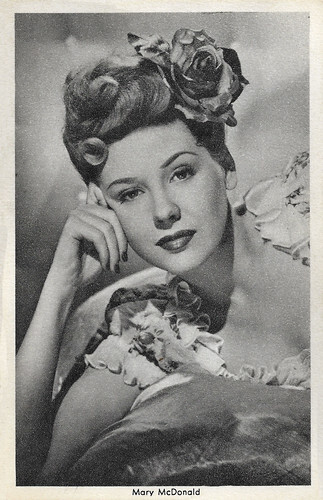
Vintage postcard.
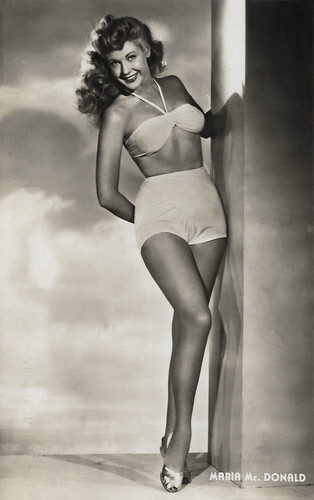
Spanish postcard.
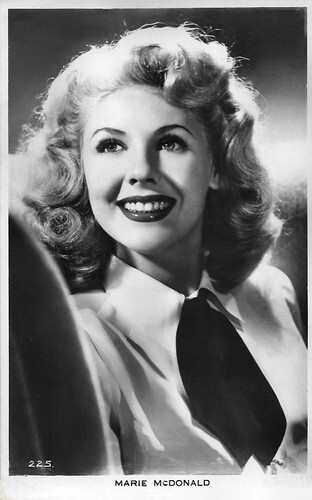
British Real Photograph postcard, no. 225.
The Queen of Coney Island
Marie McDonald was born Cora Marie Frye in Burgin, Kentucky, in 1923. She was the daughter of Everett 'Ed' Frye and Marie Taboni née McDonald who performed in the Ziegfeld Follies. After her parents divorced, she eventually moved with her mother and stepfather to Yonkers, New York. At the age of 15, Marie began competing in numerous beauty pageants and was named 'The Queen of Coney Island'. She dropped out of school and began modelling.
In 1939, McDonald was named 'Miss New York State', but subsequently lost at the 'Miss America' pageant. She debuted in 'George White's Scandals of 1939'. The following year, at age 17, she landed a showgirl role in the Broadway production at the Earl Carroll Theatre called 'Earl Carroll's Vanities'.
Shortly thereafter, she moved to Hollywood hoping to develop a film career. She continued modelling and to work for the owner of the Broadway theatre as a showgirl at his Sunset Boulevard nightclub. She was the model used by illustrator Alex Raymond for the Dale Arden and Princess Aura creations for the Flash Gordon comic strip.
After auditioning for Tommy Dorsey in 1940, she joined Dorsey & His Orchestra on his radio show and she later performed with other big bands. Dorsey suggested that she change her last name from 'Frye' to her mother's maiden name 'McDonald' which she used professionally for the rest of her life. In 1942, she was put under contract by Universal for $75 a week and immediately appeared in several minor roles.
Her part in the Abbott and Costello comedy Pardon My Sarong (Earle C. Kenton, 1942) earned her the nickname 'The Body' for her curvaceous physique. She was eventually dropped by Universal and signed with Paramount Pictures, earning $100 a week. While at Paramount, McDonald appeared in Lucky Jordan (Frank Tuttle, 1942) starring Alan Ladd . The following year, she was loaned to Republic Pictures where she co-starred in A Scream in the Dark (George Sherman, 1943), a B detective mystery that met with reasonable success.
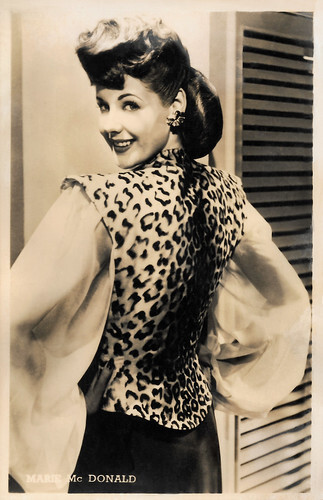
Dutch postcard by J.S.A. Photo: N.V. Columbia F.B.O. Marie McDonald in It's a Pleasure (William A. Seiter 1945).
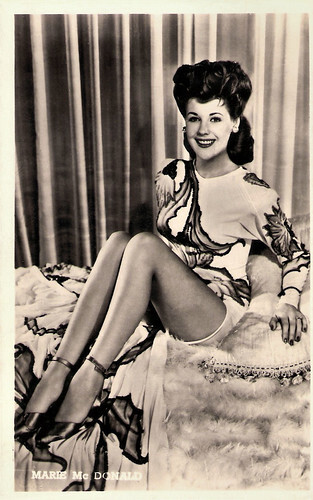
Dutch postcard by J.S.A. Photo: Columbia.
A mostly overlooked gem
During World War II, Marie McDonald became one of Hollywood's most popular pin-up girls and she posed for the United States military magazine, Yank. While she initially did not mind being called 'The Body', McDonald soon grew tired of the nickname and expressed a desire to be known for her acting and singing skills.
McDonald returned to Paramount where she appeared in supporting roles. In 1944, McDonald co-starred in the Film Noir Guest in the House (John Brahm, 1944), in which she received the first positive reviews in her career. Her next starring role came when she worked for independent producer Edward Small as the title character in the screwball comedy Getting Gertie's Garter (Allan Dwan, 1945). Tom De Felice at IMDb : "A mostly overlooked gem. If you are into comedy, it is a must-see."
In 1947, McDonald signed with Metro-Goldwyn-Mayer and co-starred with Gene Kelly in the musical Living in a Big Way (Gregory LaCava, 1947). McDonald and Kelly did not get along while shooting and the film was a financial failure. McDonald bought out the rest of her contract at M-G-M and went to Colombia Pictures where she appeared in a supporting role in the romantic comedy Tell It to the Judge (Norman Foster, 1949).
In 1950, McDonald appeared in the Film Noir Once a Thief (W. Lee Wilder, 1950) and Hit Parade of 1951 (John H. Auer, 1951) which would be her final films for the next eight years. For the remainder of the 1950s, McDonald focused on theatre and music. McDonald recorded an LP for RCA Victor in 1957, 'The Body Sings', backed by Hal Borne and His Orchestra, which consisted of twelve standard ballads. She also toured the world in a very successful nightclub act.
She returned to the screen in 1958 when she was cast as actress Lola Livingston opposite Jerry Lewis in the slapstick comedy The Geisha Boy (Frank Tashlin, 1958). In 1963, she made her last film appearance in the sex comedy Promises! Promises! (King Donovan, 1963). She replaced sexpot Mamie Van Doren but had numerous fights on the set with the other bombshell star Jayne Mansfield . She married the film's producer, Donald F. Taylor, who would be her last husband.
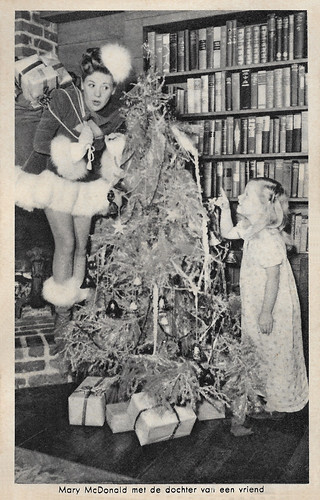
Dutch postcard. Caption: Marie McDonald with a friend's daughter.
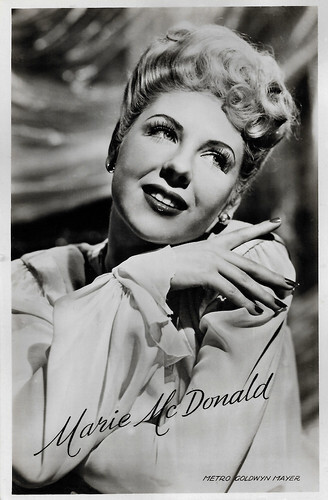
Dutch postcard by Fotoarchief Film en Toneel, no. AX 172. Photo: Metro-Goldwyn-Mayer.
Husbands are easier to find than good agents
When her film career dried up, Marie McDonald did some rather desperate publicity stunts. Hal Erickson at AllMovie : "At one point, she ripped a page from the repertoire of evangelist Aimee Semple McPherson, claiming that she'd been kidnapped and bundled off to the desert. Even when her unorthodox behaviour didn't make the headlines, McDonald could count upon her seven marriages to keep her name in print."
McDonald's first marriage was to sportswriter Richard Allord in 1940. The marriage was annulled after three weeks. In January 1943, McDonald married her agent, Victor Orsatti, in Reno, Nevada. They divorced in May 1947. While awaiting her divorce from Orsatti, McDonald had an affair with mobster Bugsy Siegel. Siegel reportedly dumped McDonald because of her chronic tardiness.
McDonald's third and fourth marriages were to millionaire shoe manufacturer Harry Karl. They initially married in September 1947. After McDonald suffered several miscarriages, the couple adopted two children, Denice and Harrison. They separated in August 1954 and were divorced that November. McDonald and Karl remarried in Arizona in June 1955. They separated in March 1956 and, in May, Karl filed for divorce claiming that McDonald had beaten him causing him "grievous mental suffering". At the time of their separation, McDonald was pregnant with the couple's first biological child. Karl dropped the divorce suit in June. In July, McDonald filed for divorce from Karl and was granted an interlocutory divorce decree later that month but their divorce was never finalized. Their daughter, Tina Marie, was born in September 1956. During their separation, McDonald dated Michael Wilding . McDonald and Karl reconciled again in 1957 but separated again in December 1957. They divorced for good in 1958.
In 1959, McDonald married television executive Louis Bass in Las Vegas. She filed for divorce after ten months of charging Bass with "mental cruelty". In 1961, she married banker and attorney Edward Callahan in Las Vegas. On September 17, 1962, Callahan filed suit in Los Angeles asking for a divorce from McDonald for mental cruelty or that the marriage be annulled due to fraud. Callahan claimed that the two had only lived together for two days because McDonald had no intention of making a home with him or having his children. Callahan also charged that McDonald would not convert to Roman Catholicism. McDonald counter sued dismissing Callahan's claim, stating that they had lived together until September 7. She also claimed that Callahan had committed adultery and borrowed $2600 from her to finance their wedding and honeymoon which he did not repay.
McDonald married Donald Taylor for the sixth time in 1963. They met while McDonald appeared in Promises, Promises, the final film Taylor produced. They remained married until McDonald's death. IMDb quotes McDonald: "Husbands are easier to find than good agents." In 1965, Taylor found McDonald's body slumped over her dressing table in their Hidden Hills, California home. The coroner announced that McDonald's death was caused by "active drug intoxication due to multiple drugs" and was determined to be an accident or a suicide. In December 1965, the suicide team classified her death as 'accidental' after determining that McDonald likely did not choose to commit suicide. She was 42. Three months after McDonald's death, her widower, Donald F. Taylor, died of an intentional overdose of Seconal. Harry Karl and his wife, Debbie Reynolds , raised McDonald's three surviving children.
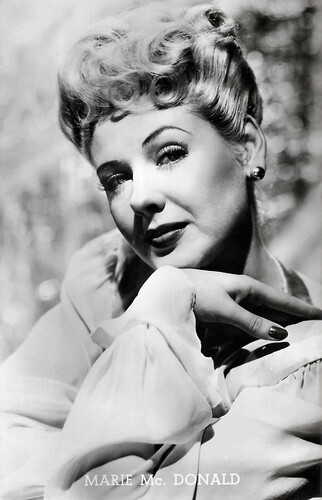
Belgian postcard, no. 751. Photo: M.G.M.
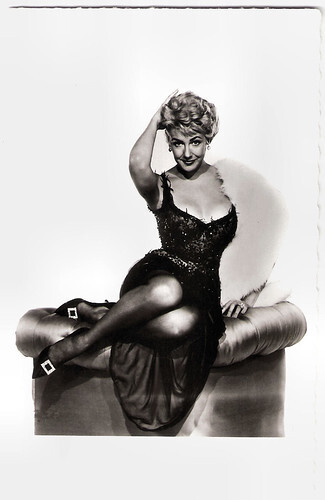
French postcard by Editions P.I., Paris, offered by Les Carbones Korès 'Carboplane', no. 1000. Photo: Paramount. Publicity still for The Geisha Boy (Frank Tashlin, 1958).
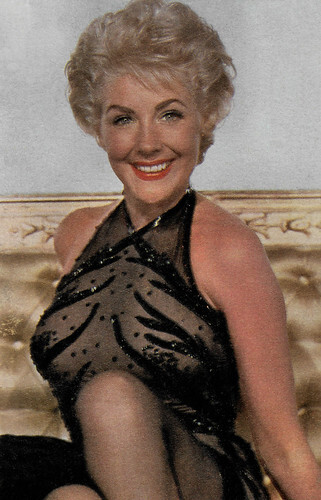
Vintage postcard.
Source: Hal Erickson (AllMovie - page now defunct), Wikipedia and .

Vintage postcard.

Spanish postcard.

British Real Photograph postcard, no. 225.
The Queen of Coney Island
Marie McDonald was born Cora Marie Frye in Burgin, Kentucky, in 1923. She was the daughter of Everett 'Ed' Frye and Marie Taboni née McDonald who performed in the Ziegfeld Follies. After her parents divorced, she eventually moved with her mother and stepfather to Yonkers, New York. At the age of 15, Marie began competing in numerous beauty pageants and was named 'The Queen of Coney Island'. She dropped out of school and began modelling.
In 1939, McDonald was named 'Miss New York State', but subsequently lost at the 'Miss America' pageant. She debuted in 'George White's Scandals of 1939'. The following year, at age 17, she landed a showgirl role in the Broadway production at the Earl Carroll Theatre called 'Earl Carroll's Vanities'.
Shortly thereafter, she moved to Hollywood hoping to develop a film career. She continued modelling and to work for the owner of the Broadway theatre as a showgirl at his Sunset Boulevard nightclub. She was the model used by illustrator Alex Raymond for the Dale Arden and Princess Aura creations for the Flash Gordon comic strip.
After auditioning for Tommy Dorsey in 1940, she joined Dorsey & His Orchestra on his radio show and she later performed with other big bands. Dorsey suggested that she change her last name from 'Frye' to her mother's maiden name 'McDonald' which she used professionally for the rest of her life. In 1942, she was put under contract by Universal for $75 a week and immediately appeared in several minor roles.
Her part in the Abbott and Costello comedy Pardon My Sarong (Earle C. Kenton, 1942) earned her the nickname 'The Body' for her curvaceous physique. She was eventually dropped by Universal and signed with Paramount Pictures, earning $100 a week. While at Paramount, McDonald appeared in Lucky Jordan (Frank Tuttle, 1942) starring Alan Ladd . The following year, she was loaned to Republic Pictures where she co-starred in A Scream in the Dark (George Sherman, 1943), a B detective mystery that met with reasonable success.

Dutch postcard by J.S.A. Photo: N.V. Columbia F.B.O. Marie McDonald in It's a Pleasure (William A. Seiter 1945).

Dutch postcard by J.S.A. Photo: Columbia.
A mostly overlooked gem
During World War II, Marie McDonald became one of Hollywood's most popular pin-up girls and she posed for the United States military magazine, Yank. While she initially did not mind being called 'The Body', McDonald soon grew tired of the nickname and expressed a desire to be known for her acting and singing skills.
McDonald returned to Paramount where she appeared in supporting roles. In 1944, McDonald co-starred in the Film Noir Guest in the House (John Brahm, 1944), in which she received the first positive reviews in her career. Her next starring role came when she worked for independent producer Edward Small as the title character in the screwball comedy Getting Gertie's Garter (Allan Dwan, 1945). Tom De Felice at IMDb : "A mostly overlooked gem. If you are into comedy, it is a must-see."
In 1947, McDonald signed with Metro-Goldwyn-Mayer and co-starred with Gene Kelly in the musical Living in a Big Way (Gregory LaCava, 1947). McDonald and Kelly did not get along while shooting and the film was a financial failure. McDonald bought out the rest of her contract at M-G-M and went to Colombia Pictures where she appeared in a supporting role in the romantic comedy Tell It to the Judge (Norman Foster, 1949).
In 1950, McDonald appeared in the Film Noir Once a Thief (W. Lee Wilder, 1950) and Hit Parade of 1951 (John H. Auer, 1951) which would be her final films for the next eight years. For the remainder of the 1950s, McDonald focused on theatre and music. McDonald recorded an LP for RCA Victor in 1957, 'The Body Sings', backed by Hal Borne and His Orchestra, which consisted of twelve standard ballads. She also toured the world in a very successful nightclub act.
She returned to the screen in 1958 when she was cast as actress Lola Livingston opposite Jerry Lewis in the slapstick comedy The Geisha Boy (Frank Tashlin, 1958). In 1963, she made her last film appearance in the sex comedy Promises! Promises! (King Donovan, 1963). She replaced sexpot Mamie Van Doren but had numerous fights on the set with the other bombshell star Jayne Mansfield . She married the film's producer, Donald F. Taylor, who would be her last husband.

Dutch postcard. Caption: Marie McDonald with a friend's daughter.

Dutch postcard by Fotoarchief Film en Toneel, no. AX 172. Photo: Metro-Goldwyn-Mayer.
Husbands are easier to find than good agents
When her film career dried up, Marie McDonald did some rather desperate publicity stunts. Hal Erickson at AllMovie : "At one point, she ripped a page from the repertoire of evangelist Aimee Semple McPherson, claiming that she'd been kidnapped and bundled off to the desert. Even when her unorthodox behaviour didn't make the headlines, McDonald could count upon her seven marriages to keep her name in print."
McDonald's first marriage was to sportswriter Richard Allord in 1940. The marriage was annulled after three weeks. In January 1943, McDonald married her agent, Victor Orsatti, in Reno, Nevada. They divorced in May 1947. While awaiting her divorce from Orsatti, McDonald had an affair with mobster Bugsy Siegel. Siegel reportedly dumped McDonald because of her chronic tardiness.
McDonald's third and fourth marriages were to millionaire shoe manufacturer Harry Karl. They initially married in September 1947. After McDonald suffered several miscarriages, the couple adopted two children, Denice and Harrison. They separated in August 1954 and were divorced that November. McDonald and Karl remarried in Arizona in June 1955. They separated in March 1956 and, in May, Karl filed for divorce claiming that McDonald had beaten him causing him "grievous mental suffering". At the time of their separation, McDonald was pregnant with the couple's first biological child. Karl dropped the divorce suit in June. In July, McDonald filed for divorce from Karl and was granted an interlocutory divorce decree later that month but their divorce was never finalized. Their daughter, Tina Marie, was born in September 1956. During their separation, McDonald dated Michael Wilding . McDonald and Karl reconciled again in 1957 but separated again in December 1957. They divorced for good in 1958.
In 1959, McDonald married television executive Louis Bass in Las Vegas. She filed for divorce after ten months of charging Bass with "mental cruelty". In 1961, she married banker and attorney Edward Callahan in Las Vegas. On September 17, 1962, Callahan filed suit in Los Angeles asking for a divorce from McDonald for mental cruelty or that the marriage be annulled due to fraud. Callahan claimed that the two had only lived together for two days because McDonald had no intention of making a home with him or having his children. Callahan also charged that McDonald would not convert to Roman Catholicism. McDonald counter sued dismissing Callahan's claim, stating that they had lived together until September 7. She also claimed that Callahan had committed adultery and borrowed $2600 from her to finance their wedding and honeymoon which he did not repay.
McDonald married Donald Taylor for the sixth time in 1963. They met while McDonald appeared in Promises, Promises, the final film Taylor produced. They remained married until McDonald's death. IMDb quotes McDonald: "Husbands are easier to find than good agents." In 1965, Taylor found McDonald's body slumped over her dressing table in their Hidden Hills, California home. The coroner announced that McDonald's death was caused by "active drug intoxication due to multiple drugs" and was determined to be an accident or a suicide. In December 1965, the suicide team classified her death as 'accidental' after determining that McDonald likely did not choose to commit suicide. She was 42. Three months after McDonald's death, her widower, Donald F. Taylor, died of an intentional overdose of Seconal. Harry Karl and his wife, Debbie Reynolds , raised McDonald's three surviving children.

Belgian postcard, no. 751. Photo: M.G.M.

French postcard by Editions P.I., Paris, offered by Les Carbones Korès 'Carboplane', no. 1000. Photo: Paramount. Publicity still for The Geisha Boy (Frank Tashlin, 1958).

Vintage postcard.
Source: Hal Erickson (AllMovie - page now defunct), Wikipedia and .
Published on January 04, 2025 22:00
January 3, 2025
La via del peccato (1925)
Despite the title and an all-star cast, the Italian silent drama La via del peccato/The Way of Sin (Amleto Palermi, 1925) is quite an incoherent and tame film. The postcards promise wild scenes in the underworld with femme fatales and Apache dance, but none of it can be seen in the film. Whatever happened between filming and the premiere?
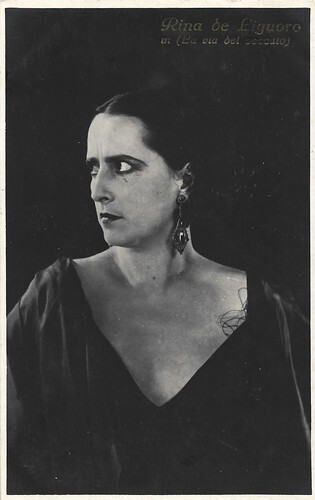
Italian postcard by Edizione G.B. Falci, Milano, no. 340. Photo: La Fotominio / A.P. Film. Rina de Liguoro in La via del peccato/The Way of Sin (Amleto Palermi, 1925).
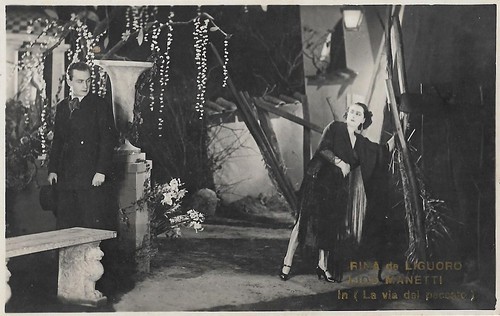
Italian postcard by G.B. Falci Editore, Milano, no. 355. Photo: La Fotominio / A.P. Film. Rina De Liguoro and Lido Manetti in La via del peccato/The Way of Sin (Amleto Palermi, 1925).
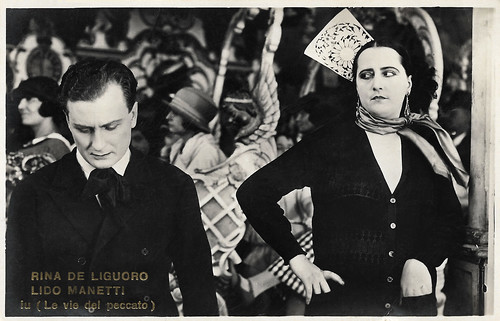
Italian postcard by G.B. Falci Editore, Milano, no. 361. Photo: La Fotominio / A.P. Film. Rina de Liguoro and Lido Manetti in La via del peccato/The Way of Sin (Amleto Palermi, 1925).
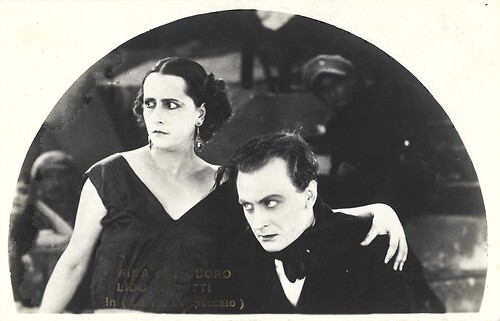
Italian postcard by G.B. Falci Editore, Milano, no. 362. Photo: La Fotominio / A.P. Film. Rina de Liguoro and Lido Manetti in La via del peccato/The Way of Sin (Amleto Palermi, 1925).
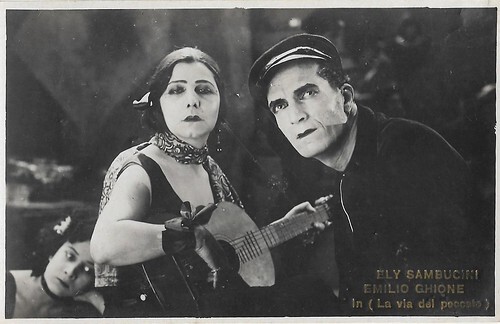
Italian postcard by G.B. Falci Editore, Milano, no. 364. Photo: La Fotominio / A.P. Film. Emilio Ghione and Kally Sambucini in La via del peccato/The Way of Sin (Amleto Palermi, 1925). Sambucini's first name is misspelt on the card.
A terrible nightmare
For La via del peccato/The Way of Sin (1925), A.P. film had contracted an all-star cast. There are even two divas in the film, Soava Gallone and Rina De Liguoro. But also stars like Ruggero Ruggeri , Gustavo Serena , Mario Bonnard , Cecyl Tryan , Luigi Serventi , Lido Manetti (later known in the US as Arnold Kent ), Mary-Cléo Tarlarini and Lamberto Picasso, appear in the film.
Ruggero Ruggeri stars as Marco Selva, who presumedly died in prison. After six years, he suddenly returns home and finds his fiancee Giovanna ( Soava Gallone ) married to his best friend ( Gustavo Serena ). He concocts a ruse to separate her from her husband and children and he nearly manages to do so. She is almost in doubt whether to give in, following her ex-lover to America.
While Marco is booking a cabin, Giovanna falls asleep and has a terrible nightmare. Her house is destroyed, and her husband and she have died. Their children first well cared for, grow up and become reckless, caught by adventures and morbid passions. They gradually descend into vice, even crime, leading to the woman (probably Diomira Jacobini ) being assassinated by her companions and the man (probably Lido Manetti ) being killed by the guillotine. Awakened, Giovanna decides to flee from her old flame and returns home, while. Marco leaves for faraway places to construct a life of his own.
On our postcards, there are no pictures of Ruggero Ruggeri or Diomira Jacobini . The film's publicity stills rather focused on Rina De Liguoro as a femme fatale. They also show Emilio Ghione and Kally Sambucini , who were famous for their underworld characters Za-la-Mort and Za-la-vie. Most postcards seem to deal with Giovanna's dream.
Reportedly, the filmmakers had spiced up the nightmare with lurid scenes of the underworld and even nudity. The result was immediately annulled by the Italian censor. All sinful scenes were cut. It made the film that finally was presented in the cinemas quite incoherent and tame and it was not a success. Perhaps someday a restoration of the film including the censored scenes, may raise a new appreciation for this film. Anyway, Soava Gallone and Emilio Ghione were much more successful in their subsequent film, La cavalcata ardente/The Fiery Cavalcade (Carmine Gallone, 1925), a historical melodrama about the conquest of Naples by Garibaldi.
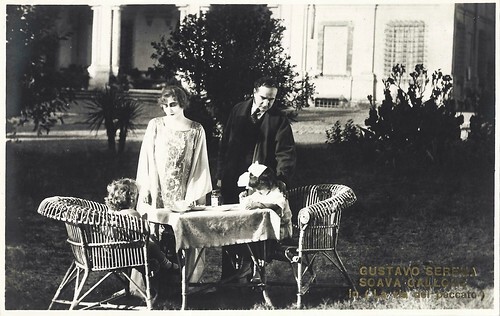
Italian postcard by Ed. G.B. Falci, Milano, no. 365. Photo: La Fotominio / A.P. Film. Soava Gallone and Gustavo Serena in La via del peccato/The Way of Sin (Amleto Palermi, 1925).
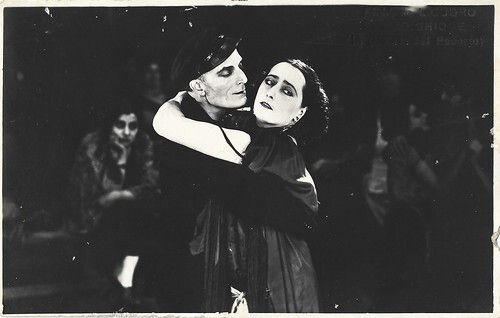
Italian postcard by Ed. G.B. Falci, Milano, no. 369. Photo: La Fotominio / A.P. Film. Rina de Liguoro and Emilio Ghione performing a 'danse apache' in La via del peccato/The Way of Sin (Amleto Palermi, 1925).
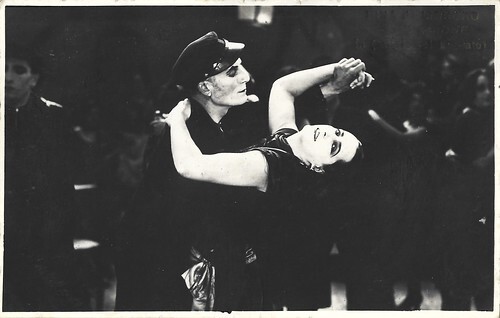
Italian postcard by Ed. G.B. Falci, Milano, no. 370. Photo: La Fotominio / A.P. Film. Rina de Liguoro and Emilio Ghione performing a 'danse apache' in La via del peccato/The Way of Sin (Amleto Palermi, 1925).
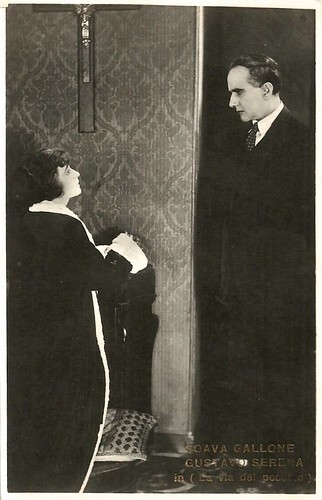
Italian postcard by Ed. G.B. Falci, Milano, no. 387. Photo: La Fotominio / A.P. Film. Soava Gallone and Gustavo Serena in La via del peccato/The Way of Sin (Amleto Palermi, 1925).
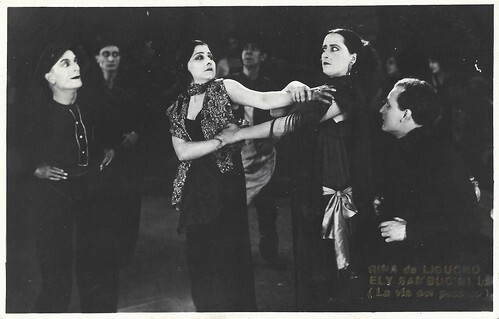
Italian postcard by Ed. G.B. Falci, Milano, no. 398. Photo: La Fotominio / A.P. Film. Emilio Ghione , Kally Sambucini , Rina De Liguoro and Lido Manetti in La via del peccato/The Way of Sin (Amleto Palermi, 1925).
Sources: Vittorio Martinelli (Il cinema muto italiano, 1923-1931) and IMDb.

Italian postcard by Edizione G.B. Falci, Milano, no. 340. Photo: La Fotominio / A.P. Film. Rina de Liguoro in La via del peccato/The Way of Sin (Amleto Palermi, 1925).

Italian postcard by G.B. Falci Editore, Milano, no. 355. Photo: La Fotominio / A.P. Film. Rina De Liguoro and Lido Manetti in La via del peccato/The Way of Sin (Amleto Palermi, 1925).

Italian postcard by G.B. Falci Editore, Milano, no. 361. Photo: La Fotominio / A.P. Film. Rina de Liguoro and Lido Manetti in La via del peccato/The Way of Sin (Amleto Palermi, 1925).

Italian postcard by G.B. Falci Editore, Milano, no. 362. Photo: La Fotominio / A.P. Film. Rina de Liguoro and Lido Manetti in La via del peccato/The Way of Sin (Amleto Palermi, 1925).

Italian postcard by G.B. Falci Editore, Milano, no. 364. Photo: La Fotominio / A.P. Film. Emilio Ghione and Kally Sambucini in La via del peccato/The Way of Sin (Amleto Palermi, 1925). Sambucini's first name is misspelt on the card.
A terrible nightmare
For La via del peccato/The Way of Sin (1925), A.P. film had contracted an all-star cast. There are even two divas in the film, Soava Gallone and Rina De Liguoro. But also stars like Ruggero Ruggeri , Gustavo Serena , Mario Bonnard , Cecyl Tryan , Luigi Serventi , Lido Manetti (later known in the US as Arnold Kent ), Mary-Cléo Tarlarini and Lamberto Picasso, appear in the film.
Ruggero Ruggeri stars as Marco Selva, who presumedly died in prison. After six years, he suddenly returns home and finds his fiancee Giovanna ( Soava Gallone ) married to his best friend ( Gustavo Serena ). He concocts a ruse to separate her from her husband and children and he nearly manages to do so. She is almost in doubt whether to give in, following her ex-lover to America.
While Marco is booking a cabin, Giovanna falls asleep and has a terrible nightmare. Her house is destroyed, and her husband and she have died. Their children first well cared for, grow up and become reckless, caught by adventures and morbid passions. They gradually descend into vice, even crime, leading to the woman (probably Diomira Jacobini ) being assassinated by her companions and the man (probably Lido Manetti ) being killed by the guillotine. Awakened, Giovanna decides to flee from her old flame and returns home, while. Marco leaves for faraway places to construct a life of his own.
On our postcards, there are no pictures of Ruggero Ruggeri or Diomira Jacobini . The film's publicity stills rather focused on Rina De Liguoro as a femme fatale. They also show Emilio Ghione and Kally Sambucini , who were famous for their underworld characters Za-la-Mort and Za-la-vie. Most postcards seem to deal with Giovanna's dream.
Reportedly, the filmmakers had spiced up the nightmare with lurid scenes of the underworld and even nudity. The result was immediately annulled by the Italian censor. All sinful scenes were cut. It made the film that finally was presented in the cinemas quite incoherent and tame and it was not a success. Perhaps someday a restoration of the film including the censored scenes, may raise a new appreciation for this film. Anyway, Soava Gallone and Emilio Ghione were much more successful in their subsequent film, La cavalcata ardente/The Fiery Cavalcade (Carmine Gallone, 1925), a historical melodrama about the conquest of Naples by Garibaldi.

Italian postcard by Ed. G.B. Falci, Milano, no. 365. Photo: La Fotominio / A.P. Film. Soava Gallone and Gustavo Serena in La via del peccato/The Way of Sin (Amleto Palermi, 1925).

Italian postcard by Ed. G.B. Falci, Milano, no. 369. Photo: La Fotominio / A.P. Film. Rina de Liguoro and Emilio Ghione performing a 'danse apache' in La via del peccato/The Way of Sin (Amleto Palermi, 1925).

Italian postcard by Ed. G.B. Falci, Milano, no. 370. Photo: La Fotominio / A.P. Film. Rina de Liguoro and Emilio Ghione performing a 'danse apache' in La via del peccato/The Way of Sin (Amleto Palermi, 1925).

Italian postcard by Ed. G.B. Falci, Milano, no. 387. Photo: La Fotominio / A.P. Film. Soava Gallone and Gustavo Serena in La via del peccato/The Way of Sin (Amleto Palermi, 1925).

Italian postcard by Ed. G.B. Falci, Milano, no. 398. Photo: La Fotominio / A.P. Film. Emilio Ghione , Kally Sambucini , Rina De Liguoro and Lido Manetti in La via del peccato/The Way of Sin (Amleto Palermi, 1925).
Sources: Vittorio Martinelli (Il cinema muto italiano, 1923-1931) and IMDb.
Published on January 03, 2025 22:00
January 2, 2025
Silly Symphonies
Silly Symphonies (also known as Silly Symphony) is an American animated series of 75 musical shorts produced by Walt Disney Productions from 1929 to 1939. As the series name implies, the Silly Symphonies were originally intended as whimsical accompaniments to pieces of music. The films usually did not feature continuing characters, but there are exceptions such as Three Little Pigs, The Tortoise and the Hare, and Three Orphan Kittens, which all had sequels. The series is noted for its innovation with Technicolor and the multiplane motion picture camera, as well as its introduction of Donald Duck, who made his first appearance in the Silly Symphony cartoon The Wise Little Hen in 1934. Seven Silly Symphonies won the Oscar for Best Animated Short Film.
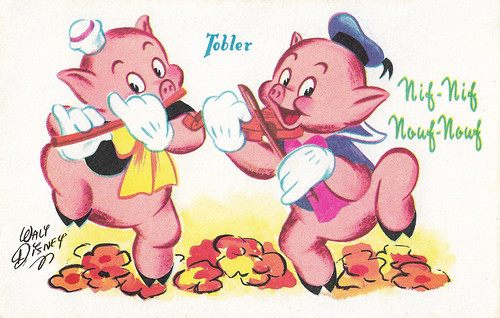
French postcard by Imp. Georges Lang, Paris, offered by Chocolats Tobler. Image: Walt Disney.
Fifer Pig and Fiddler Pig are two of the three little pigs of the classic Silly Symphonies short Three Little Pigs (Burt Gillett, 1933). The Three Little Pigs (1933) was phenomenally successful with audiences of the day, so much so that theatres ran the cartoon for months after its debut, to a great financial response. Several theatres added hand-drawn "beards" to the movie posters for the cartoon as a way of indicating how long its theatrical run lasted. The cartoon is still considered to be the most successful animated short ever made and remained on top of animation until Disney was able to boost Mickey's popularity further by making him a top merchandise icon by the end of 1934. The Three Little Pigs won the Oscar for Best Animated Short Film in 1934. In 1994, it was voted #11 of the 50 Greatest Cartoons of all time by members of the animation field. In 2007, The Three Little Pigs was selected for preservation in the United States National Film Registry by the Library of Congress as being "culturally, historically, or aesthetically significant".
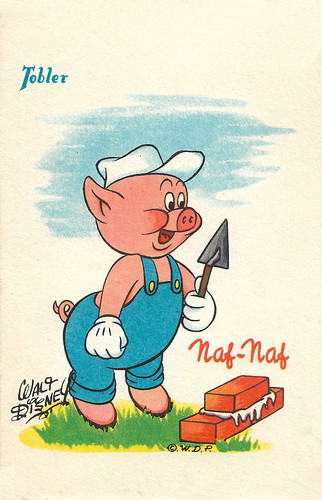
French postcard by Imp. Georges Lang, Paris, offered by Chocolats Tobler. Image: Walt Disney.
Practical Pig is one of the three little pigs of the classic Silly Symphonies short Three Little Pigs (Burt Gillett, 1933) and its three follow-up shorts, The Big Bad Wolf (Burt Gillett, 1934), Three Little Wolves (Burt Gillett, David Hand, 1936), and The Practical Pig (Dick Rickard, 1939). The three pigs are constantly targeted by the Big Bad Wolf, who wants to eat them for dinner.
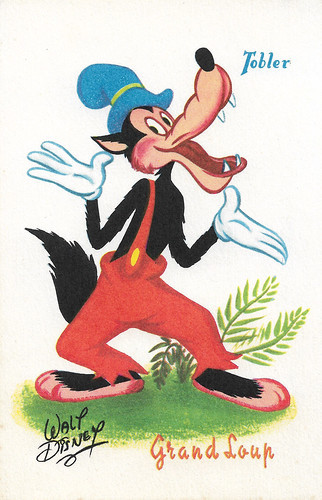
French postcard by Imp. Georges Lang, Paris, offered by Chocolats Tobler. Image: Walt Disney.
The Big Bad Wolf is the main antagonist of the Silly Symphonies short Three Little Pigs (Burt Gillett, 1933) and its sequels. As his name suggests, he is a ruthless, conniving wolf who constantly plots to capture and eat the Three Little Pigs.
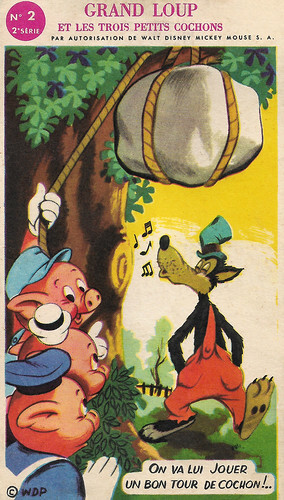
French collector card, series 2, no. 2. Image: Walt Disney - Mickey Mouse. Scene from The Three Little Pigs (1933). Caption: 'We're going to play a dirty trick on him...!'
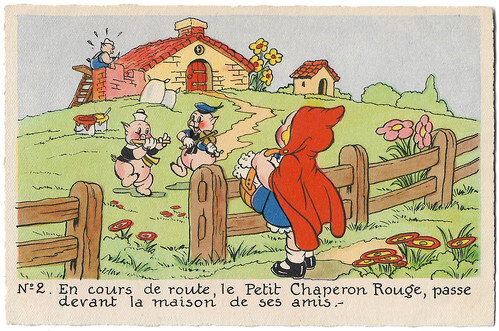
French postcard by Éditions F. Sépériadès, Paris, no. 2. Image: Walt Disney - Mickey Mouse. Scene from The Big Bad Wolf (1934). Caption: Along the way, Little Red Riding Hood passes by her friends' farmhouse.
The Big Bad Wolf (Burt Gillett, 1934) is an animated short produced by Walt Disney as part of the Silly Symphony series. Acting partly as a sequel to the wildly successful adaptation of the folk tale The Three Little Pigs (1933) and maintaining the previous film's title characters as well as its villain, this film also acts as an adaptation of the fairy tale 'Little Red Riding Hood' (1697) by Charles Perrault, with the Big Bad Wolf from Three Little Pigs acting as the adversary to Little Red Riding Hood and her grandmother.
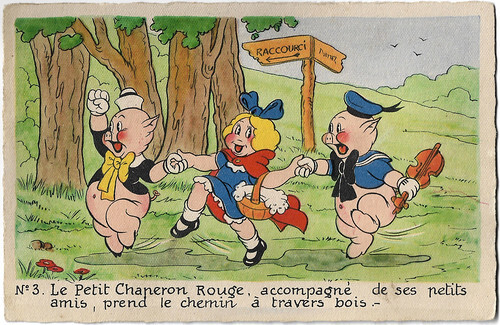
French postcard by Éditions F. Sépériadès, Paris, no. 3. Image: Walt Disney - Mickey Mouse. Scene from The Big Bad Wolf (1934). Caption: Little Red Riding Hood and her little friends set off through the woods. 'Raccourci" translates as Shortcut.
Musical animated shorts that combined the latest sound technology with storytelling
While Walt Disney and Carl Stalling, a theatre organist from Kansas City, were in New York to add sound to the Mickey Mouse shorts The Gallopin' Gaucho, The Barn Dance and Plane Crazy, Stalling suggested the idea of making a series of musical animated shorts that combined the latest sound technology with storytelling. At first, Walt did not seem interested, but when they returned to New York in February to record the sound for a fifth Mickey Mouse cartoon, The Opry House, they also recorded the soundtrack for The Skeleton Dance, the type of short that Stalling had suggested and the first Silly Symphony cartoon.
Within the animation industry, the series is known for its use by Walt Disney as a platform for experimenting with processes, techniques, characters, and stories to further the art of animation. It also provided a venue to try out techniques and technologies, such as Technicolor, special effects animation, and dramatic storytelling in animation, that would be crucial to Disney's plans to eventually begin making feature-length animated films.
Shortly after the switch to United Artists, the series became even more popular. Walt Disney had seen some of Dr. Herbert Kalmus' tests for a new three-strip, full-colour Technicolor process, which would replace the previous two-tone Technicolor process. Disney signed a contract with Technicolor which gave the Disney studio exclusive rights to the new three-strip process through the end of 1935 and had a 60% complete Symphony, Flowers and Trees, scrapped and redone in full colour. Flowers and Trees was the first animated film to use the three-strip Technicolor process and was a phenomenal success. Within a year, the now-in-Technicolor Silly Symphonies series had popularity and success that matched (and later surpassed) that of the Mickey Mouse cartoons.
The contract Disney had with Technicolor would also later be extended another five years as well. The success of Silly Symphonies would be tremendously boosted after Three Little Pigs was released in 1933 and became a box office sensation; the film was featured in movie theatres for several months and also featured the hit song that became the anthem of the Great Depression, 'Who's Afraid of the Big Bad Wolf'. Several Silly Symphonies entries, including Three Little Pigs (1933), The Grasshopper and the Ants (1934), The Tortoise and the Hare (1935), The Country Cousin (1936), The Old Mill (1937), Wynken, Blynken, and Nod (1938), and The Ugly Duckling (1939, with an earlier black-and-white version from 1931), are among the most notable films produced by Walt Disney .
Due to problems related to Disney's scheduled productions of cartoons, a deal was made with Harman and Ising to produce three Silly Symphonies: Merbabies, Pipe Dreams, and The Little Bantamweight. Only one of these cartoons, Merbabies, ended up being bought by Disney, the remaining two Harman-Ising Silly Symphonies were then sold to MGM who released them as Happy Harmonies cartoons. Disney ceased production of Silly Symphonies in 1939.
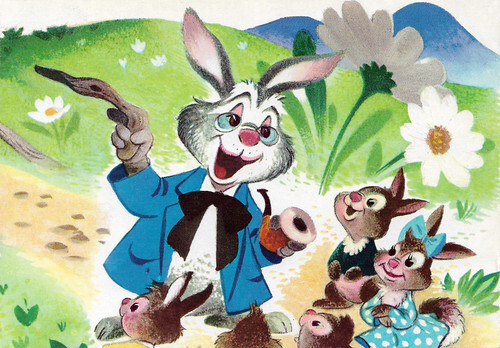
Italian postcard by Grafiche Biondetti, Verona, no. 123. Image: Walt Disney Productions.
'Grandpa Bunny' (1951) is a classic Little Golden Book. It was inspired by the Technicolor Silly Symphony short, Funny Little Bunnies (1934).
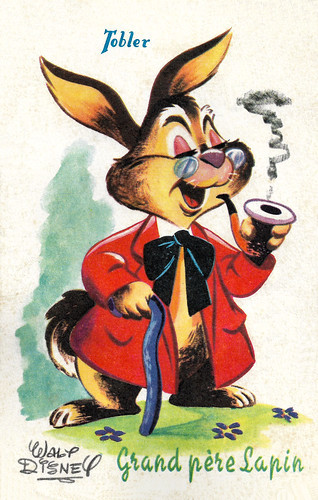
French postcard by Imp. Georges Lang, Paris, offered by Chocolats Tobler. Image: Walt Disney.
Grandpa Bunny was introduced in the Silly Symphony Funny Little Bunnies (Wilfred Jackson, 1934). In the seven-minute short, bunny rabbits are preparing for Easter by making chocolate eggs, rabbits decorating eggs, and weaving and filling baskets. In 1951, Grandpa returned in the Little Golden Book 'Grandpa Bunny'. It tells the touching story of (now) Great-Grandpa Bunny Bunny, who teaches each new generation of bunnies how to prepare for the coming spring. The story was told by Jane Werner with illustrations by the Walt Disney Studio adapted by Dick Kelsey and Bill Justice from Funny Little Bunnies (1934). Cole Sear at IMDb about the short: "Funny Little Bunnies is whimsical Disney animation at its best and it is unapologetically funny. (...) The story is simple and humorous without being too dumb and the animation- which I suspect was done on 3-strip technicolour is beautiful."
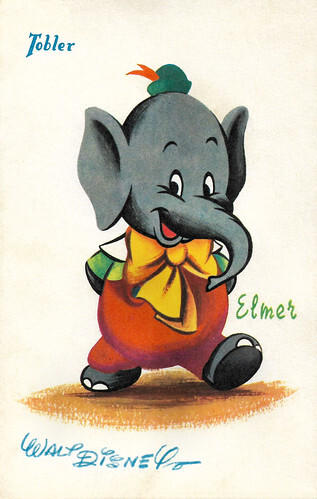
French postcard by Tobler. Image: The Walt Disney Company.
Elmer is the main character of the Silly Symphonies short Elmer Elephant (1936), produced by The Walt Disney Company, and directed by Wilfred Jackson.
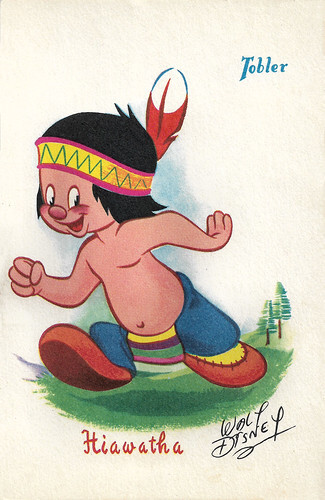
French postcard by Imp. Georges Lang, Paris, offered by Chocolats Tobler. Image: Walt Disney.
Little Hiawatha (or simply Hiawatha is a little Indian hunter who hunts for the game. He is the hero of the Silly Symphony Little Hiawatha (David Hand, 1937). In the short film, Hiawatha is first seen rowing in his canoe across the canoes across the falls of Minneha'ha. Encountering a bluebird and a robin, he prepares to fire his arrow but the animals tell them not to hurt them. Upon passing through a whirlpool, Hiawatha arrives at a stop and falls on the water where the raccoons, rabbits, squirrels, and other woodland creatures laugh at him. Approaching the animals, Hiawatha tries to fire his arrow at them but they end up running away. Hiawatha sees strange animal tracks to which he sees a grasshopper he is about to hunt. Hiawatha attempts to take him down but the grasshopper fools him and later chases a small rabbit which surrounds him as he attempts to take him down but instead shoos him away. The rabbit is reunited with his family due to his big heart, as he spares the innocent rabbit. Upon sparing the rabbit, Hiawatha breaks his arrow as the animals cheer for him that he will not harm any other animal he encounters. He accidentally encounters a bear cub alongside an adult bear which suddenly chases him across the woods while three beavers notice that Hiawatha is in danger sounding the alarm to the woodland creatures. As Hiawatha is being chased, the raccoons, beavers, opossums, and other animals manage to save him from the bear. He then returns to his canoe as the animals bid farewell to him.
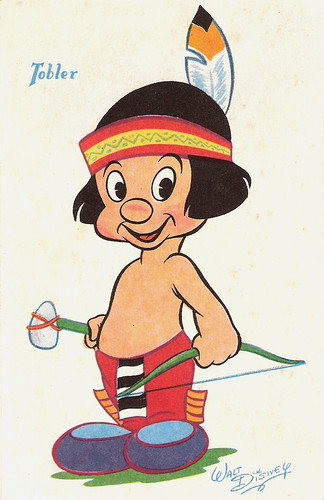
French postcard by Imp. Georges Lang, Paris, offered by Chocolats Tobler. Image: Walt Disney.
Little Hiawatha (or simply Hiawatha is a little Indian hunter who hunts for the game. He is the hero of the Silly Symphony Little Hiawatha (David Hand, 1937).
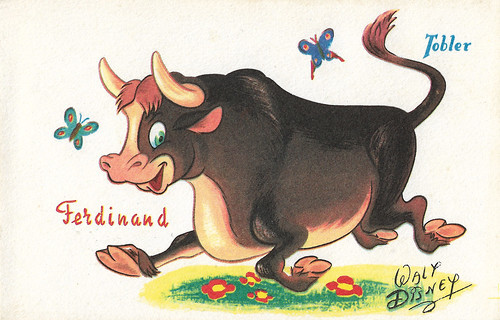
French postcard by Imp. Georges Lang, Paris, offered by Chocolats Tobler. Image: Walt Disney.
Ferdinand is the quiet, gentle bull who, instead of being fierce in the bullring, only wants to smell the flowers in Disney's animated short Ferdinand the Bull (Dick Rickard, 1938). When he is stung by a bee, the townspeople believe he is ferocious and they take him to the bullfight. Ferdinand was voiced by animator Milt Kahl.
Source: Wikipedia.

French postcard by Imp. Georges Lang, Paris, offered by Chocolats Tobler. Image: Walt Disney.
Fifer Pig and Fiddler Pig are two of the three little pigs of the classic Silly Symphonies short Three Little Pigs (Burt Gillett, 1933). The Three Little Pigs (1933) was phenomenally successful with audiences of the day, so much so that theatres ran the cartoon for months after its debut, to a great financial response. Several theatres added hand-drawn "beards" to the movie posters for the cartoon as a way of indicating how long its theatrical run lasted. The cartoon is still considered to be the most successful animated short ever made and remained on top of animation until Disney was able to boost Mickey's popularity further by making him a top merchandise icon by the end of 1934. The Three Little Pigs won the Oscar for Best Animated Short Film in 1934. In 1994, it was voted #11 of the 50 Greatest Cartoons of all time by members of the animation field. In 2007, The Three Little Pigs was selected for preservation in the United States National Film Registry by the Library of Congress as being "culturally, historically, or aesthetically significant".

French postcard by Imp. Georges Lang, Paris, offered by Chocolats Tobler. Image: Walt Disney.
Practical Pig is one of the three little pigs of the classic Silly Symphonies short Three Little Pigs (Burt Gillett, 1933) and its three follow-up shorts, The Big Bad Wolf (Burt Gillett, 1934), Three Little Wolves (Burt Gillett, David Hand, 1936), and The Practical Pig (Dick Rickard, 1939). The three pigs are constantly targeted by the Big Bad Wolf, who wants to eat them for dinner.

French postcard by Imp. Georges Lang, Paris, offered by Chocolats Tobler. Image: Walt Disney.
The Big Bad Wolf is the main antagonist of the Silly Symphonies short Three Little Pigs (Burt Gillett, 1933) and its sequels. As his name suggests, he is a ruthless, conniving wolf who constantly plots to capture and eat the Three Little Pigs.

French collector card, series 2, no. 2. Image: Walt Disney - Mickey Mouse. Scene from The Three Little Pigs (1933). Caption: 'We're going to play a dirty trick on him...!'

French postcard by Éditions F. Sépériadès, Paris, no. 2. Image: Walt Disney - Mickey Mouse. Scene from The Big Bad Wolf (1934). Caption: Along the way, Little Red Riding Hood passes by her friends' farmhouse.
The Big Bad Wolf (Burt Gillett, 1934) is an animated short produced by Walt Disney as part of the Silly Symphony series. Acting partly as a sequel to the wildly successful adaptation of the folk tale The Three Little Pigs (1933) and maintaining the previous film's title characters as well as its villain, this film also acts as an adaptation of the fairy tale 'Little Red Riding Hood' (1697) by Charles Perrault, with the Big Bad Wolf from Three Little Pigs acting as the adversary to Little Red Riding Hood and her grandmother.

French postcard by Éditions F. Sépériadès, Paris, no. 3. Image: Walt Disney - Mickey Mouse. Scene from The Big Bad Wolf (1934). Caption: Little Red Riding Hood and her little friends set off through the woods. 'Raccourci" translates as Shortcut.
Musical animated shorts that combined the latest sound technology with storytelling
While Walt Disney and Carl Stalling, a theatre organist from Kansas City, were in New York to add sound to the Mickey Mouse shorts The Gallopin' Gaucho, The Barn Dance and Plane Crazy, Stalling suggested the idea of making a series of musical animated shorts that combined the latest sound technology with storytelling. At first, Walt did not seem interested, but when they returned to New York in February to record the sound for a fifth Mickey Mouse cartoon, The Opry House, they also recorded the soundtrack for The Skeleton Dance, the type of short that Stalling had suggested and the first Silly Symphony cartoon.
Within the animation industry, the series is known for its use by Walt Disney as a platform for experimenting with processes, techniques, characters, and stories to further the art of animation. It also provided a venue to try out techniques and technologies, such as Technicolor, special effects animation, and dramatic storytelling in animation, that would be crucial to Disney's plans to eventually begin making feature-length animated films.
Shortly after the switch to United Artists, the series became even more popular. Walt Disney had seen some of Dr. Herbert Kalmus' tests for a new three-strip, full-colour Technicolor process, which would replace the previous two-tone Technicolor process. Disney signed a contract with Technicolor which gave the Disney studio exclusive rights to the new three-strip process through the end of 1935 and had a 60% complete Symphony, Flowers and Trees, scrapped and redone in full colour. Flowers and Trees was the first animated film to use the three-strip Technicolor process and was a phenomenal success. Within a year, the now-in-Technicolor Silly Symphonies series had popularity and success that matched (and later surpassed) that of the Mickey Mouse cartoons.
The contract Disney had with Technicolor would also later be extended another five years as well. The success of Silly Symphonies would be tremendously boosted after Three Little Pigs was released in 1933 and became a box office sensation; the film was featured in movie theatres for several months and also featured the hit song that became the anthem of the Great Depression, 'Who's Afraid of the Big Bad Wolf'. Several Silly Symphonies entries, including Three Little Pigs (1933), The Grasshopper and the Ants (1934), The Tortoise and the Hare (1935), The Country Cousin (1936), The Old Mill (1937), Wynken, Blynken, and Nod (1938), and The Ugly Duckling (1939, with an earlier black-and-white version from 1931), are among the most notable films produced by Walt Disney .
Due to problems related to Disney's scheduled productions of cartoons, a deal was made with Harman and Ising to produce three Silly Symphonies: Merbabies, Pipe Dreams, and The Little Bantamweight. Only one of these cartoons, Merbabies, ended up being bought by Disney, the remaining two Harman-Ising Silly Symphonies were then sold to MGM who released them as Happy Harmonies cartoons. Disney ceased production of Silly Symphonies in 1939.

Italian postcard by Grafiche Biondetti, Verona, no. 123. Image: Walt Disney Productions.
'Grandpa Bunny' (1951) is a classic Little Golden Book. It was inspired by the Technicolor Silly Symphony short, Funny Little Bunnies (1934).

French postcard by Imp. Georges Lang, Paris, offered by Chocolats Tobler. Image: Walt Disney.
Grandpa Bunny was introduced in the Silly Symphony Funny Little Bunnies (Wilfred Jackson, 1934). In the seven-minute short, bunny rabbits are preparing for Easter by making chocolate eggs, rabbits decorating eggs, and weaving and filling baskets. In 1951, Grandpa returned in the Little Golden Book 'Grandpa Bunny'. It tells the touching story of (now) Great-Grandpa Bunny Bunny, who teaches each new generation of bunnies how to prepare for the coming spring. The story was told by Jane Werner with illustrations by the Walt Disney Studio adapted by Dick Kelsey and Bill Justice from Funny Little Bunnies (1934). Cole Sear at IMDb about the short: "Funny Little Bunnies is whimsical Disney animation at its best and it is unapologetically funny. (...) The story is simple and humorous without being too dumb and the animation- which I suspect was done on 3-strip technicolour is beautiful."

French postcard by Tobler. Image: The Walt Disney Company.
Elmer is the main character of the Silly Symphonies short Elmer Elephant (1936), produced by The Walt Disney Company, and directed by Wilfred Jackson.

French postcard by Imp. Georges Lang, Paris, offered by Chocolats Tobler. Image: Walt Disney.
Little Hiawatha (or simply Hiawatha is a little Indian hunter who hunts for the game. He is the hero of the Silly Symphony Little Hiawatha (David Hand, 1937). In the short film, Hiawatha is first seen rowing in his canoe across the canoes across the falls of Minneha'ha. Encountering a bluebird and a robin, he prepares to fire his arrow but the animals tell them not to hurt them. Upon passing through a whirlpool, Hiawatha arrives at a stop and falls on the water where the raccoons, rabbits, squirrels, and other woodland creatures laugh at him. Approaching the animals, Hiawatha tries to fire his arrow at them but they end up running away. Hiawatha sees strange animal tracks to which he sees a grasshopper he is about to hunt. Hiawatha attempts to take him down but the grasshopper fools him and later chases a small rabbit which surrounds him as he attempts to take him down but instead shoos him away. The rabbit is reunited with his family due to his big heart, as he spares the innocent rabbit. Upon sparing the rabbit, Hiawatha breaks his arrow as the animals cheer for him that he will not harm any other animal he encounters. He accidentally encounters a bear cub alongside an adult bear which suddenly chases him across the woods while three beavers notice that Hiawatha is in danger sounding the alarm to the woodland creatures. As Hiawatha is being chased, the raccoons, beavers, opossums, and other animals manage to save him from the bear. He then returns to his canoe as the animals bid farewell to him.

French postcard by Imp. Georges Lang, Paris, offered by Chocolats Tobler. Image: Walt Disney.
Little Hiawatha (or simply Hiawatha is a little Indian hunter who hunts for the game. He is the hero of the Silly Symphony Little Hiawatha (David Hand, 1937).

French postcard by Imp. Georges Lang, Paris, offered by Chocolats Tobler. Image: Walt Disney.
Ferdinand is the quiet, gentle bull who, instead of being fierce in the bullring, only wants to smell the flowers in Disney's animated short Ferdinand the Bull (Dick Rickard, 1938). When he is stung by a bee, the townspeople believe he is ferocious and they take him to the bullfight. Ferdinand was voiced by animator Milt Kahl.
Source: Wikipedia.
Published on January 02, 2025 22:00
January 1, 2025
Ross Verlag, Part 16: Hänsom
Ross Verlag produced several series of interesting cigarette cards with film stars for the German tobacco industry. In the early 1930s, Ross published a few series for Hänsom cigarettes, manufactured by Jasmatzi Cigarettenfabrik G.M.b.H in Dresden. The small black and white cards give a view of the German film world in the final Weimar years. We chose 30 cigarette cards from different series with film directors, scenes from classic early sound films and portraits of fascinating actors. Many of them had to move from Germany when the Nazis took power in 1933.
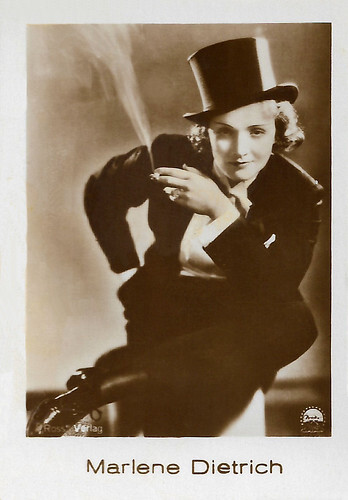
Small German card by Ross Verlag for Hänsom Cigaretten by Jasmatzi Cigaretten-Fabrik G.m.b.H., Dresden, Tonfilmseries 3, no. 358. Photo: Eugene Robert Richee / Paramount. Marlene Dietrich in Morocco (Josef von Sternberg, 1930).
Marlene Dietrich (1901-1992) was the first German actress who became successful in Hollywood. Throughout her long career, she constantly reinvented herself. In 1920s Berlin, she started as a cabaret singer, chorus girl, and film actress. In the 1930s, she became a Hollywood star, then a World War II frontline entertainer, and finally, she was an international stage show performer from the 1950s till the 1970s. Now we remember her as one of the icons of the 20th century.
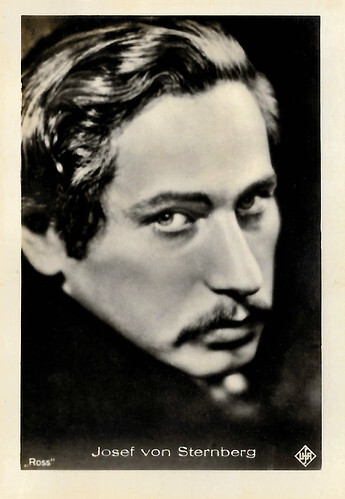
German cigarette card by Ross Verlag for Hänsom cigarettes by Jasmatzi Cigarettenfabrik G.M.b.H, Dresden, Film Series 4 'Aus tönenden Filmen' (From sound films), no. 505. Photo: Ufa.
Austrian-American film director Josef von Sternberg (1894-1969) is known as a great stylist, as the director of the prototypical Hollywood gangster film, Underworld (1927), and especially as the discoverer of Marlene Dietrich. He worked with her for the first time at the Ufa in Der blaue Engel/The Blue Angel (1930) and would subsequently make six more films with her in Hollywood. He was nominated for the Academy Award for Best Director for Morocco (1930) and Shanghai Express (1932). Along with Erich von Stroheim, Friedrich Wilhelm Murnau, Fritz Lang, Ernst Lubitsch and Billy Wilder, Von Sternberg belonged to the large group of German and Austrian film emigrants who helped to shape Hollywood cinema.
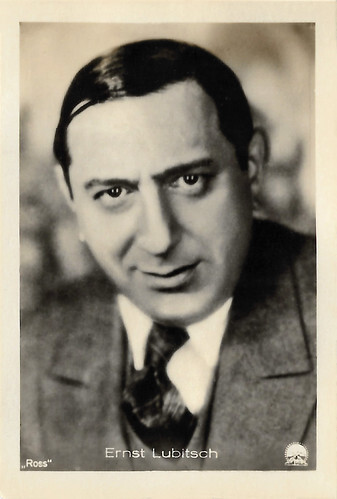
German cigarette card by Ross Verlag for Hänsom cigarettes by Jasmatzi Cigarettenfabrik G.M.b.H, Dresden, Film Series 4 'Aus tönenden Filmen' (From sound films), no. 506. Photo: Paramount.
Ernst Lubitsch (1892-1947) was a German-American actor, screenwriter, producer and film director. His urbane comedies of manners gave him the reputation of being Hollywood's most elegant and sophisticated director; as his prestige grew, his films were promoted as having ‘the Lubitsch touch.’ He was nominated three times for the Oscar for Best Director and in 1947, he received an Honorary Academy Award.
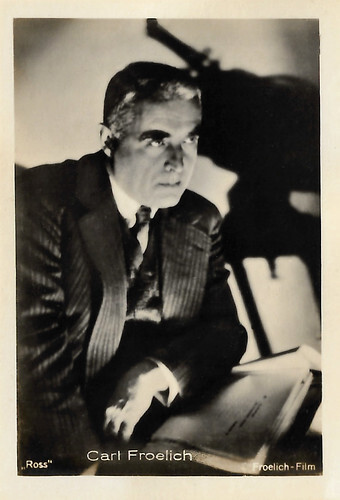
German cigarette card by Ross Verlag for Hänsom cigarettes by Jasmatzi Cigarettenfabrik G.M.b.H, Dresden, Film Series 4 'Aus tönenden Filmen' (From sound films), no. 508. Photo: Froelich-Film.
Carl Froelich (1875-1953) was a German film pioneer and film director, who made many silent films with Henny Porten and produced such classics as Die Brüder Karamasoff/The Brothers Karamazov (1922), the first German sound film, Die Nacht gehört uns/The Night Belongs To Us (1929) and the groundbreaking Mädchen in Uniform/Girls in Uniform (1931). In 1933, Froelich became a member of the National Socialist Party and later became President of the Reichsfilmkammer. After the end of the war, Froelich was arrested and in 1948 he was de-Nazified. Between 1912 and 1951 he made 77 films.
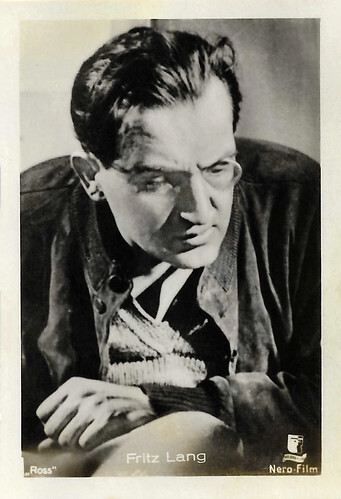
German cigarette card by Ross Verlag for Hänsom cigarettes by Jasmatzi Cigarettenfabrik G.M.b.H, Dresden, Film Series 4 'Aus tönenden Filmen' (From sound films), no. 509. Photo: Nero-Film.
Fritz Lang (1890-1976) was an Austrian-German-American filmmaker, screenwriter, and occasional film producer and actor. One of the best-known émigrés from Germany's school of Expressionism, he was dubbed the 'Master of Darkness' by the British Film Institute. Lang's most famous films include the groundbreaking futuristic Metropolis (1927) and the influential M (1931), a Film Noir precursor that he made before he moved to the United States. His other notable films include Dr. Mabuse, der Spieler/Dr. Mabuse the Gambler (1922), Die Nibelungen (1924), Fury (1936), You Only Live Once (1937), Hangmen Also Die! (1943), The Woman in the Window (1944), and The Big Heat (1953).
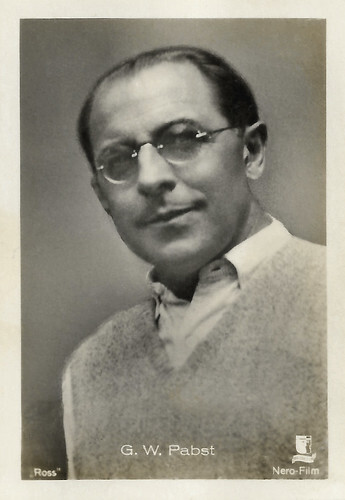
German cigarette card by Ross Verlag for Hänsom cigarettes by Jasmatzi Cigarettenfabrik G.M.b.H, Dresden, Film Series 4 'Aus tönenden Filmen' (From sound films), no. 510. Photo: Nero Film.
Austrian film director Georg Wilhelm Pabst (1885-1967) was together with Fritz Lang, Friedrich Wilhelm Murnau and Ernst Lubitsch one of the great film directors of the Weimar Republic of Germany. He worked in Germany, France, Italy and the US. Some of his best-known films deal with the situation of women in the Weimar Republic. His best-known films include Die freudlose Gasse (1925), Die Büchse der Pandora (1929), Die Dreigroschenoper (1931) and Kameradschaft (1931). During World War II, he made the films Komödianten (1941) and Paracelsus (1943) in Nazi Germany.
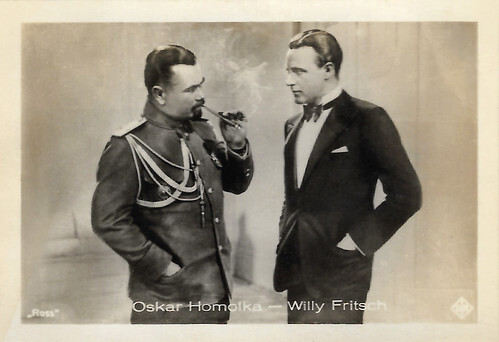
German cigarette card by Ross Verlag for Hänsom cigarettes by Jasmatzi Cigarettenfabrik G.M.b.H, Dresden, Film Series 4 'Aus tönenden Filmen' (From sound films), no. 519. Photo: Ufa. Oskar Homolka and Willy Fritsch in Im Geheimdienst/In the Employ of the Secret Service (Gustav Ucicky, 1931).
Austrian film and theatre actor Oskar Homolka (1898–1978) had a stocky appearance, bushy eyebrows and a rather Slavic-sounding name, which led many to believe he was Eastern European or Russian. His expressive face predestined him to play character roles as a scoundrel, pimp or communist spy. From the mid-1920s on, charming Willy Fritsch (1901-1973) replaced Bruno Kastner and Harry Liedtke as the darling of female cinemagoers in Germany. Fritsch became the immensely popular ‘Sunny Boy’ of the Ufa operettas of the 1930s and 1940s, and with his frequent co-star Lilian Harvey he formed the 'dream team of the German cinema'.
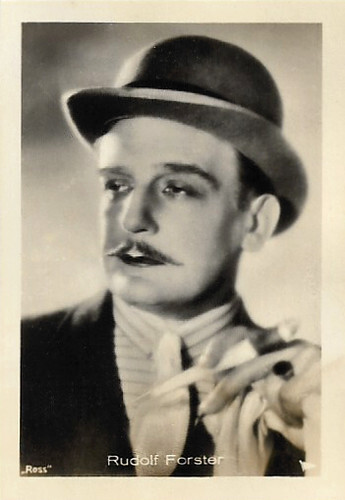
German cigarette card by Ross Verlag for Hänsom cigarettes by Jasmatzi Cigarettenfabrik G.M.b.H, Dresden, Film Series 4 'Aus tönenden Filmen' (From sound films), no. 533. Photo: National. Rudolf Forster in Die Dreigroschenoper/The Threepenny Opera (G.W. Pabst, 1931).
Austrian film actor Rudolf Forster (1884-1968) appeared in more than 100 films between 1914 and 1968. He was known for Zur Chronik von Grieshuus/Chronicles of the Gray House (1925), Die 3 Groschen-Oper/The Threepenny Opera (1931) and Das Glas Wasser/A Glass of Water (1960).
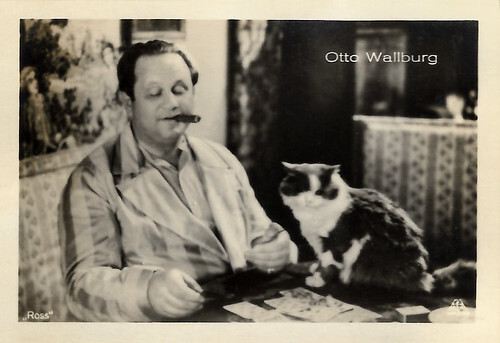
German cigarette card by Ross Verlag for Hänsom cigarettes by Jasmatzi Cigarettenfabrik G.M.b.H, Dresden, Film Series 4 'Aus tönenden Filmen' (From sound films), no. 536. Photo: Aafa-Film. Otto Wallburg in Lügen auf Rügen/The Isle of Lies (Victor Janson, 1932).
Otto Wallburg (1889-1944) was a popular actor of the Weimar cinema, who appeared in supporting roles as the overweight comedian. After the rise of the Nazis, the Jewish actor had to go into exile, first in Austria and later in the Netherlands. The Nazis murdered him in the Auschwitz concentration camp.
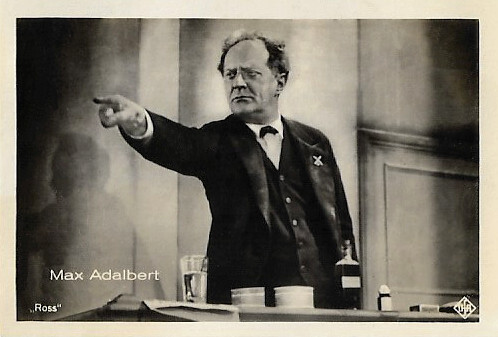
German cigarette card by Ross Verlag for Hänsom cigarettes by Jasmatzi Cigarettenfabrik G.M.b.H, Dresden, Film Series 4 'Aus tönenden Filmen' (From sound films), no. 572. Photo: Ufa. Max Adalbert in Das Ekel/The Scoundrel (Eugen Schüfftan, Franz Wenzler, 1931).
German stage and film actor Max Adalbert (1874-1933) was one of the great names of the German theatre at the beginning of the twentieth century. He was famous for his roles in comedies. His greatest success was the title role in the comedy Der Hauptmann von Köpenick/The Captain from Köpenick (1931) which he played on stage and in the cinema.
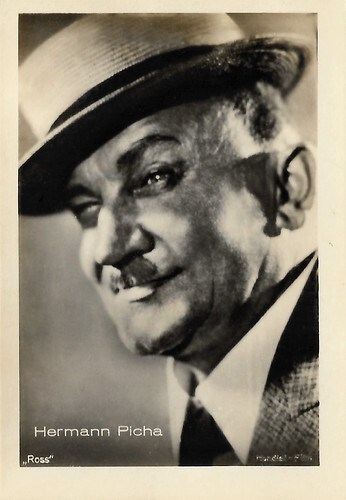
German cigarette card by Ross Verlag for Hänsom cigarettes by Jasmatzi Cigarettenfabrik G.M.b.H, Dresden, Film Series 4 'Aus tönenden Filmen' (From sound films), no. 573. Photo: Mondial Film.
German stage and film actor Hermann Picha (1865-1936) was very prolific in German cinema during the silent and early sound eras, appearing in over 300 short and feature films. Picha played a mixture of lead and supporting roles during his career. He played the title role in Schneider Wibbel/Wibbel the Tailor (Manfred Noa, 1920) and appeared in a supporting role in Fritz Lang's Expressionist fantasy classic Der müde Tod/Destiny (1921), inspired by the Indian folktale of Savitri.
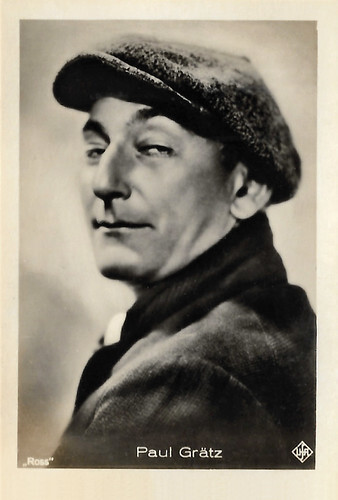
German cigarette card by Ross Verlag for Hänsom cigarettes by Jasmatzi Cigarettenfabrik G.M.b.H, Dresden, Film Series 4 'Aus tönenden Filmen' (From sound films), no. 576. Photo: Ufa. Paul Grätz in Das verlorene Paradies/The Lost Paradise (Philipp Lothar Mayring, 1931).
German stage actor Paul Graetz (1889-1937) often worked with stage director Max Reinhardt. He was a star in Berlin's cabaret. In films, Graetz played mostly comic and grotesque characters. The Jewish Graetz went into exile in 1933 and worked in London and Hollywood.
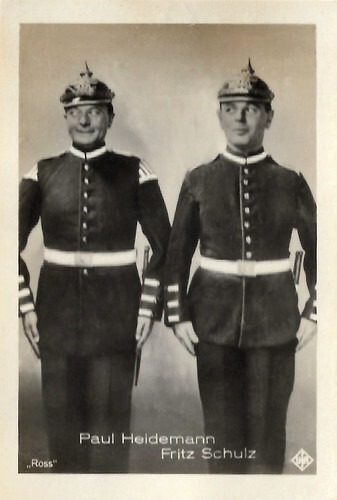
German cigarette card by Ross Verlag for Hänsom cigarettes by Jasmatzi Cigarettenfabrik G.M.b.H, Dresden, Film Series 4 'Aus tönenden Filmen' (From sound films), no. 601. Photo: Ufa. Paul Heidemann and Fritz Schulz in Dienst ist Dienst/Duty is Duty (Carl Boese 1931).
Paul Heidemann (1884-1968) was a German stage and screen actor, film director and film producer. He was famous for his comical parts. Austrian-born comic actor/director Fritz Schulz (1896-1972) appeared in more than one hundred films between 1917 and 1970. When the sound film arrived, he was one of the most popular stars of the Ufa. The rise of the Nazis broke his blooming career.
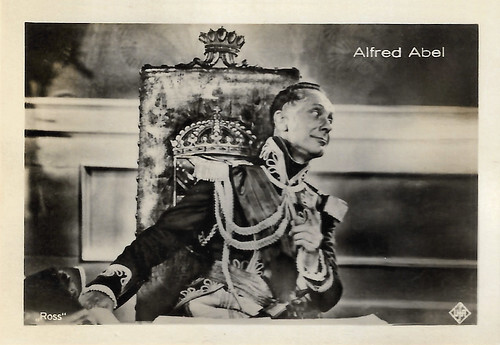
German cigarette card by Ross Verlag for Hänsom cigarettes by Jasmatzi Cigarettenfabrik G.M.b.H, Dresden/Ross Verlag, Film Series 4 'Aus tönenden Filmen' (From sound films), no. 614. Photo: Ufa. Alfred Abel in 1914, die letzten Tage vor dem Weltbrand/1914: The Last Days Before the War (Richard Oswald, 1931).
Alfred Abel (1879-1937) played in over 140 silent and sound films between 1913 and 1938. He is best known as the industrial Fredersen in Fritz Lang's Metropolis (1927).
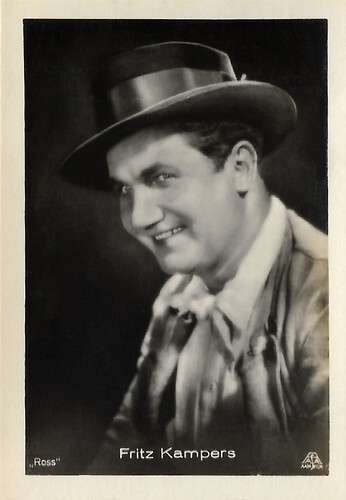
German cigarette card by Ross Verlag for Hänsom cigarettes by Jasmatzi Cigarettenfabrik G.M.b.H, Dresden, Film Series 4 'Aus tönenden Filmen' (From sound films), no. 627. Photo: Aafa-Film.
German actor and director Fritz Kampers (1891-1950) was a solidly built Bavarian character actor. In films from 1913, he was much in demand during the 1920s and 1930s. Kampers was often cast as robust or comic military types, or laconic, but good-hearted rustics in mountaineering or 'Heimat' films. He appeared in more than 260 films.
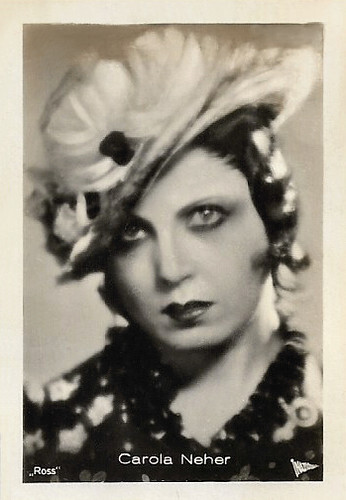
German cigarette card byRoss Verlag for Hänsom cigarettes by Jasmatzi Cigarettenfabrik G.M.b.H, Dresden, Film Series 4 'Aus tönenden Filmen' (From sound films), no. 633. Photo: National. Carola Neher in Die 3 Groschen-Oper/The Threepenny Opera (G.W. Pabst, 1931).
Carola Neher (1900-1942) was a talented and popular German stage actress and singer. She is now best known for her role as Polly Peachum in the film Die 3 Groschen-Oper/The Threepenny Opera (G.W. Pabst, 1931). After fleeing from the Nazis, she was falsely accused and convicted in the USSR of having engaged in anti-Soviet activities. In 1942, she died of typhoid in a prison.
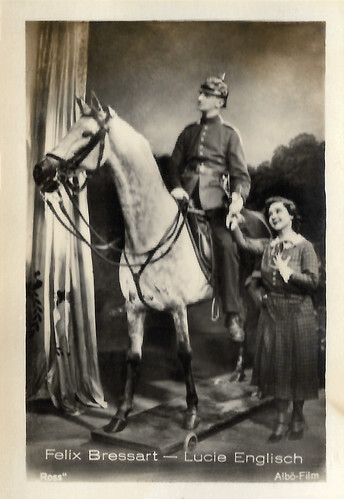
German cigarette card by Ross Verlag for Hänsom cigarettes by Jasmatzi Cigarettenfabrik G.M.b.H, Dresden, Film Series 4 'Aus tönenden Filmen' (From sound films), no. 534. Photo: Albö-Film. Felix Bressart and Lucie Englisch in Der Schrecken der Garnison/Terror of the Garrison (Carl Boese, 1931).
German stage and screen actor Felix Bressart (1892–1949) had to flee Germany after the Nazis seized power. He continued his film career in Austria and later in the US, where he became a popular character actor for MGM.
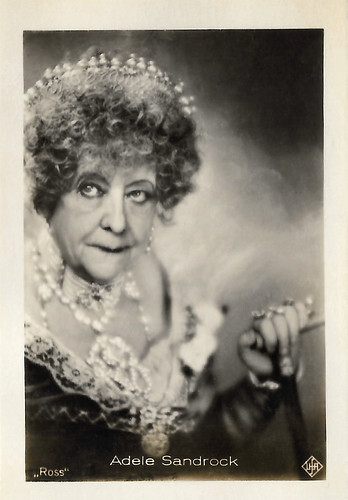
German cigarette card by Ross Verlag for Hänsom cigarettes by Jasmatzi Cigarettenfabrik G.M.b.H, Dresden, Film Series 4 'Aus tönenden Filmen' (From sound films), no. 635. Photo: Ufa. Adele Sandrock in Der Kongreß tanzt/The Congress Dances (Eric Charell, 1931).
Grand German-Dutch actress Adele Sandrock (1863-1937) had a successful theatrical career all over Europe. In Vienna, she had a stormy affair with the famous playwright Arthur Schnitzler and enjoyed triumphs as the diva of the modern playwrights. In the 1910s she became one of the first German film stars. After the introduction of sound, she emerged as a witty comedienne. She excelled as the intimidating elderly dragon, who could also be surprisingly funny and tactful.
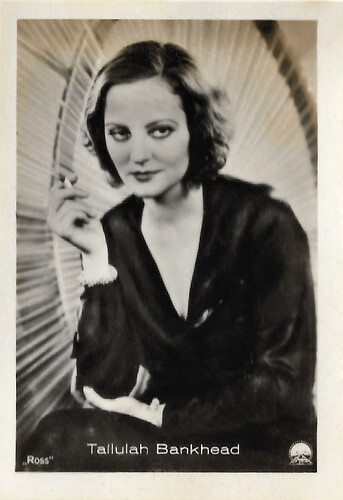
German cigarette card by Ross Verlag for Hänsom cigarettes by Jasmatzi Cigarettenfabrik G.M.b.H, Dresden, Film Series 4 'Aus tönenden Filmen' (From sound films), no. 648. Photo: Paramount.
American actress Tallulah Bankhead (1902-1968) was the most popular star of London's famed West End in the 1920s. After starring in several well-received plays, she gained the attention of Paramount Pictures executives and returned to the United States to try her hand at the film world. Tallulah's personality did not shine on film as Paramount executives had hoped. She appeared in such films as Devil and the Deep (1932) with Gary Cooper, Charles Laughton and newcomer Cary Grant, and Lifeboat (1944). While she made most of her fame on the stages of the world, the film industry and its history became richer because of her talent and her very colourful personality. Today her phrase, "Hello, Dahling" is known throughout the entertainment world.
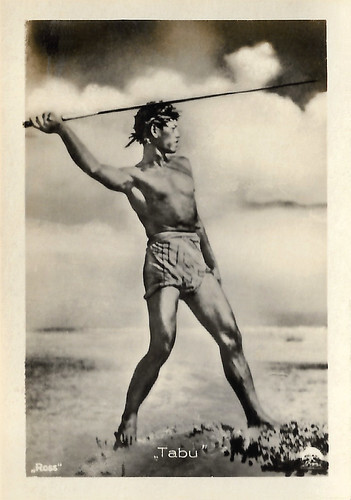
German cigarette card By Ross Verlag for Hänsom cigarettes by Jasmatzi Cigarettenfabrik G.M.b.H, Dresden, Film Series 4 'Aus tönenden Filmen' (From sound films), no. 649. Photo: Paramount. Matahi in Tabu/Tabu: A Story of the South Seas (Friedrich Wilhelm Murnau, 1931).
Friedrich Wilhelm Murnau (1888-1931) was a German film director who became world-famous as a maker of silent, expressionist films. Murnau's most famous films are Nosferatu, eine Symphonie des Grauens (1922), Der letzte Mann (1924), Faust (1926) and Sunrise: A Song of Two Humans (1927). He invented many revolutionary techniques that have since been very often imitated by others. His final film was Tabu/Tabu: A Story of the South Seas (1931).
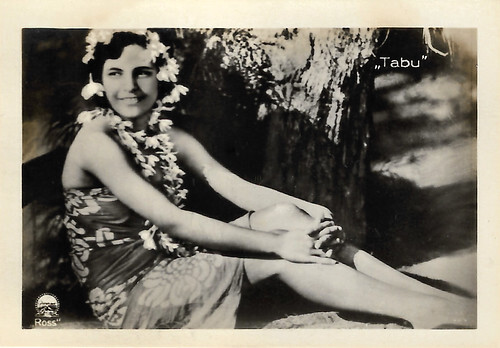
German cigarette card by Ross Verlag for Hänsom cigarettes by Jasmatzi Cigarettenfabrik G.M.b.H, Dresden, Film Series 4 'Aus tönenden Filmen' (From sound films), no. 650. Photo: Paramount. Reri in Tabu/Tabu: A Story of the South Seas (Friedrich Wilhelm Murnau, 1931).
Reri was born Anna Chevalier in 1912 in Bora-Bora, Tahiti. She was discovered by director Friedrich Wilhelm Murnau , who gave her the lead in his final film Tabu: A Story of the South Seas (1931). It is the tale of two young lovers on Bora Bora, the idyllic island in the South Pacific. Later she also appeared in the Polish film Czarna perla/Black Pearl (Michal Waszynski, 1934) and The Hurricane (John Ford, 1937). She died in 1977.
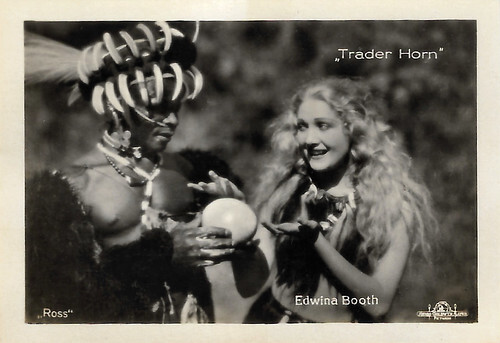
German cigarette card by Ross Verlag for Hänsom cigarettes by Jasmatzi Cigarettenfabrik G.M.b.H, Dresden, Film Series 4 'Aus tönenden Filmen' (From sound films), no. 653. Photo: MGM. Edwina Booth in Trader Horn (W.S. Van Dyke, 1931).
Trader Horn (1931) made Edwina Booth famous. Unfortunately, it also marked the beginning of a nightmare for the young actress, whose health was seriously impaired because of tropical ailments she contracted while filming the movie in Africa. Her once-promising career was over by 1933 and she soon disappeared from view in the second half of the 1930s.
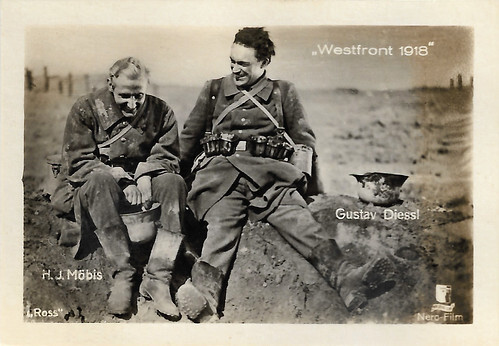
German cigarette card by Ross Verlag for Hänsom cigarettes by Jasmatzi Cigarettenfabrik G.M.b.H, Dresden, Film Series 4 'Aus tönenden Filmen' (From sound films), no. 663. Photo: Nero-Film. H.J. Möbis and Gustav Diessl in Westfront 1918 (G.W. Pabst, 1930).
Austrian film and stage actor Gustav Diessl (1899-1948) was the hero of the first Mountain film, Die weiße Hölle vom Piz Palü/The White Hell of Piz Palu (1929). This film and others by prolific director G.W. Pabst made him at the time an unusual sex symbol: the mature, quiet, somewhat difficult man who attracts women almost against his will. Under the Nazi regime, he was often cast as an exotic villain or a mysterious foreigner.
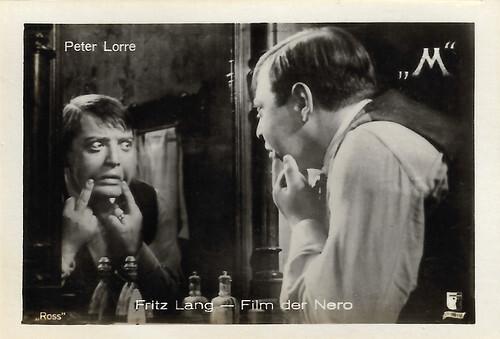
German cigarette card by Ross Verlag for Hänsom cigarettes by Jasmatzi Cigarettenfabrik G.M.b.H, Dresden, Film Series 4 'Aus tönenden Filmen' (From sound films), no. 664. Photo: Nero-Film. Peter Lorre in M – Eine Stadt sucht einen Mörder/M (Fritz Lang, 1931).
Peter Lorre (1904–1964) with his trademark large, popped eyes, his toothy grin and his raspy voice was an American actor of Jewish Austro-Hungarian descent. He was an international sensation as the psychopathic child murderer in Fritz Lang’s M – Eine Stadt sucht einen Mörder/M (1931).
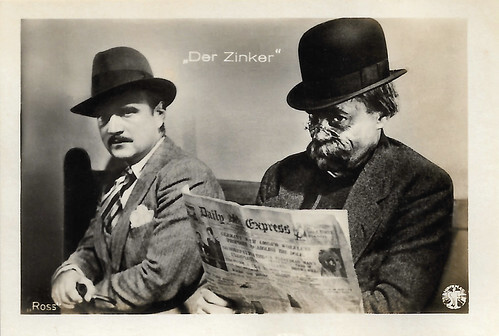
German cigarette card By Ross Verlag for Hänsom cigarettes by Jasmatzi Cigarettenfabrik G.M.b.H, Dresden, Film Series 4 'Aus tönenden Filmen' (From sound films), no. 666. Photo: Süd-Film (SF). Karl Ludwig Diehl in Der Zinker/The Informer (Karl Forest, Martin Fric, Karel Lamac, 1931).
German film actor Karl Ludwig Diehl (1896-1958) appeared in 66 films between 1924 and 1957. Although he is forgotten now, he was one of the most prominent German film actors of the 1930s and 1940s.
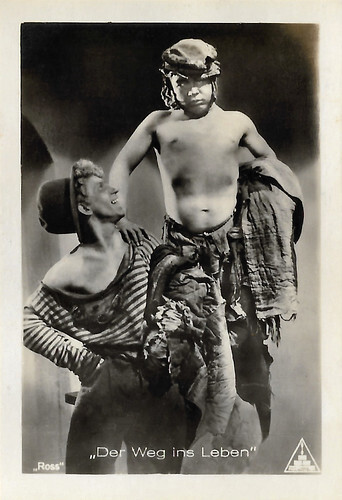
German cigarette card by Ross Verlag for Hänsom cigarettes by Jasmatzi Cigarettenfabrik G.M.b.H, Dresden, Film Series 4 'Aus tönenden Filmen' (From sound films), no. 668. Photo: Prometheus-Film. Scene from Putyovka v zhizn/Road to Life (Nikolai Ekk, 1931).
Putyovka v zhizn/Road to Life (Nikolai Ekk, 1931) was one of the first Soviet sound films—with an imaginative soundtrack far ahead of its time. This landmark film stars Mikhail Zharov, Nikolai Batalov, and Yvan Kyrlya. Stage actor Vasili Kachalov is the narrator. The film was a smash hit both in Russia and in the West, where its impact generated some dozen spin-offs on its theme of 'difficult' children.
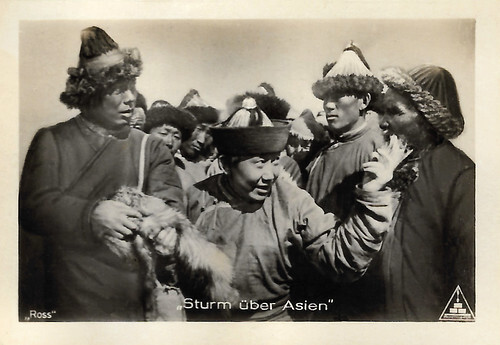
German cigarette card for Hänsom cigarettes by Jasmatzi Cigarettenfabrik G.M.b.H, Dresden/Ross Verlag, Film Series 4 'Aus tönenden Filmen' (From sound films), no. 669. Photo: Prometheus-Film. Scene from Potomok Chingis-Khana/Storm over Asia (Vsevolod Pudovkin, 1928).
Potomok Chingis-Khana/Потомок Чингисхана/Storm over Asia (Vsevolod Pudovkin, 1928) is a Soviet propaganda film written by Osip Brik and Ivan Novokshonov, and starring Valéry Inkijinoff. It is the final film in Pudovkin's 'revolutionary trilogy', alongside Mat/Mother (1926) and Konets Sankt-Peterburga/The End of St. Petersburg (1927).
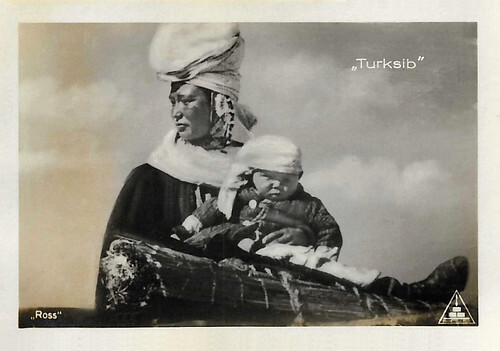
German cigarette card by Ross Verlag for Hänsom cigarettes by Jasmatzi Cigarettenfabrik G.M.b.H, Dresden, Film Series 4 'Aus tönenden Filmen' (From sound films), no. 670. Photo: Photo: Prometheus-Film. A scene from Turksib (Victor A. Turin, 1929).
The Soviet documentary film Turksib (Victor A. Turin, 1929) documents the building of the Turkestan–Siberia Railway, which connected Central Asia and Siberia. The creation of this monumental construction project was an important moment in Soviet history. The rail line stretched northeast from Tashkent to Almaty and on to Novosibirsk.
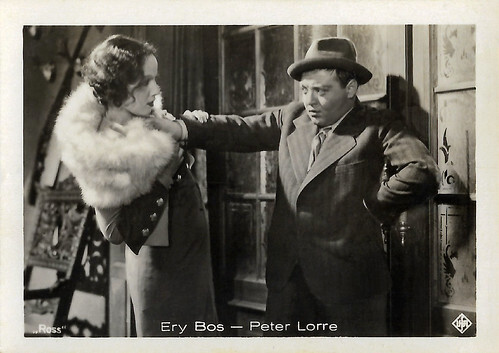
German collectors card by Ross Verlag in the series 'Hänsom Filmbilder for Jasmatzi Cigarettenfabrik G.m.b.H., Dresden, Serie V, Bild no. 84 (1-147). Photo: Ufa. Ery Bos and Peter Lorre in Schuss im Morgengrauen/A Shot at Dawn (Alfred Zeisler, 1932).
Dutch-German actress Ery Bos (1910-2005) had a short but productive film career in the early German sound film. From 1932 to 1934, she took part in a dozen films in only three years. Peter Lorre (1904–1964) with his trademark large, popped eyes, his toothy grin and his raspy voice was an American actor of Jewish Austro-Hungarian descent. He was an international sensation as the psychopathic child murderer in Fritz Lang’s M – Eine Stadt sucht einen Mörder/M (1931). He later became a popular actor in two British Hitchcock films and a series of Hollywood crime films and mysteries. Although he was frequently typecast as a sinister foreigner in the US, he also became the star of the successful Mr. Moto detective series.
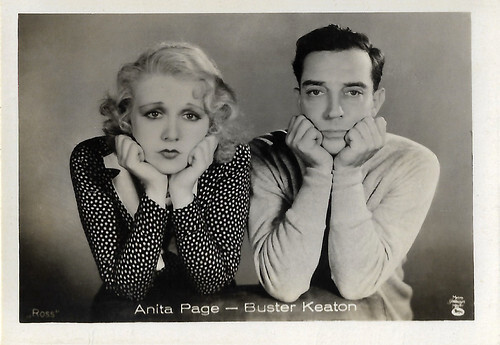
German cigarette card by Ross Verlag in the series 'Hänsom Filmbilder' for Jaszmatzi Cigarettenfabrik G.M.B.H., Dresden, Series V, no. 113 (of 147). Photo: Metro-Goldwyn-Mayer. Anita Page and Buster Keaton in Free and Easy (Edward Sedgwick, 1930).
Beautiful Anita Page (1910–2008) was one of Hollywood's most popular leading ladies during the last years of the silent screen and the first years of the sound era. According to MGM, she received the most fan mail then and her nickname was "the girl with the most beautiful face in Hollywood". Stone-faced Buster Keaton (1895-1966) was one of the three greatest comedians of Silent Hollywood.

Small German card by Ross Verlag for Hänsom Cigaretten by Jasmatzi Cigaretten-Fabrik G.m.b.H., Dresden, Tonfilmseries 3, no. 358. Photo: Eugene Robert Richee / Paramount. Marlene Dietrich in Morocco (Josef von Sternberg, 1930).
Marlene Dietrich (1901-1992) was the first German actress who became successful in Hollywood. Throughout her long career, she constantly reinvented herself. In 1920s Berlin, she started as a cabaret singer, chorus girl, and film actress. In the 1930s, she became a Hollywood star, then a World War II frontline entertainer, and finally, she was an international stage show performer from the 1950s till the 1970s. Now we remember her as one of the icons of the 20th century.

German cigarette card by Ross Verlag for Hänsom cigarettes by Jasmatzi Cigarettenfabrik G.M.b.H, Dresden, Film Series 4 'Aus tönenden Filmen' (From sound films), no. 505. Photo: Ufa.
Austrian-American film director Josef von Sternberg (1894-1969) is known as a great stylist, as the director of the prototypical Hollywood gangster film, Underworld (1927), and especially as the discoverer of Marlene Dietrich. He worked with her for the first time at the Ufa in Der blaue Engel/The Blue Angel (1930) and would subsequently make six more films with her in Hollywood. He was nominated for the Academy Award for Best Director for Morocco (1930) and Shanghai Express (1932). Along with Erich von Stroheim, Friedrich Wilhelm Murnau, Fritz Lang, Ernst Lubitsch and Billy Wilder, Von Sternberg belonged to the large group of German and Austrian film emigrants who helped to shape Hollywood cinema.

German cigarette card by Ross Verlag for Hänsom cigarettes by Jasmatzi Cigarettenfabrik G.M.b.H, Dresden, Film Series 4 'Aus tönenden Filmen' (From sound films), no. 506. Photo: Paramount.
Ernst Lubitsch (1892-1947) was a German-American actor, screenwriter, producer and film director. His urbane comedies of manners gave him the reputation of being Hollywood's most elegant and sophisticated director; as his prestige grew, his films were promoted as having ‘the Lubitsch touch.’ He was nominated three times for the Oscar for Best Director and in 1947, he received an Honorary Academy Award.

German cigarette card by Ross Verlag for Hänsom cigarettes by Jasmatzi Cigarettenfabrik G.M.b.H, Dresden, Film Series 4 'Aus tönenden Filmen' (From sound films), no. 508. Photo: Froelich-Film.
Carl Froelich (1875-1953) was a German film pioneer and film director, who made many silent films with Henny Porten and produced such classics as Die Brüder Karamasoff/The Brothers Karamazov (1922), the first German sound film, Die Nacht gehört uns/The Night Belongs To Us (1929) and the groundbreaking Mädchen in Uniform/Girls in Uniform (1931). In 1933, Froelich became a member of the National Socialist Party and later became President of the Reichsfilmkammer. After the end of the war, Froelich was arrested and in 1948 he was de-Nazified. Between 1912 and 1951 he made 77 films.

German cigarette card by Ross Verlag for Hänsom cigarettes by Jasmatzi Cigarettenfabrik G.M.b.H, Dresden, Film Series 4 'Aus tönenden Filmen' (From sound films), no. 509. Photo: Nero-Film.
Fritz Lang (1890-1976) was an Austrian-German-American filmmaker, screenwriter, and occasional film producer and actor. One of the best-known émigrés from Germany's school of Expressionism, he was dubbed the 'Master of Darkness' by the British Film Institute. Lang's most famous films include the groundbreaking futuristic Metropolis (1927) and the influential M (1931), a Film Noir precursor that he made before he moved to the United States. His other notable films include Dr. Mabuse, der Spieler/Dr. Mabuse the Gambler (1922), Die Nibelungen (1924), Fury (1936), You Only Live Once (1937), Hangmen Also Die! (1943), The Woman in the Window (1944), and The Big Heat (1953).

German cigarette card by Ross Verlag for Hänsom cigarettes by Jasmatzi Cigarettenfabrik G.M.b.H, Dresden, Film Series 4 'Aus tönenden Filmen' (From sound films), no. 510. Photo: Nero Film.
Austrian film director Georg Wilhelm Pabst (1885-1967) was together with Fritz Lang, Friedrich Wilhelm Murnau and Ernst Lubitsch one of the great film directors of the Weimar Republic of Germany. He worked in Germany, France, Italy and the US. Some of his best-known films deal with the situation of women in the Weimar Republic. His best-known films include Die freudlose Gasse (1925), Die Büchse der Pandora (1929), Die Dreigroschenoper (1931) and Kameradschaft (1931). During World War II, he made the films Komödianten (1941) and Paracelsus (1943) in Nazi Germany.

German cigarette card by Ross Verlag for Hänsom cigarettes by Jasmatzi Cigarettenfabrik G.M.b.H, Dresden, Film Series 4 'Aus tönenden Filmen' (From sound films), no. 519. Photo: Ufa. Oskar Homolka and Willy Fritsch in Im Geheimdienst/In the Employ of the Secret Service (Gustav Ucicky, 1931).
Austrian film and theatre actor Oskar Homolka (1898–1978) had a stocky appearance, bushy eyebrows and a rather Slavic-sounding name, which led many to believe he was Eastern European or Russian. His expressive face predestined him to play character roles as a scoundrel, pimp or communist spy. From the mid-1920s on, charming Willy Fritsch (1901-1973) replaced Bruno Kastner and Harry Liedtke as the darling of female cinemagoers in Germany. Fritsch became the immensely popular ‘Sunny Boy’ of the Ufa operettas of the 1930s and 1940s, and with his frequent co-star Lilian Harvey he formed the 'dream team of the German cinema'.

German cigarette card by Ross Verlag for Hänsom cigarettes by Jasmatzi Cigarettenfabrik G.M.b.H, Dresden, Film Series 4 'Aus tönenden Filmen' (From sound films), no. 533. Photo: National. Rudolf Forster in Die Dreigroschenoper/The Threepenny Opera (G.W. Pabst, 1931).
Austrian film actor Rudolf Forster (1884-1968) appeared in more than 100 films between 1914 and 1968. He was known for Zur Chronik von Grieshuus/Chronicles of the Gray House (1925), Die 3 Groschen-Oper/The Threepenny Opera (1931) and Das Glas Wasser/A Glass of Water (1960).

German cigarette card by Ross Verlag for Hänsom cigarettes by Jasmatzi Cigarettenfabrik G.M.b.H, Dresden, Film Series 4 'Aus tönenden Filmen' (From sound films), no. 536. Photo: Aafa-Film. Otto Wallburg in Lügen auf Rügen/The Isle of Lies (Victor Janson, 1932).
Otto Wallburg (1889-1944) was a popular actor of the Weimar cinema, who appeared in supporting roles as the overweight comedian. After the rise of the Nazis, the Jewish actor had to go into exile, first in Austria and later in the Netherlands. The Nazis murdered him in the Auschwitz concentration camp.

German cigarette card by Ross Verlag for Hänsom cigarettes by Jasmatzi Cigarettenfabrik G.M.b.H, Dresden, Film Series 4 'Aus tönenden Filmen' (From sound films), no. 572. Photo: Ufa. Max Adalbert in Das Ekel/The Scoundrel (Eugen Schüfftan, Franz Wenzler, 1931).
German stage and film actor Max Adalbert (1874-1933) was one of the great names of the German theatre at the beginning of the twentieth century. He was famous for his roles in comedies. His greatest success was the title role in the comedy Der Hauptmann von Köpenick/The Captain from Köpenick (1931) which he played on stage and in the cinema.

German cigarette card by Ross Verlag for Hänsom cigarettes by Jasmatzi Cigarettenfabrik G.M.b.H, Dresden, Film Series 4 'Aus tönenden Filmen' (From sound films), no. 573. Photo: Mondial Film.
German stage and film actor Hermann Picha (1865-1936) was very prolific in German cinema during the silent and early sound eras, appearing in over 300 short and feature films. Picha played a mixture of lead and supporting roles during his career. He played the title role in Schneider Wibbel/Wibbel the Tailor (Manfred Noa, 1920) and appeared in a supporting role in Fritz Lang's Expressionist fantasy classic Der müde Tod/Destiny (1921), inspired by the Indian folktale of Savitri.

German cigarette card by Ross Verlag for Hänsom cigarettes by Jasmatzi Cigarettenfabrik G.M.b.H, Dresden, Film Series 4 'Aus tönenden Filmen' (From sound films), no. 576. Photo: Ufa. Paul Grätz in Das verlorene Paradies/The Lost Paradise (Philipp Lothar Mayring, 1931).
German stage actor Paul Graetz (1889-1937) often worked with stage director Max Reinhardt. He was a star in Berlin's cabaret. In films, Graetz played mostly comic and grotesque characters. The Jewish Graetz went into exile in 1933 and worked in London and Hollywood.

German cigarette card by Ross Verlag for Hänsom cigarettes by Jasmatzi Cigarettenfabrik G.M.b.H, Dresden, Film Series 4 'Aus tönenden Filmen' (From sound films), no. 601. Photo: Ufa. Paul Heidemann and Fritz Schulz in Dienst ist Dienst/Duty is Duty (Carl Boese 1931).
Paul Heidemann (1884-1968) was a German stage and screen actor, film director and film producer. He was famous for his comical parts. Austrian-born comic actor/director Fritz Schulz (1896-1972) appeared in more than one hundred films between 1917 and 1970. When the sound film arrived, he was one of the most popular stars of the Ufa. The rise of the Nazis broke his blooming career.

German cigarette card by Ross Verlag for Hänsom cigarettes by Jasmatzi Cigarettenfabrik G.M.b.H, Dresden/Ross Verlag, Film Series 4 'Aus tönenden Filmen' (From sound films), no. 614. Photo: Ufa. Alfred Abel in 1914, die letzten Tage vor dem Weltbrand/1914: The Last Days Before the War (Richard Oswald, 1931).
Alfred Abel (1879-1937) played in over 140 silent and sound films between 1913 and 1938. He is best known as the industrial Fredersen in Fritz Lang's Metropolis (1927).

German cigarette card by Ross Verlag for Hänsom cigarettes by Jasmatzi Cigarettenfabrik G.M.b.H, Dresden, Film Series 4 'Aus tönenden Filmen' (From sound films), no. 627. Photo: Aafa-Film.
German actor and director Fritz Kampers (1891-1950) was a solidly built Bavarian character actor. In films from 1913, he was much in demand during the 1920s and 1930s. Kampers was often cast as robust or comic military types, or laconic, but good-hearted rustics in mountaineering or 'Heimat' films. He appeared in more than 260 films.

German cigarette card byRoss Verlag for Hänsom cigarettes by Jasmatzi Cigarettenfabrik G.M.b.H, Dresden, Film Series 4 'Aus tönenden Filmen' (From sound films), no. 633. Photo: National. Carola Neher in Die 3 Groschen-Oper/The Threepenny Opera (G.W. Pabst, 1931).
Carola Neher (1900-1942) was a talented and popular German stage actress and singer. She is now best known for her role as Polly Peachum in the film Die 3 Groschen-Oper/The Threepenny Opera (G.W. Pabst, 1931). After fleeing from the Nazis, she was falsely accused and convicted in the USSR of having engaged in anti-Soviet activities. In 1942, she died of typhoid in a prison.

German cigarette card by Ross Verlag for Hänsom cigarettes by Jasmatzi Cigarettenfabrik G.M.b.H, Dresden, Film Series 4 'Aus tönenden Filmen' (From sound films), no. 534. Photo: Albö-Film. Felix Bressart and Lucie Englisch in Der Schrecken der Garnison/Terror of the Garrison (Carl Boese, 1931).
German stage and screen actor Felix Bressart (1892–1949) had to flee Germany after the Nazis seized power. He continued his film career in Austria and later in the US, where he became a popular character actor for MGM.

German cigarette card by Ross Verlag for Hänsom cigarettes by Jasmatzi Cigarettenfabrik G.M.b.H, Dresden, Film Series 4 'Aus tönenden Filmen' (From sound films), no. 635. Photo: Ufa. Adele Sandrock in Der Kongreß tanzt/The Congress Dances (Eric Charell, 1931).
Grand German-Dutch actress Adele Sandrock (1863-1937) had a successful theatrical career all over Europe. In Vienna, she had a stormy affair with the famous playwright Arthur Schnitzler and enjoyed triumphs as the diva of the modern playwrights. In the 1910s she became one of the first German film stars. After the introduction of sound, she emerged as a witty comedienne. She excelled as the intimidating elderly dragon, who could also be surprisingly funny and tactful.

German cigarette card by Ross Verlag for Hänsom cigarettes by Jasmatzi Cigarettenfabrik G.M.b.H, Dresden, Film Series 4 'Aus tönenden Filmen' (From sound films), no. 648. Photo: Paramount.
American actress Tallulah Bankhead (1902-1968) was the most popular star of London's famed West End in the 1920s. After starring in several well-received plays, she gained the attention of Paramount Pictures executives and returned to the United States to try her hand at the film world. Tallulah's personality did not shine on film as Paramount executives had hoped. She appeared in such films as Devil and the Deep (1932) with Gary Cooper, Charles Laughton and newcomer Cary Grant, and Lifeboat (1944). While she made most of her fame on the stages of the world, the film industry and its history became richer because of her talent and her very colourful personality. Today her phrase, "Hello, Dahling" is known throughout the entertainment world.

German cigarette card By Ross Verlag for Hänsom cigarettes by Jasmatzi Cigarettenfabrik G.M.b.H, Dresden, Film Series 4 'Aus tönenden Filmen' (From sound films), no. 649. Photo: Paramount. Matahi in Tabu/Tabu: A Story of the South Seas (Friedrich Wilhelm Murnau, 1931).
Friedrich Wilhelm Murnau (1888-1931) was a German film director who became world-famous as a maker of silent, expressionist films. Murnau's most famous films are Nosferatu, eine Symphonie des Grauens (1922), Der letzte Mann (1924), Faust (1926) and Sunrise: A Song of Two Humans (1927). He invented many revolutionary techniques that have since been very often imitated by others. His final film was Tabu/Tabu: A Story of the South Seas (1931).

German cigarette card by Ross Verlag for Hänsom cigarettes by Jasmatzi Cigarettenfabrik G.M.b.H, Dresden, Film Series 4 'Aus tönenden Filmen' (From sound films), no. 650. Photo: Paramount. Reri in Tabu/Tabu: A Story of the South Seas (Friedrich Wilhelm Murnau, 1931).
Reri was born Anna Chevalier in 1912 in Bora-Bora, Tahiti. She was discovered by director Friedrich Wilhelm Murnau , who gave her the lead in his final film Tabu: A Story of the South Seas (1931). It is the tale of two young lovers on Bora Bora, the idyllic island in the South Pacific. Later she also appeared in the Polish film Czarna perla/Black Pearl (Michal Waszynski, 1934) and The Hurricane (John Ford, 1937). She died in 1977.

German cigarette card by Ross Verlag for Hänsom cigarettes by Jasmatzi Cigarettenfabrik G.M.b.H, Dresden, Film Series 4 'Aus tönenden Filmen' (From sound films), no. 653. Photo: MGM. Edwina Booth in Trader Horn (W.S. Van Dyke, 1931).
Trader Horn (1931) made Edwina Booth famous. Unfortunately, it also marked the beginning of a nightmare for the young actress, whose health was seriously impaired because of tropical ailments she contracted while filming the movie in Africa. Her once-promising career was over by 1933 and she soon disappeared from view in the second half of the 1930s.

German cigarette card by Ross Verlag for Hänsom cigarettes by Jasmatzi Cigarettenfabrik G.M.b.H, Dresden, Film Series 4 'Aus tönenden Filmen' (From sound films), no. 663. Photo: Nero-Film. H.J. Möbis and Gustav Diessl in Westfront 1918 (G.W. Pabst, 1930).
Austrian film and stage actor Gustav Diessl (1899-1948) was the hero of the first Mountain film, Die weiße Hölle vom Piz Palü/The White Hell of Piz Palu (1929). This film and others by prolific director G.W. Pabst made him at the time an unusual sex symbol: the mature, quiet, somewhat difficult man who attracts women almost against his will. Under the Nazi regime, he was often cast as an exotic villain or a mysterious foreigner.

German cigarette card by Ross Verlag for Hänsom cigarettes by Jasmatzi Cigarettenfabrik G.M.b.H, Dresden, Film Series 4 'Aus tönenden Filmen' (From sound films), no. 664. Photo: Nero-Film. Peter Lorre in M – Eine Stadt sucht einen Mörder/M (Fritz Lang, 1931).
Peter Lorre (1904–1964) with his trademark large, popped eyes, his toothy grin and his raspy voice was an American actor of Jewish Austro-Hungarian descent. He was an international sensation as the psychopathic child murderer in Fritz Lang’s M – Eine Stadt sucht einen Mörder/M (1931).

German cigarette card By Ross Verlag for Hänsom cigarettes by Jasmatzi Cigarettenfabrik G.M.b.H, Dresden, Film Series 4 'Aus tönenden Filmen' (From sound films), no. 666. Photo: Süd-Film (SF). Karl Ludwig Diehl in Der Zinker/The Informer (Karl Forest, Martin Fric, Karel Lamac, 1931).
German film actor Karl Ludwig Diehl (1896-1958) appeared in 66 films between 1924 and 1957. Although he is forgotten now, he was one of the most prominent German film actors of the 1930s and 1940s.

German cigarette card by Ross Verlag for Hänsom cigarettes by Jasmatzi Cigarettenfabrik G.M.b.H, Dresden, Film Series 4 'Aus tönenden Filmen' (From sound films), no. 668. Photo: Prometheus-Film. Scene from Putyovka v zhizn/Road to Life (Nikolai Ekk, 1931).
Putyovka v zhizn/Road to Life (Nikolai Ekk, 1931) was one of the first Soviet sound films—with an imaginative soundtrack far ahead of its time. This landmark film stars Mikhail Zharov, Nikolai Batalov, and Yvan Kyrlya. Stage actor Vasili Kachalov is the narrator. The film was a smash hit both in Russia and in the West, where its impact generated some dozen spin-offs on its theme of 'difficult' children.

German cigarette card for Hänsom cigarettes by Jasmatzi Cigarettenfabrik G.M.b.H, Dresden/Ross Verlag, Film Series 4 'Aus tönenden Filmen' (From sound films), no. 669. Photo: Prometheus-Film. Scene from Potomok Chingis-Khana/Storm over Asia (Vsevolod Pudovkin, 1928).
Potomok Chingis-Khana/Потомок Чингисхана/Storm over Asia (Vsevolod Pudovkin, 1928) is a Soviet propaganda film written by Osip Brik and Ivan Novokshonov, and starring Valéry Inkijinoff. It is the final film in Pudovkin's 'revolutionary trilogy', alongside Mat/Mother (1926) and Konets Sankt-Peterburga/The End of St. Petersburg (1927).

German cigarette card by Ross Verlag for Hänsom cigarettes by Jasmatzi Cigarettenfabrik G.M.b.H, Dresden, Film Series 4 'Aus tönenden Filmen' (From sound films), no. 670. Photo: Photo: Prometheus-Film. A scene from Turksib (Victor A. Turin, 1929).
The Soviet documentary film Turksib (Victor A. Turin, 1929) documents the building of the Turkestan–Siberia Railway, which connected Central Asia and Siberia. The creation of this monumental construction project was an important moment in Soviet history. The rail line stretched northeast from Tashkent to Almaty and on to Novosibirsk.

German collectors card by Ross Verlag in the series 'Hänsom Filmbilder for Jasmatzi Cigarettenfabrik G.m.b.H., Dresden, Serie V, Bild no. 84 (1-147). Photo: Ufa. Ery Bos and Peter Lorre in Schuss im Morgengrauen/A Shot at Dawn (Alfred Zeisler, 1932).
Dutch-German actress Ery Bos (1910-2005) had a short but productive film career in the early German sound film. From 1932 to 1934, she took part in a dozen films in only three years. Peter Lorre (1904–1964) with his trademark large, popped eyes, his toothy grin and his raspy voice was an American actor of Jewish Austro-Hungarian descent. He was an international sensation as the psychopathic child murderer in Fritz Lang’s M – Eine Stadt sucht einen Mörder/M (1931). He later became a popular actor in two British Hitchcock films and a series of Hollywood crime films and mysteries. Although he was frequently typecast as a sinister foreigner in the US, he also became the star of the successful Mr. Moto detective series.

German cigarette card by Ross Verlag in the series 'Hänsom Filmbilder' for Jaszmatzi Cigarettenfabrik G.M.B.H., Dresden, Series V, no. 113 (of 147). Photo: Metro-Goldwyn-Mayer. Anita Page and Buster Keaton in Free and Easy (Edward Sedgwick, 1930).
Beautiful Anita Page (1910–2008) was one of Hollywood's most popular leading ladies during the last years of the silent screen and the first years of the sound era. According to MGM, she received the most fan mail then and her nickname was "the girl with the most beautiful face in Hollywood". Stone-faced Buster Keaton (1895-1966) was one of the three greatest comedians of Silent Hollywood.
Published on January 01, 2025 22:00
Paul van Yperen's Blog
- Paul van Yperen's profile
- 13 followers
Paul van Yperen isn't a Goodreads Author
(yet),
but they
do have a blog,
so here are some recent posts imported from
their feed.



